Newest Genealogy Records
| Tweet |
GenealogyInTime Magazine maintains the most complete list available on the internet of the newest genealogy record sets from around the world. We tell you what you need to know.
December 2018
Germany – FamilySearch has added a massive new collection of Lutheran baptism, marriage and burial records. There are almost 80 million records in this new collection. The records span the years from 1500 to 1971. The project to create this collection was done in partnership with Ancestry. This could be a hugely important collection for anyone with German ancestors.
A typical baptism record in this collection lists the name of the child, gender, name of the parents, birth date and place, parish, town and state.
A typical marriage record lists the names of the bride and groom, their year of birth, the names of the parents, the wedding date, parish, town and state.
A typical burial record in this collection lists the name of the deceased, gender, date and place of death, spouse’s name, names of the parents, parish, town and state. Some records also list the date the obituary was published, which often can provide further clues as to the names of other family members.
This collection can be searched by first name and last name. Access is free. [Historic German Lutheran Church Records]
England – Findmypast has just released one of the oldest genealogy record sets that we have ever seen. It is a collection of marriage licenses from the Church of England (and prior to Henry VIII, the Catholic Church). The records go as far back as 1115.
The 536,000 records in this collection come from fifteen different counties in England including London, Lancashire, Suffolk, Exeter, Lincoln and Yorkshire.
In England, a marriage license was often used by wealthy people who were in a hurry and wanted to skip the bann period, which could last several weeks (sometimes they did not want to broadly advertise the marriage and sometimes they were in a hurry because the bride was already pregnant).
In exchange for the payment of a fee, the bride and groom would fill out a sworn declaration that there were no legal impediments to the marriage (which was the functional reason for having a bann period).
A typical marriage license in this collection lists the intended bride and groom, the father’s names and the intended place of marriage. These records can be searched by first name, last name, year, place and county. Access is by subscription. [Ancient English Marriage License Records]
Ireland – FamilySearch has added another 900,000 records to their Ireland 1901 census record collection. This is a very important collection for anyone with Irish ancestors since it is only one of two full censuses for Ireland that has survived.
A typical record in this collection lists the name, age, occupation, relationship to the head of the household, marital status, education/literacy, religion and birth country for all the members of the household.
This collection can be searched by first name and last name. Access is free. [Ireland 1901 Census Records]
US – Findmypast has put online a collection of cemetery and burial records from Pennsylvania. The 106,000 records in this collection cover some 100 parishes from Baptist, Catholic, Evangelical, Mennonite, Quaker and Presbyterian cemeteries.
These records span the time period from 1700 to 1950. Unfortunately, at the moment, they cannot be searched by name. They are searchable by year, parish and denomination. Access is by subscription. [Pennsylvania Cemetery Records]
November 2018
England – Findmypast has put online an additional 224,000 detailed medical records of British soldiers who were injured in World War I. These records include such information as when and where the soldier was injured, nature of the wound, where the soldier was treated and how long they were held for treatment.
Military medical records tend to be very long and can often be a trove of information for genealogists. As a bonus, this collection also contains a copy of the original transcripts. These records can be searched by first name, last name, year, service number and hospital. Access is by subscription. [England WWI Medical Records]
US – It has been awhile since we talked about the website BillionGraves. Now owned by Findmypast, it is the largest online resource for cemetery records. The data in Billion Graves can be accessed through various Findmypast websites and through the FamilySearch website.
Although it started out as a US-based cemetery record website, Billion Graves has since expanded to include most developed countries. As the name would suggest, the objective of the website is to catalog a billion graves. The website often adds a few million new records every month. It is well worth checking out.
Records on the website can be searched by first name, last name, year of birth, year of death, country, state and county. Access is free but does require registration. [BillionGraves]
BillionGraves can also be searched using our free Genealogy Search Engine (no registration required). If you want to search just the BillionGraves website through our search engine, start your search with the term site:billiongraves.com and then your normal search term. For example site:billiongraves.com smith. See our Guide to Performing Online Genealogy Searches if you require additional assistance. [Genealogy Search Engine]
Canada – This is an advance notice and incredibly exciting news for anyone with Canadian ancestors. Effective 1 January 2019, roughly 60 million pages of historic Canadian content held by Canadiana.org and a consortium of 75 Canadian universities will go online for free. Previously, most of this content was only available through various subscription paywalls. This new format will make it much easier for genealogists to access.
To put this new collection in context, it is the largest digital collection of early Canadian content found anywhere in the world. This rich treasure trove of information will be of interest to anyone tracing their Canadian ancestors.
Included in this massive collection are historic newspapers, periodicals, government publications, annuals and so much more. The historic newspapers and annuals alone comprise some 19 million pages.
This massive collection is actually roughly 900 separate collections that will be housed under one digital website – and all for free.
We will continue to keep our readers informed and updated on this very important collection as the launch date approaches. [Canadian Research Knowledge Network]
Scotland – The website Scottish Indexes has added over 133,000 Scottish High Court records to their website. The High Court in Scotland was responsible for hearing everything from serious criminal cases (such as murder and treason) to cases of repeat offenders for less serious crimes. The information held in each record in this collection varies greatly depending on the crime and the circumstances.
One nice thing about criminal records is that they often contain a great deal of information not often found in an ancestral record, but which is of interest to genealogists. For example, many criminal records contain detailed physical descriptions and photographs of the accused (at a time when only the very wealthy could afford a photograph).
The records in this collection can be searched by first name, last name, occupation, residence, year of birth and court/prison. Access is free. Scottish Indexes is a family-run website that also provides research services for anyone looking for their Scottish ancestors. Worth checking out. [Historic Scottish Criminal Records]
US – FamilySearch has added 1.6 million records to their 1915 Kansas State Census collection. A typical record in this collection lists the names of all household members, their ages, gender, race, place of birth, place of residence, previous place of residence (if not from Kansas), occupation, literacy level and any military service.
This is an excellent collection to search if you have relatives from Kansas. The collection can be searched by first name and last name. Access is free. [State of Kansas 1915 Census]
Ireland – FindMyPast has put online the Ireland 1931 trade directory. This directory lists various trades and professions across the major towns of Ireland. A typical listing includes the name of the person, their occupation and their address. Access is by subscription. [Ireland 1931 Trade Directory]
Ireland – The Ulster Historical Foundation continues to add new records to their website. Some recent additions include Seapatrick military records from World War I, baptism and marriage records from the First Antrim Presbyterian Church and various directories and lists.
Most of the records on the website can be searched by first name and last name. In total, there are over two million records in various collections. Access is by subscription. [Ancestry Ireland]
France – FamilySearch has created a new collection of 1896 census records from Vienne. Vienne is a commune in southeastern France just south of the city of Lyon. The 365,000 records in this collection can be searched by first name and last name. Access is free. [Vienne 1896 Census Records]
Ireland – The Irish Genealogical Research Society has added 14,000 more names to their early Irish birth, marriage and death indexes. This brings the total name count for the three indexes to 274,000. The marriage index is free to search. You can read more about this latest update at Irish Ancestors. [Latest Irish Ancestors Update]
England – The British Newspaper Archive has added an additional 340,000 pages of historic newspapers to their collection. This brings their total collection to more than 28 million pages. Just a reminder to our readers that this website has newspapers from England, Wales, Scotland and Ireland.
Six notable updates this week include the Irish titles The Drogheda Argus and Leinster Journal (1920), The Irish Independent (1916) and The Belfast Telegraph (various dates 1921 to 1950) and the English titles The Liverpool Echo (various dates 1906 to 1953) and The Gloucestershire Chronicle (various dates 1872 to 1887).
One thing to note when searching for a person in a historic newspaper is that the person is likely to be identified by their familiar name and not by their Christian name. For example, a James Smith might be written about in a local newspaper as Jim Smith, Jimmy Smith or even Jacob Smith. When searching, make sure to try different first name variations.
The British Newspaper Archive can be searched by keyword (such as name), newspaper title, place and date range. Access to the British Newspaper Archive is by subscription. [British Newspaper Archive]
England – TheGenealogist has released over four million outbound passenger list records from the 1950s. These are records of passengers who left the UK by ship to various destinations around the world. This would be a great record set to check if you have relatives who emigrated from the UK in the 1950s.
Most of the records in this collection list the full name of the individual, their age, occupation, UK home address, date and port of departure and port of destination.
These records can be searched by first name, last name and year. Access is by subscription. [UK Ship Passenger Lists from the 1950s]
October 2018
Ireland – FamilySearch has increased their collection of Irish civil registration records by an additional one million records. These are primarily birth (1864 to 1913), marriage (1845 to 1870) and death (1864 to 1870) records issued by the Irish government.
A typical birth record in this collection lists the name of the child, date and place of birth, full name and address of the father, profession of the father and full name (including maiden name) and address of the mother.
A typical marriage record in this collection includes the full names of the bride and groom, their ages, date and place of marriage, occupations of the both the bride and groom, their signatures and witnesses to the marriage (who were often close relatives).
A typical death record in this collection includes the full name of the deceased, date and place of death, sex, age, marital status, occupation and certified cause of death (if known).
These records can be searched by first name and last name. Sadly, most of the records in this collection do not show images of the original record. Access is free. [Historic Ireland Civil Registration records]
England – The website TheGenealogist has added tens of thousands of new school register records to their existing collection. These new additions date anywhere from 1545 to 1939 and cover most of England as well as parts of Scotland.
English school records can be a valuable source for genealogists because they often list much more than just a student’s name and their academic accomplishments. Many also list date of birth, place of birth, father’s name and home address. Some even list a student’s later occupations.
Over the centuries, England has seen many kinds of schools. These include religious schools, “grammar” schools, charity schools, technical schools, universities, etc. Each of these schools collected different kinds of information on their pupils.
In addition, people usually attend schools when they are young. This is the time in a person’s life when details in census records are either incomplete (most census data focuses on the head of the household) or missing all together. This can make school records particularly valuable when tracing young ancestors.
The records in this collection can be searched by first name, last name, year and place. Access is by subscription. [Historic English School Records]

US – FamilySearch has added almost 750,000 new records to their Michigan county birth record collection. The records in this collection span the years from 1867 to 1917.
It should be noted that the records in this collection cover just 53 of 83 county courthouses in Michigan and that the time period varies by county. Also please note that this collection also covers “delayed births”, which are birth records done years after the actual birth (often because the person needed a birth record for some other event, such as getting a government pension).
Births in Michigan were reported by parents, doctors and midwifes to local courthouses starting in 1867. Not all births were recorded. It is estimated by FamilySearch that only 15-20% of actual births in the state were reported from 1867 to 1879, increasing to 60-70% from 1880 to 1902.
Two reasons for the low rate of officially recording births is that not everyone lived close enough to a courthouse to make the trek and few saw the benefit of telling the government when their children were born.
This collection can be searched by first name and last name. Access is by subscription. [Historic Michigan County Birth Records]
South Africa – FamilySearch has created a new collection of civil marriage records from Transvaal, South Africa. Transvaal was once a province of South Africa (Transvaal means north of the Vaal River) centered around the city of Pretoria. The administrative region of Transvaal was formally disbanded at the end of Apartheid in 1994.
If you are looking for what were then known as “coloured” marriage records, this would be a good collection to search. The 240,000 civil marriage records in this collection span the years from 1870 to 1930.
A typical marriage record in this collection lists the names of the bride and groom, their ages, their place of birth (very useful for genealogists and rare to see on a marriage record), their residence and the source of consent for the marriage. The records in this collection are in both English and Afrikaans and can be searched by first name and last name. [Historic Transvaal Marriage Records]
If you are not familiar with typical Afrikaans words found on various types of genealogy records, here is a handy resource from FamilySearch.
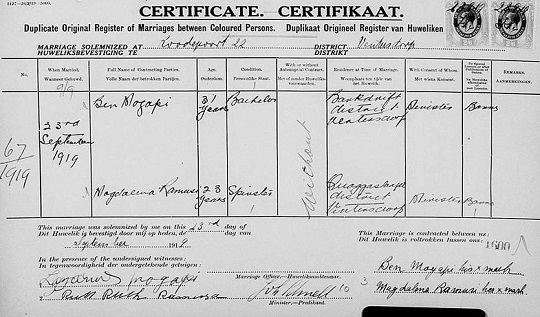
Netherlands – Open Archives has announced that they have reached the milestone of 200 million records online. Open Archives contains genealogical records from 86 different organizations. Most of the records cover the Netherlands, but due to borders changing over the decades, there are also a substantial number of Belgium records in their collection as well.
The span of records contained in Open Archives is extensive. It covers everything from birth records, baptism records, marriage records (both civil registration and church records), burial records, notarial deeds, military records and personnel legal records. Even the burial records contain over things such things as prayer cards, family messages and funeral cards, all of which can be very useful for genealogical research.
Open Archives is the largest single-source website for genealogical data from the Netherlands. For many people with Dutch ancestors, it should be the first stop on their research path.
The website gets over 200,000 visitors every month. Searches can be done by name and then filtered by type of document, place and year. Although access is by subscription, you only pay once for an Open Archives subscription. There are no monthly or annual recurring fees. [Open Archives]
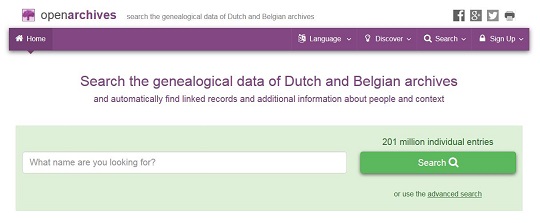
Australia – FamilySearch has created a new collection of State of Victoria inward bound passenger lists. The 1.6 million records in this new collection span the period from 1839 to 1923. The records come from two different sources “Passenger lists of unassisted immigrants to Victoria from the British Isles” and “Passenger list, arrivals in Victoria from foreign ports” both from the Public Record Office Victoria.
Most of the ships in this collection docked in Sydney.
A typical record in this collection lists the full name of the passenger, age, marital status, profession, nationality (often listed as either British, Irish or “foreign”), port of departure, date of departure, port of arrival and date of arrival.
These records can be searched by first name and last name. Access is free. [State of Victoria Historic Passenger Lists]
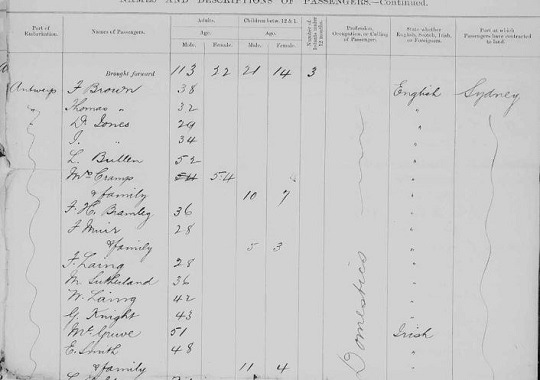
England – Findmypast has added an additional 54 million records to their electoral register record collection for England. These records span the years from 1921 to 1925.
These are basically voter registration lists. In England, these lists were updated on an annual basis. See our article Searching Electoral Rolls for Ancestors for more details on how voter registration lists can be used to trace your ancestors.
FindMyPast now has over 107 million English electoral records online. This includes a complete collection of all known electoral records from English boroughs starting with the letters A to L inclusive for the period from 1920 to 1932.
This new update is particularly important for anyone wanting to trace their English ancestors between the war years given the gap left by the destruction of the 1931 census records for England and Wales.
These records can be searched by first name, last name, year, constituency, place and county. Access is by subscription. [England Historic Electoral Records]
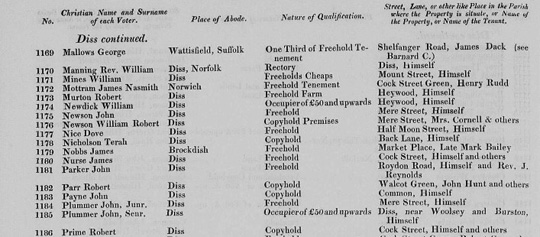
England – MyHeritage has added an index of wills and probates from England and Wales. This index contains some 10.3 million records and spans the years from 1853 to 1943. Also included in this collection are some letters of administration.
A typical probate index record in this collection lists the name of the deceased, date of death, place of residence, place of death, size of the estate, occupation and names and relationships of the next of kin. Some of these records are exclusive to MyHeritage.
This collection can be searched by first name, last name, year, place of death and keyword. Access is by subscription. [Historic England and Wales Wills and Probate Index]
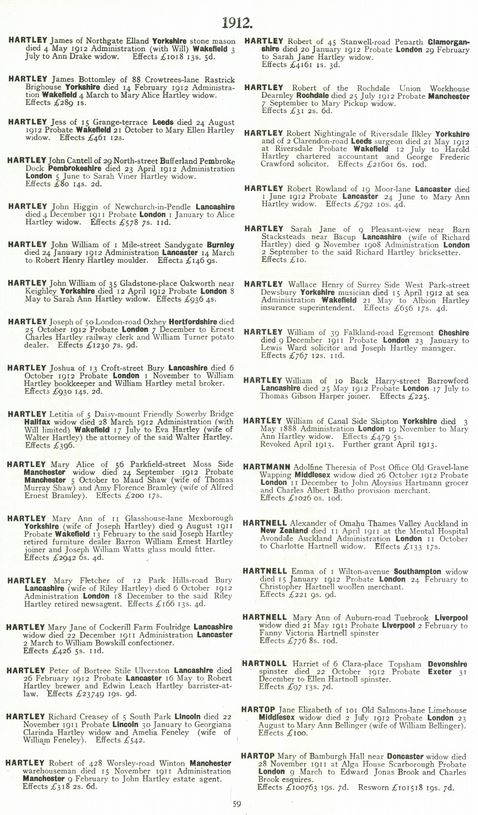
England – The website Forces War Records has announced they have reached the milestone of having over 20 million records online. For those who are not familiar with the website, it specializes in historic UK military records. The records span the period from the Napoleonic Wars (1803 to 1815) through to World War II.
Military war records are very useful resources for genealogists because they often contain considerably more information than a typical ancestral record. For example, many military records list such items as physical characteristics (height, weight, hair colour, eye colour, etc.), details on specific campaigns, reasons for discharge, next of kin, etc.
Forces War Records can be searched by first name and last name. Access is by subscription. [Forces War Records]
US – FamilySearch has put online a new collection of World War I military service records for the state of Georgia. There are approximately 100,000 records in this new collection. These records cover Georgians who served in either the US army or navy during the First World War. The records can be searched by first name and last name. Access is free. [Georgia WWI Military Service Records]
US – FamilySearch has put online some 440,000 birth records from Iowa. These records span the years from 1921 to 1942. The records come from the State Historical Society of Iowa. This is a new record collection for FamilySearch. The records can be searched by first name and last name. Access is by subscription. [Historic Iowa Birth Records]
The FamilySearch collection of Iowa death records has also been expanded by an additional 228,000 records spanning the years from 1904 to 1951. [Iowa Death Records]
US – FamilySearch has expanded their collection of Native American census rolls by some two million new records. These rolls cover the period from 1885 to 1940. Also included in this collection are some vital records. The collection can be searched by first name and last name. [Native American Census Records]
Scotland – Findmypast has added some 89,000 new burial records for Edinburgh and Lothian. A typical record lists when the person died and the location of their grave. Some records also list the spouse’s name and the names of the parents of the deceased.
These records can be searched by first name, last name, place of burial and year of burial. Access is by subscription. [Edinburgh and Lothian Burial Records]
France – FamilySearch has put online a collection of civil registration records from the ancient administration region of Calvados, France. Calvados is now part of modern-day Normandy.
The roughly 1.7 million records in this collection cover the period from 1792 to 1942 and consist primarily of birth records, marriage records and death records. This collection can be searched by first name and last name. Access is free. [Calvados Civil Registration Records]
March 2018
US – Findmypast has released a new collection of New York Roman Catholic baptism and marriage records. This release covers the Archdiocese of New York, which consists of the boroughs of Manhattan, the Bronx, Staten Island and the counties of Dutchess, Orange, Putnam, Rockland, Sullivan, Ulster and Westchester. The records in this collection span the period from roughly 1785 to 1915.
This first release covers some 1.5 million records. It is part of Findmypast’s new initiative to digitize the historical records of the Catholic Church in North America. This is big news for anyone with Catholic ancestors in North America.
In total, this new record collection covers some 230 parishes across the Archdiocese of New York, which is the second largest archdiocese in the United States. This is a very important collection not just in its own right but because many immigrants to America came through New York (for more information see Ellis Island Immigration Facts) and spent some time in the greater New York area before migrating to other parts of America. It is perfectly possible that your ancestor’s baptism or marriage church record might be in this collection.
These records can be searched by first name, last name, year, parish and father or mother’s name (in the case of baptism records) or spouse’s name (in the case of marriage records). Access is by subscription. [New York Baptism Records]
US – Findmypast has also released a collection of Chicago Roman Catholic parish records. These are baptism, marriage and burial records. The records in this collection span the years from 1843 (when the diocese of Chicago was first formed) to 1925.
Covering the Cook and Lake counties in northeastern Illinois, these records will be of interest to anyone with ancestors from the Chicago region. There are roughly 700,000 records currently in this collection. Presumably, over time Findmypast will be adding more records to this collection. These records can be searched by first name, last name, year and parish. Access is by subscription. [Chicago Baptism Records]
US – In December 2017, MyHeritage put online an extensive collection of US yearbooks that span the years from 1890 to 1979. This collection contains some 36.2 million pages in over 250,000 yearbooks. Now, MyHeritage has been able to extract all the names from these yearbooks so it is now possible for someone to search this collection by name.
A typical record in this collection will have the name of the student, their photograph and a list of clubs and academic achievements as well as the name and location of the school. Yearbook records can provide many useful facts. For example, in many cases, the catchment area for the school will provide a strong indication of the region where the student lived at the time.
Also included in this collection is information on the teachers. In addition to researching students, this collection is also worth checking out if you have a teacher in your family tree.
This collection can be searched by first name, last name, year of birth, school, school location and yearbook year. Access is by subscription. [Historic US Yearbooks]
England – MyHeritage has put online the complete 1939 Register for England and Wales. There are some 33 million records in this collection.
For those who are not familiar with 1939 Register, it was a quick survey done across the country on the eve of World War II. Much of the information that was collected in the 1939 Register is like a regular census. The information collected included (for each member of the household) full name, gender, address, date of birth, marital status, and occupation.
The 1939 Register is not protected in the same manner by UK privacy laws as the regular historic census data. This is the reason it is available now. By comparison, the 1921 England and Wales census will only go online in 2022, the 1931 census was destroyed by fire and there was no census in England or Wales in 1941 due to the war.
Basically, for anyone researching their recent English or Welsh ancestors through census-like records, the current options are just the 1911 census and the 1939 Register.
A couple of things to note about this collection. First, at the moment, MyHeritage has put up just the index to this collection (without the original images). Presumably, the images will be coming later. Secondly, there are some 42 million records in the 1939 Register but (at the moment) some 8.2 million records cannot be shown due to privacy concerns.
Basically, records are closed for anyone born less than 100 years ago (i.e. after 1918) unless they can be matched to a death record. As well, some 700,000 records are incomplete as they appear without a full name. Finally, we should note that Findmypast is the only other website that has the 1939 Register records online.
A typical record in this collection is shown below. These records can be searched by first name, last name, year of birth, residence and keyword. Access is by subscription. [1939 Register for England and Wales]
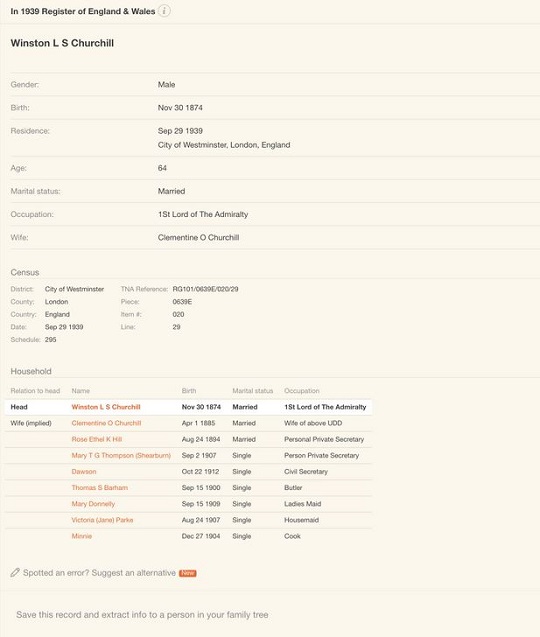
England – Ancestry.co.uk has released a collection of electoral registers for Liverpool, England. These electoral registers span the years from 1832 to 1970. Essentially, these are annual lists of all eligible voters in Liverpool. A typical record lists the name of the registered voter, occupation, address and (for pre-1918 records) a code indicating the reason why they were eligible to vote.
We have talked about electoral registers before (also referred to as electoral rolls: see Searching Electoral Rolls for Ancestors). They can be an excellent complement to census records.

There are a couple of things to note about electoral registers in the UK. First, voter lists do not exist for part of World War I (the years 1916 and 1917) and for much of World War II (1940 to 1944 inclusive). Second, prior to 1918, generally only wealthy landowners (generally one per household, if the husband was deceased, then it was the wife), some business people, high ranking military personnel and some occupations (like a doctor, including their spouse) were eligible to vote.
Starting in 1918, most men aged 21 or older and some women aged 30 or older were eligible to vote. Starting in 1928, all men and women aged 21 or older were eligible to vote.
This collection can be searched by first name, last name, year and keyword. Access is by subscription. [Liverpool Electoral Registers]
England – The British Newspaper Archive has added 235,000 historic newspaper pages from the Daily Mirror. This new addition spans the years from 1947 to 1979. The Daily Mirror was targeted towards the working class. At one time, it was England’s best-selling newspaper.
In the last month, the British Newspaper Archive has added eight new titles and expanded their holdings of many more titles. There are currently 24.2 million historic newspaper pages on the website. This vast collection can be searched by keyword, newspaper title and date range. Access is by subscription. [Historic British Newspapers]
England – FreeBMD has again updated their website with more records. This is a great website.
FreeBMD is a registered charity that aims to transcribe English and Welsh birth, marriage and death records. These official government records go back as far as 1837. The website currently has some 266.4 million records.
FreeBMD is an incredibly popular website. It typically gets more than 150,000 search queries a day. And, as the name implies, it is free. The records can be searched by first name, last name, date range, county, district and spouses name. [FreeBMD]
New Zealand – Ancestry has put online a collection of historic New Zealand police gazettes. This collection spans the years from 1878 to 1945. Basically, these are information sheets for members of the police force. In addition to providing names of police officers, they also list wanted or released prisoners, victims of crimes and missing persons.
For convicts listed in the police gazette, typical information would include the name of the convict, any alias names (very useful for genealogists tracing ancestors who used different names), age at conviction, details on the crime committed, sentence, year of birth, physical characteristics and the date of trial.
If you had an ancestor in New Zealand who was on either side of the law, then this might be an interesting collection to search. This collection can be searched by first name, last name, year of birth, keyword and trial date. Access is by subscription. [Historic New Zealand Police Gazettes]
February 2018
US – Rootstech will be held this year from Wednesday 28 February to Saturday 3 March 2018 in Salt Lake City, Utah. This is the largest annual genealogy conference in the world. Rootstech has many information sessions that are streamed live over the internet that may be of interest to our readers. The complete streaming schedule can be found here.
Sweden – The Swedish National Archives made an announcement that all their digital archives are now available to search for free. This is massive news for anyone with Swedish ancestors.
There are more than 100 million records currently online at the Riksarkivet (the name in Swedish of the national archive) with more records being added all the time. The link provides a description of why the change was made and what it means to genealogists, who apparently are the largest user of the archive. Happy hunting! [Swedish National Archive]
We should probably also mention that if you are just looking for Swedish ancestral records then you no longer have to pay a subscription website for search since Riksarkivet has by far the most complete collection.
England – TheGenealogist has added colour tithe maps for the county of Buckinghamshire. These tithe maps span the period from 1837 to 1855.
For those who are not familiar with tithe maps, in England they were created following the Tithe Commutation Act of 1836. Basically, these are highly detailed maps by parish showing the individual plots of each landowner. On the map, each landowner is clearly labelled. The landowner was responsible for making a tithe payment of one tenth of the produce from the land. For example, if the farm produced wheat, the landowner would annually pay 1/10 of the wheat crop. The payment was made to the Anglican Church.

Tithe payments were controversial for a variety of reasons, especially amongst nonconformists (those who were not members of the Church of England), who were forced to make payments to a church that they did not belong to and who had no say over how the money was spent. How tithes were paid was also inconsistent. For example, tithes paid on stands of trees and woodlots varied widely even within a single parish.
One change from the Tithe Commutation Act of 1836 is that it allowed landowners to make payments in a cash equivalent, which helped (for example) farmers who did not want to cut down their trees and churches that did not want to receive a bunch of logs.
A typical tithe record has an attached schedule that lists the landowner, the tenant, a description of the land (including any field names and identifying major buildings on the land such as barns) and what tithes were owed. If the land was later sold or subdivided (between siblings, for example) then this was also often included in the tithe record. Access to this collection is by subscription. [Buckinghamshire Tithe Records]
England – Findmypast has added more parish records from Derbyshire. These new additions of close to 400,000 records covers baptisms, marriages and burials for the parishes of Alvaston, Boulton, Chellaston, Holbrook, Longford, Newton Solney and Wilne. These records can be searched by first name, last name, year and place. Access is by subscription. [Derbyshire Parish Records]
England – TheGenealogist has added 650,000 criminal records to their website. These records cover convicts sent to Hulks (basically decommissioned ships that served as floating prisons). This would be a useful collection to search for anyone with Australian ancestors since many prisoners served time on Hulks before being shipped overseas.
Most of the records in this collection are quarterly reports on each prisoner. A typical record (see below) lists the name of the prisoner, age, offence, where/when incarcerated, sentence length, surgeon’s report on the prisoner’s heath, the behaviour of the prisoner during the quarter and how good the prisoner was at muster (on a scale from very good to very bad).
These records can be searched by first name, last name and year. Access is by subscription. [England Hulk Prisoner Records]
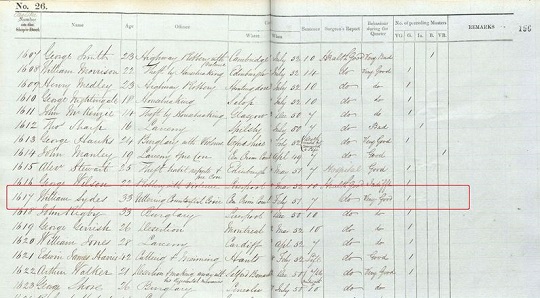
Scotland – Ancestry.co.uk has added a collection of Edinburgh electoral registers (also referred to as electoral rolls) spanning the years from 1832 to 1966. These are yearly registers listing the names of eligible voters, their occupation and their address.
Please note that early Scottish voting registers were typically limited to wealthy landowners. Only in 1918 were most males age 21 or older and women age 30 or older allowed to vote. Women age 21 or older were allowed to vote in 1928.
This is a great record set for tracking your ancestors’ movements between census dates. Please note that electoral registers were not produced during 1916, 1917 and much of World War II. These records can be searched by first name, last name, keyword and occupation. Access is by subscription. [Edinburgh Electoral Rolls]
Ireland – The Irish Genealogical Research Society has released a series of free instructional how-to videos covering various aspects of researching Irish ancestors. The online videos cover the censuses of Ireland, Church of Ireland parish records and Roman Catholic parish records. These videos are free (for a short period of time) and very useful. [Irish Instructional Genealogy Videos]
Ireland – Findmypast has added some 54,000 articles from the Dublin-based journal The Social Review. Published between 1893 and 1901, it was known as the leading journal of society and fashion in Ireland at the time. If you happen to have ancestors in Ireland who travelled in society circles or attended horse shows in the area, then you may seem them mentioned in this journal.
The Irish newspaper collection from Findmypast can be searched by first name, last name, date range, place, newspaper name, article type and keyword. Access is by subscription. [Historic Irish Newspapers]
Canada – The archives for the city of Victoria, British Columbia has launched an online search that covers various city and community records as well as nearly 10,000 digitized historic photographs of the city. The video below describes how the process works. [City of Victoria Archives]
India – Findmypast has put online the biographical and service data of some 56,000 people who worked in India for the East India Company. These records span the years from 1664 to 1961 and lists such things as births, marriages, divorces and deaths. Also included are relocations, will probates and residential addresses of various employees of the East India Company.
This collection can be searched by first name, last name, year, location, spouse’s name and parent’s names. Access is by subscription. [East India Company Employee Records]
Turkey – The Turkish government has launched an “e-government portal” that allows Turkish citizens to research their ancestors. Records on this website go as far back as the Ottoman empire in the early 1800s.
This website has become hugely popular in Turkey. It has already received millions of inquiries. Apparently, one unexpected outcome is that many people in Turkey are finding out that some of their ancestors were not as Turkish as they thought. The database has shown that many Armenians, Syriacs, Greeks and Jews over the decades were forced to convert to Islam. This will be an interesting database to search, particularly for those with Armenian ancestry. [Turkish Government Genealogy Database]
Panama – FamilySearch has indexed some 265,000 Catholic Church records from Panama. These records, which span the years from 1707 to 1973, are primarily baptisms, parish censuses, marriages and burial records. These records can be searched by first name and last name. Access is free. [Panama Genealogy Records]
Russia – FamilySearch has indexed some one million records from church books of the Russian Orthodox Church in the province of Samara. Samara is in the southwestern part of Russia near the Volga river. The records in this collection span the years from 1779 to 1923. The records consist of births, baptisms, marriages, deaths and burials. This is a rare collection from Russia and well worth checking out if you have ancestors from the region.
In Russia, the Orthodox Church was responsible for keeping both civil and religious records. The format of each record type was standardized in 1724. By 1806, each record was written on a standard form. This format continued until the 1930s (i.e. into the Communist era). It is thought that these records covered approximately 70% of the local population pre-1800 and 90% of the population after 1800. The most likely people not covered by these records would have been those from other religions.
Russian church records are usually very reliable. The records can be searched by first name and last name. Alternatively, you can browse through the 1.9 million images in this collection (not all the images have been indexed yet). Access is free. [Historic Samara Ancestral Records]
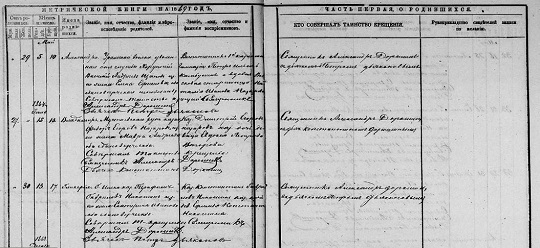
US – MyHeritage has added a collection of US high school and college year books to their holdings. In total, this new collection consists of some 36.2 million records coming from over 250,000 yearbooks. The records in this collection span the years from 1890 to 1979.
Yearbooks are an interesting record source for genealogists because most yearbooks contain a photograph of your ancestor as well as personal information (such as club memberships and sports associations) that is often not found in other genealogy records. In other words, yearbooks can provide a unique way of looking at your ancestors.
With this massive update, MyHeritage has created one of the largest US yearbook collections in existence. This collection can be searched by first name, last name, school, year, location and keyword. Access is by subscription. [US Yearbook Collection]
US – MyHeritage has added a large collection of historic Indiana newspapers. This new addition consists of some 1 million pages across 44 different Indiana newspapers. The articles span the years from the 1847 right up to 2009.
According to MyHeritage, this newspaper collection is exclusive to their website. This collection can be searched by first name, last name, newspaper title, keyword, place and date. Access is by subscription. [Historic Indiana Newspapers]
US -MyHeritage has added 4.6 million pages of historic newspapers from the state of Ohio. This collection spans the years from 1793 to 2009 and comes from 88 different newspapers within the state.
According to MyHeritage, this newspaper collection is also exclusive to their website. This collection can be searched by first name, last name, newspaper title, keyword, place and date. Access is by subscription. [Historic Ohio Newspapers]
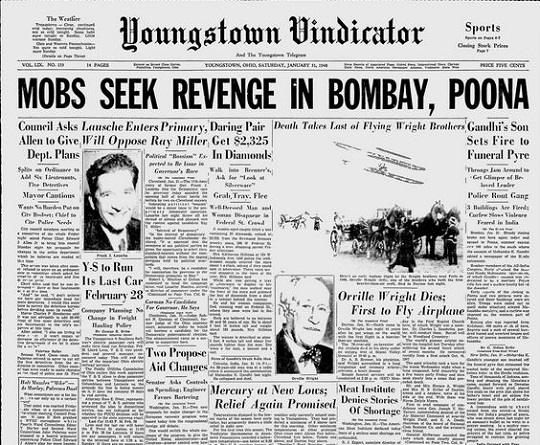
US – MyHeritage has added an historic newspaper collection from Pennsylvania. The 7.5 million newspaper pages come from 70 different newspaper titles in the state. The newspapers span the years from the 1795 up to 2009.
According to MyHeritage, this newspaper collection is also exclusive to their website. This collection can be searched by first name, last name, newspaper title, keyword, place and date. Access is by subscription. [Historic Pennsylvania Newspapers]
Sweden – MyHeritage has put online about 38.5 million new records from Swedish household examination books. We have talked extensively about household examination books in the past. Basically, they are records from the Swedish Lutheran Church. The parish priest would visit each household once a year and record the vital statistics of each member of the family. This would include such things as recent births, marriages and deaths.
In some ways, Swedish household examination books serve as a basic form of census for the country (the Swedish Lutheran Church actually was the formal census taker for the country right up until 1991).
If you are looking for Swedish ancestors who emigrated from the country, these household examination books can be a vital tool in narrowing down the window when your ancestors left the country (by determining what year they were no longer listed in the examination books).
Most people are familiar with searching the Swedish household examination books through FamilySearch, which is free (here is the link). However, FamilySearch’s collection spans the years from 1880 to 1920. What is nice about this collection from MyHeritage is that it covers two different time periods that are currently not covered by Family Search, namely 1860 to 1880 and 1920 to 1930 in addition to covering the same 1880 to 1920 time period as FamilySearch. In total, there are some 84 million records in this collection.
This collection from MyHeritage can be searched by first name, last name, year of birth, place, residence and keyword. Access is by subscription. [Swedish Household Examination Books]
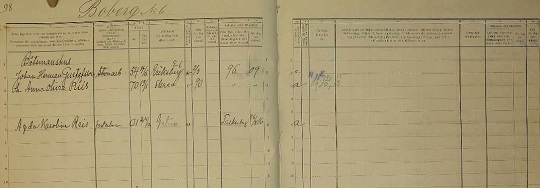
England – FamilySearch has added 640,000 more Derbyshire parish records to their collection. These records span the years from 1537 to 1918 and consist of baptisms, marriages and burial records. These records can be searched by first name and last name. Access is free. [Derbyshire Parish Records]
England – FamilySearch has added 640,000 more parish records from Warwickshire. These are baptism, marriage and burial records that span the years from 1537 to 1918. These records can be searched by first name and last name. Access is free. [Warwickshire Parish Records]
Germany – MyHeritage has put online the German minority census of 1938-1939. This is the second of two Nazi-mandated censuses (the first one was in 1933) and it was conducted around the start of World War II. It specifically lists all individuals who lived in a German household where at least one person in the household had a Jewish grandparent.
A typical record in this collection lists the first name, last name, date of birth and place of birth of the person. It then lists various race-based questions about both maternal and paternal grandparents. Questions were also asked about the level of education and whether there were any family members who resided outside the house. Please note that this census was the basis for a national card catalog of German Jews. As such, it may be emotionally difficult for some people to research this census.
Some 411,000 individuals are listed in this census. It can be searched by first name, last name, year or place of birth and keyword. Access is by subscription. [Germany 1939 minority census]
Palestine – MyHeritage has put online a unique collection of Mandatory Palestine naturalization applications. These are basically records of individuals (mainly Jews) who tried to establish citizenship in Mandatory Palestine between 1937 to 1947. There are over 200,000 records in this collection.
These records can be searched by first name, last name, year of birth and naturalization year. Access is by subscription. [Mandatory Palestine Naturalization Applications]
January 2018
Scotland – Now that it is 2018, a new batch of records can be legally released on the website ScotlandsPeople. Births in 1917, marriages in 1942 and deaths in 1967 have now gone online. In total, some 233,000 new records have been added to ScotlandsPeople.
It is interesting to note that births in Scotland in 1917 touched the lowest level since 1856 due to the disruptive effect of the ongoing First World War and the number of men who were away from home.
On the other hand, marriages in 1942 were reasonably strong even though it was the middle of World War II. Many foreign servicemen were stationed in Scotland that year. Some ended up marrying local Scottish women.
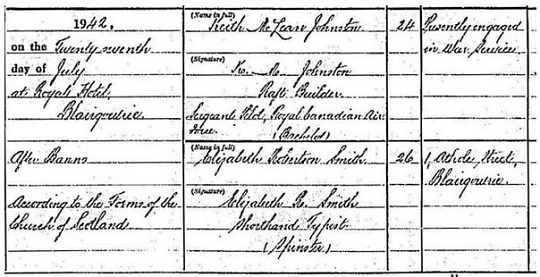
The ScotlandsPeople records can be searched by first name, last name and year range. ScotlandsPeople is the official genealogy website of the Scottish government. It is run by brightsolid, the same company that owns Findmypast. Access to ScotlandsPeople is by subscription. [ScotlandsPeople]
Canada – Library and Archives Canada (LAC) has launched a new beta search tool. The objective of the new tool is to consolidate searching across all the available databases into one stand-alone search box (unlike the current system, which largely requires the user to search each database individually).
More details about the Collection Search (beta) can be found here. At the moment, the key genealogy databases (such as census records) are not covered by the new beta search. Hopefully, that will change in the not-to-distant future.
LAC is looking for feedback on their new search functionality. This is an opportunity for the voice of the genealogy community to be heard. Personally, we would like to see the LAC databases opened up to external search engines, like Google and our own free Genealogy Search Engine. That would be a big win for genealogists. [Library and Archives Canada Beta Search]
US – The website TheGenealogist, which has traditionally focussed on UK genealogy records, is becoming more involved with US records. They have added over 5 million ship passenger records for people that migrated to the US between the years 1834 to 1900. Included in this update are almost 4 million people who migrated from Germany (1850 to 1897), some 835,000 people who migrated from Italy (1855 to 1900) and about half a million people who migrated from Russia (1834 to 1897).
TheGenealogist records can be searched by first name and last name. Access is by subscription. [US Ship Passenger Records]
US – FamilySearch has added some 667,000 more indexed records to their collection of California births and deaths. These records span the years from 1800 to 1994. These records have been acquired from various county courthouses.
One interesting (and rare) thing about California birth records is that they often list the number of existing children in a family. They also list the legitimacy of the newborn child. This collection can be searched by first name and last name. Access is free. [California Birth Records]
US – This is an advance notice. Michigan State University has received a grant of nearly $1.5 million from the Andrew W Mellon Foundation “to create a unique data hub that will change the way scholars and the public understand African slavery”.
The idea of this new data hub is that it will effectively link multiple collections spread across several universities. This will give people the ability to search and identify individuals and their descendants from one central source. This could become a powerful new tool for anyone with African American ancestry. Here is the complete press release.
England – Findmypast has increased their collection of Hertfordshire parish records. Included in this update are 87,000 new baptism records, some 62,000 new marriage records and around 66,000 new burial records.
Each record contains a digitized image of the original document and a transcript. The records can be searched by first name and last name. Access is by subscription. [Herefordshire Baptism Records]
England – Findmypast has added over 3 million new newspaper articles and 11 new titles to their British newspaper collection. Some of the new titles that may be of interest to our readers include the Bristol Daily Post, the Bristol Magpie the Isle of Wight Times, the Leicester Herald and the Reading Observer.
Findmypast’s newspaper collection can be searched by first name, last name and keyword. The search can be further refined by newspaper title and date range. Access is by subscription. [Historic British Newspaper]
South Africa – FamilySearch has created a new indexed record collection containing a register of slaves in South Africa. This collection spans the years from 1762 to 1838 and comes from slave registers in Cape Province.
A typical record in this collection lists the name of the slaveholders and the name, sex, age, homeland and occupation of each slave or servant. Also included in this collection is information on slave transfers, inheritances of slaves as well as information on slave births, marriages and deaths. Access is free. [South Africa Slave Register]
World – The free website Rootsweb (owned and run by Ancestry) has gone offline. It may be offline for a “few months” to quote the website. Below is a snapshot of the announcement posted on the Rootsweb website as of 9 January 2018.
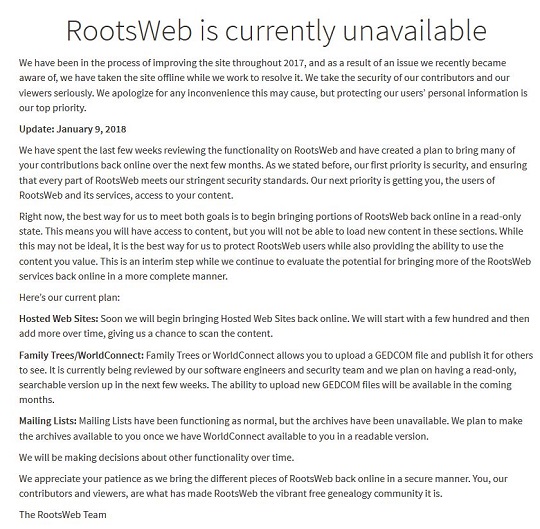
This announcement vaguely references security issues without providing any details. In our opinion, if a user’s security has been compromised, they should do what all other companies do and contact any potentially affected users. If individual user’s security have not been compromised, then why not provide details about the security problem? Very strange.
If you need to access Rootsweb, we might have a possible work-around for you. We say might because it worked when we tested it, but it might not work going forward (we can’t control this since Rootsweb is not our website). Go to the Family Tree Search Engine and start your search query with the following [site: rootsweb.com] - don't include the square brackets - and then add to this whatever you would normally put in your Rootsweb search.
This is essentially an indirect way into the website since our search engine has indexed Rootsweb (along with many other free genealogy websites).
In spite of the public message from Rootsweb, it looks like they have kept at least some of their website up. Go figure.
We talked about Rootsweb last year in this space when it was clear that Ancestry’s commitment to the website was wobbling. At that time, GenealogyInTime Magazine warned our readers to play it safe and get their data off this website. We hope you took our advice!
Jersey – Findmypast has put online parish records from the island of Jersey. Officially called the Bailiwick of Jersey, it is technically not part of England. These parish records consist of baptism, marriage and burial records from the Church of England.
In total, there are some half million records in this collection. The records start in 1540 and for the baptism records go up to 1915. The marriage and burial records go up to 1940. The burial records cover 17 different sites across the island.
This collection can be searched by first name, last name, year and place. Access is by subscription. [Historic Jersey Baptism Records]
England – Findmypast has put online some 1.7 million baptism records from the Greater Manchester region. These records span the years from 1571 to 1910 and are from the Diocese of Manchester. Most of the parishes in this collection are from the county of Lancashire.
Each record contains a transcript (and in many cases a scanned image) of the original document. These records can be searched by first name, last name, year, place and mother and father’s first name. Access is by subscription. [Historic Manchester Baptism Records]
England – Findmypast has put online an additional 613,000 baptism records from various Wiltshire parishes. The records span the years from 1538 to 1917. These are Church of England parish records, although most other denominations are also included in this collection (except for Quaker and Jewish records). Access is by subscription. [Historic Wiltshire Baptism Records]
England – TheGenealogist has added some 366,000 parish records from Warwickshire. These are baptism, marriage and death records. TheGenealogist has put together an interesting article covering some of the more colourful characters found in this collection. They also have a sample screen shot of the information contained in a transcribed record in this collection for those who are not familiar with the website. Access is by subscription. [Warwickshire Parish Records]
England – Findmypast has put online the cemetery records for Brompton cemetery. Brompton cemetery was opened in West London in 1840 on the western border of Chelsea and Kensington. It is one of the so-called magnificent seven cemeteries that were established around London in response to a shortage of burial spaces in the city (at the time, church yards in London were no longer allowed to be used for burial purposes due to a variety of reasons, including health reasons).
There are some 205,000 people buried at Brompton cemetery. For many names, there are two records: a burial record and a grave purchase record. These records can be searched by first name, last name and year. Access is by subscription. [Brompton Cemetery Records]
December 2017
World - Thinking of doing an ancestry DNA test this holiday season? Wondering how accurate they are?
Check out the following video from the Today Show, which actually tested the accuracy of three of the most common DNA test kits by cleverly using identical triplets. These women happen to have different last names, so the test companies would not have known that they were related to each other.
Here are the three DNA companies listed in the video [Ancestry DNA] [23andMe][MyHeritage DNA] Another popular DNA company is [FamilyTreeDNA]
Finally, these days you can even DNA your dog to see to determine the breed. [DNA My Dog]
UK – TheGenealogist has released 2.7 million ship passenger records from the 1930s. These are outbound passenger records for ships that departed United Kingdom ports between 1930 and 1939. These records come from the National Archives (BT27 series).
Typical records in this collection list people travelling to America, Canada, India, New Zealand and Australia as well as several other ports around the world. A typical record lists the name of the ship name, passenger name, their age, last known address in the UK, port of departure, port of arrival and where the passenger intended to make their permanent residence.
With this latest addition, TheGenealogist now has over 19 million emigration records from the UK dating as far back as 1896. Access is by subscription. [UK Emigration Records]
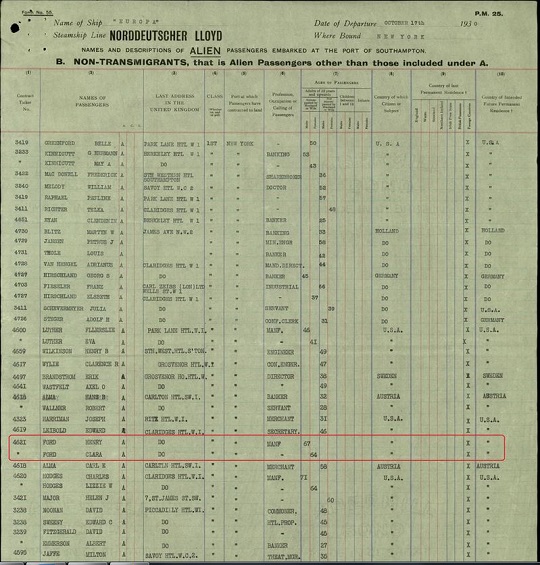
US – FamilySearch has indexed an additional 73,000 records from Fulton County, Georgia. These records come from the Atlanta History Center and include cemetery records, local censuses (going as far back as 1885), vital statistics related to births and deaths and other miscellaneous records. This collection spans the years from 1827 to 1955.
Fulton County covers the state capital of Atlanta. The records in this collection can be searched by first name and last name. Access is free. [Fulton County Genealogy Records]
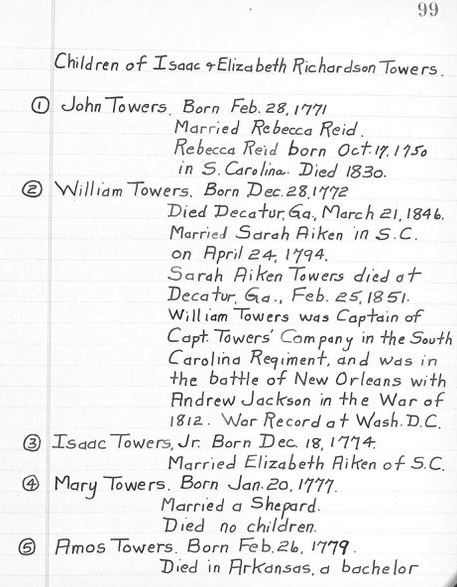
Ireland – An online petition is circulating from the Council of Irish Genealogical Organizations (CIGO) asking the current Irish government to renew the commitment of the previous government for the early release of the 1926 census. In case any of our readers are interested in signing up….[Release of the 1926 Irish Census]
Ireland – The Irish Newspaper Archive continues to add more historic newspapers to their collection. The latest addition includes the Belfast Newsletter (1939 to 1949), which was the first newspaper published in Belfast (first published in 1738). The Irish Newspaper Archive now has over nine million pages of newspaper content from north and south of the Irish border.
For those who are not familiar with the Irish Newspaper Archive, the video below describes the process. Access is by subscription. [Irish Newspaper Archive]
Denmark – FamilySearch has indexed and put online some 1 million records from the Danish 1834 census. This is a new record collection. FamilySearch has also added an additional 51,000 records from the Denmark 1840 census and an additional 961,000 records from the Denmark 1925 census. Access is free. [Denmark 1834 Census]
Canada – Ancestry.ca has recently updated a total of 25 record sets related to their Canadian ancestry databases. In aggregate, there are some six million new records that have gone online. The most substantial updates include New Brunswick birth (1810 to 1906), marriage (1789 to 1950) and death (1888 to 1938) records; Newfoundland birth/marriage/death records (1757 to 1949) and Newfoundland census (1921, 1935, 1945) records. Access is by subscription. [Ancestry.ca]
US – Findmypast has put online a new collection of ship crew lists for Boston. This collection spans the years from 1917 to 1943 and comes from the National Archives and Records Administration (NARA). Note: these are ship crew lists, not passenger lists.
A typical record in this collection lists the full name of the crew member, age, sex, year of birth, place of birth (or nationality) and ship. A transcript of the original record is also available. These records can be searched by first name, last name and ship name. Access is by subscription. [Historic Boston Ship Crew Records]
US -The Federation of Genealogical Societies and the website Fold3 have put online additional pension records from the War of 1812. This latest addition covers the last names from M(Moore) to Q.
As described on the Fold3 website, “This series consists of approximately 180,000 pension and bounty land warrant application files relating to claims based on service between 1812 and 1815. The files generally contain documentation submitted in support of a claim, such as the original application form, affidavits, and statements from witnesses.”
A typical file lists the veteran’s name, age, place of residence, widow’s name, date of marriage, military service, date of the veteran’s death, etc.
For those who are not familiar with Fold3, they are an ancestral record website that specializes in historic US military records. Fold3 is owned by Ancestry. It is a subscription website, but for this record set access is free. [War of 1812 Pension Application Records]
England – TheGenealogist has started the process of putting online a very detailed street survey of London, England from 1910. Known as the Lloyd George Domesday Survey, it is a series of maps of where people lived in the city. The maps go right down to showing individual street addresses.
Trying to trace an ancestor’s London address using modern maps is a major challenge that can often lead to incorrect results. Vast parts of the city were destroyed and rebuilt after World War II (especially anything east of Regent Street).
Streets and addresses were often changed in the rebuilding process, sometimes quite substantially. For example, lanes, streets and roads were razed, moved, combined or renamed. Whole areas were converted from single homes to residential blocks and office buildings. Streets were often renumbered. The list of challenges goes on and on.
Even if you know the address of your ancestor and you think you have found that address on a modern London map, it does not guarantee that the location is the same location as it was back in 1910.
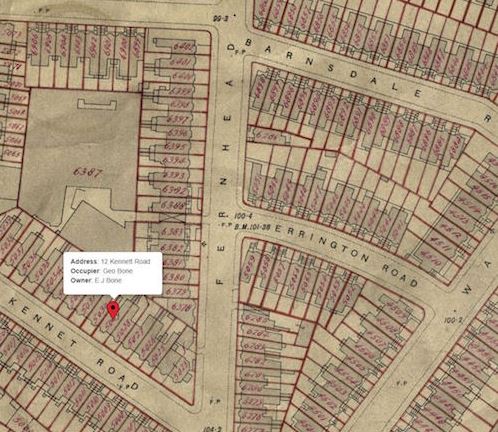
TheGenealogist now allows you to do the following:
• Locate your ancestor’s address using old census data or historic street directories.• Find the exact location of the address using the detailed maps from 1910.
• Get basic information about the address, such as the valuation assessment number, map reference, name of owner, name of renter and other descriptions about the property.
TheGenealogist has just begun the process of digitizing some 94,500 books containing all the detailed information on each property in the city of London. These books come from the National Archives.
The video below provides more background on this large project.
This collection can be searched by first name, last name and keyword (like a street name). Access is by subscription. [London 1910 House Survey Maps]
England – Findmypast has put online a collection of parish records from the Catholic Diocese of Westminster. This consists of 94,000 baptism records, some 13,000 marriage records and roughly 9,000 burial records. Findmypast has not identified the date range for this collection.
The Catholic Diocese of Westminster basically covers London north of the River Thames and west of the River Lea. This collection can be searched by first name, last name, parish and year range. Access is by subscription. [Westminster Baptism Records]
November 2017
World – Starting 13 December 2017, all users of the FamilySearch.org website will have to use a registered account to access the records on the website. Previously, users could access many of the functions of the website without having to log in. The change was prompted by some of FamilySearch’s partners, who have insisted on authenticated accounts before providing data to FamilySearch.
The need to have a login should not affect many of our readers as most already have an existing account, which you can continue to use.
FamilySearch’s privacy policy has also not changed. They still do not share any personal information with third parties without the user’s consent. The most important point though is that the website will continue to remain free.
If you need to register for an account, use this link. If you want more background information about the registration process (including your privacy rights), use this link.
Denmark – FamilySearch has put online the 1930 Danish census. There are some 3.6 million records in this collection.
The 1930 Danish census was actually taken on 5 November 1929. The information varies in each census record depending on where the person lived in the country. Essentially, there were three schedules – one for rural residents, one for city residents, and one for Copenhagen residents.
The information common for all records includes the full name of the person, where they lived, whether they were present the night of the census, sex, date of birth, place of birth, occupation and relationship to the head of the household. Marital status and citizenship were also included in the rural and city schedules (but oddly enough, not for the Copenhagen schedule).
The digitized images for this collection come from MyHeritage. The original records come from the National Archives of Denmark. The records can be searched by first name and last name. Access is free. [Denmark 1930 Census]
Denmark – FamilySearch has significantly increased their collection of Danish church records. Some 18.7 million additional indexed records have recently been added to the collection, which spans the years from 1484 to 1941.
These church records are mainly baptism, marriage and death records. It is interesting to note that in Denmark, baptism records listed the mother’s maiden name, marriage records listed the address of the couple and death records listed both the date of death and the date of burial.
These records can be searched by first name and last name. Access is free. [Historic Danish Baptism Records]
US – FamilySearch has put online an interesting collection of grave registrations for armed forces personnel in Iowa. These records span a broad date range from 1835 to 1998. The records come from the Iowa State Historical Society. They can be searched by first name and last name. Access is free. [Iowa Military Grave Records]
US – FamilySearch has added another one million indexed records to their 1895 New Jersey state census collection. This is an important collection because many immigrants who arrived at the port of New York would often live in New Jersey for a year of two before heading off to other parts of America (see Ellis Island Immigration Facts). Bottom line: your ancestors may have spent some time in the state.
This collection can be searched by first name and last name. Access is free. [New Jersey 1895 State Census]
England – This is an advance notice. The British Newspaper Archive website will be digitizing and putting online the historic archives of Trinity Mirror. Trinity Mirror is Britain’s largest newspaper group.
The digitization project will consist of over 12 million pages of historic newspaper content. It is expected to take roughly two years to complete the digitization process and put the content online.
The British Newspaper Archive currently has some 22.5 million pages of historic newspapers online. This latest digitization push will increase the content held by the website by roughly 50%. It will also significantly increase the twentieth century content as the oldest newspapers held by Trinity Mirror only date back to the era of Queen Victoria.
There are some 320 newspaper titles in the Trinity Mirror archive, with the titles spread geographically throughout the country. The two most notable titles in the collection are the national papers The Daily Mirror (founded in 1903) and The Daily Telegraph (founded in 1855). Also included in the holdings of Trinity Mirror are the Birmingham Post and Mail and the Liverpool Daily Post.
We will keep our readers up to date as we get more details on when certain titles get digitized and go online. [British Newspaper Archive]
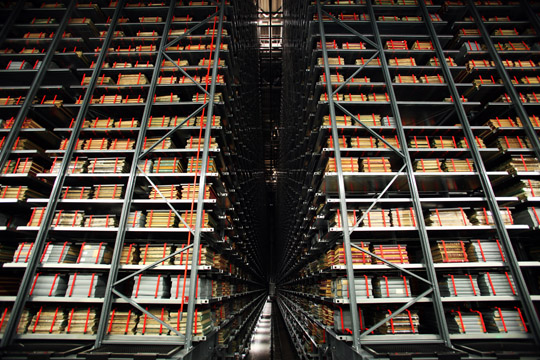
England – Findmypast has put online World War I British army medical records. These are records for soldiers who were wounded and treated during the war. The collection of some 212,000 records includes admission and discharge records from hospitals, field ambulances and casualty clearing stations.
This collection can be searched by first name, last name, year, rank, service number and hospital. Access is by subscription. [British Army World War I Medical Records]
England – Findmypast has put online a collection of some 14,000 records related to exemptions from military service sought by residents of Hampshire in World War I.
The British Empire entered World War I on 4 August 1914. The war dragged on much longer than most people had expected. On 2 March 1916, the British government passed the Military Service Act, which automatically enlisted all able-bodied single men between the ages of 19 and 41 into military service. Two months later, the age was dropped to 18 and automatic enlistment also covered married men.
Certain occupations considered vital to the war effort were exempt from military service. Men could also petition a military tribunal for an exemption based on health, family hardship, potential business damage or as a conscientious objector.
In World War I, few men were successful in claiming a conscientious objector status (only about 16,500 for the entire country for the entire war). Quakers, however, were prominent in this group.
This is an interesting record collection to search if you had ancestors living in Hampshire during World War I. The records can be searched by first name, last name, year of birth and keyword. Access is by subscription. [Hampshire World War I Military Tribunal Records]
Croatia – FamilySearch has indexed an additional 42,000 records from their Delnice Catholic Church collection. Delnice is a town in western Croatia about 40 kilometers from Rijeka.
These are baptism, marriage and death records that span the years from 1725 to 1926. The records in this collection can be searched by first name and last name. Access is free. [Historic Delnice Baptism Records]
Canada – FamilySearch continues to add more records to their collection of Canada passenger lists. These lists cover the period from 1881 to 1922 and the latest additions add a further 33,000 records to the collection.
This collection can be searched by first name and last name. Alternatively, you can browse through the 145,000 images in the collection, which are organized by port of arrival and month/year. Access is free. [Historic Canada Passenger Lists]
US – The Troy Irish Genealogy Society in Troy, New York continues to add new records to their online collection. The latest additions are transcripts of headstones from St Agnes cemetery in Menands, New York.
Most headstones list such things as full name, date of birth and date of death of the deceased. Also, many headstones are shared with the spouse and other family members, so this information will be available as well.
The city of Troy is on the banks of the Hudson River just north of Albany, the capital of New York State. It was once a popular stop for Irish immigrants, who were drawn to the area by its steel making and shirt making facilities. The population of Troy today is roughly the same as it was 100 years ago. Access to the online records of the Troy Irish Genealogy Society is free. [Troy New York Genealogy Records]
England – TheGenealogist has added to their collection of English parish records. The latest additions include some 140,000 records from Worcestershire and Warwickshire. This latest addition are all baptism records from the Malvern Family History Society.
TheGenealogist has an ongoing project where they work with several family history societies in England to bring transcribed ancestral records to the internet. Some of these records are not available from other online sources. Access is by subscription. [TheGenealogist]
Canada – The Canada 1921 census is now available for free on the Library and Archives Canada (LAC) website.
Several years ago, LAC signed a contentious contract with Ancestry whereby in exchange for Ancestry taking the time to digitize and transcribe the Canada 1921 census (or more specifically, the microfilm of the census), Ancestry had the exclusive rights to put the census records on their subscription website for a period of four years starting in August 2013. Now four years later, LAC has put the records on their website.
With some exceptions, national censuses in Canada are done every ten years. The Canada 1921 census was the sixth national census and it follows the one taken in 1911. One big advantage of the 1921 census is that it asks questions about the birthplace of both parents.
The 1921 census was taken on 1 June 1921. At that time, Canada had a total population count of 8,788,483 people, or about 25% of the country’s population today.
One thing to note with this collection is that the original records from the 1921 census were destroyed when the records were transferred to microfilm back in 1955. The quality of these microfilm images varies enormously, and the odd image is (unfortunately) unreadable.
These records can be searched by first name, last name, age, province and keyword. If you cannot find your ancestors by searching by name (we had this problem), you might want to consider scanning the images by location if you happen to know where your ancestors lived. Alternatively, try searching for your ancestors by alternative name spellings (the Ancestry translation was not always the best). See the LAC website for more details. Access is free. [ Canada 1921 Census]
October 2017
Australia – FamilySearch.org has created a new record collection of South Australia immigrant ship papers. So far, some 200,000 records have been indexed.
This collection spans the years from 1849 to 1940 and consists mainly of passenger lists for both arrivals and departures from South Australia. A typical record lists the ship’s name, name of the passenger, age, sex, occupation, nationality, date, port and the destination. The original records come the State Records of South Australia.
These records can be searched by first name and last name. Access is free. [South Australia Immigrant Ship Records]
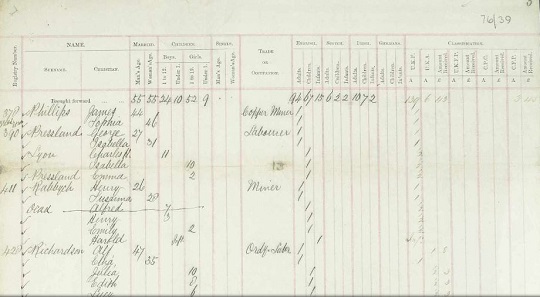
England – Findmypast has put online baptism, marriage and burial records from Portsmouth Hampshire. These records come from the city-owned Portsmouth History Centre and are being put online for the first time.
The roughly 555,000 baptism records, some 379,000 marriage records and 312,000 burial records go as far back as the 16th century to as recently as 1917. The records cover the deaneries of Portsmouth, Gosport, Fareham and Havant. Each record consists of a transcript of the record plus an image of the original document. Of note, the baptism records include not just the names of the parents, but their place of residence as well.
Most of the records in this collection come from the Anglican Church. Some records in the collection also come from other denominations such as Congregational, Presbyterian, Roman Catholic, Unitarian, United Methodist and Wesleyan Methodist. The records can be searched by first name, last name, year, place and type of record. Access is by subscription. [Portsmouth Baptism Records]
If you have ancestors from the region and are interested in knowing what genealogy records exist for Portsmouth, you might want to consider consulting this handy guide to Portsmouth genealogy records.
World – Many people will be familiar with RootsWeb, one of the true granddaddies of genealogy websites. For many genealogists, RootsWeb was their first online introduction to ancestral research. In addition to being free, RootsWeb is packed full of records, online forums and resources to help people find their ancestors.
RootsWeb was purchased by Ancestry in June 2000. For the last several years, the website has been in slow decline. Much of the information on RootsWeb has not been touched or updated for years.
Two recent official messages posted by RootsWeb may be disturbing to some users of the website.
The first message from RootsWeb was forwarded to us by one of our readers. It stated the following:
As you know, RootsWeb is a collection of products that has grown organically over the last two decades. Many of these have not been updated or maintained in years. Ancestry is currently working on updating and revising World Connect, Mailing Lists, and hosted sites such as Free Pages over the next twelve months; however, all other products and functionality are under review. We will continue to notify you of updates here as decisions are made.
The second (more recent) official message from RootsWeb was the following:
In an ongoing effort to focus RootsWeb resources on World Connect, Mailing Lists and hosted sites such as Free Pages, we are retiring features that are not heavily used and have not been maintained over the years.
On Nov 6th, we will be retiring Surname Helper (http://surhelp.rootsweb.ancestry.com)
Thanks you for your support and patience as we work at improving RootsWeb.
It is hard to know what Ancestry plans to do with RootsWeb. One possibility is that Ancestry may have begun the process of “sunsetting” the website. For those who are not familiar with the term sunsetting, on the internet it refers to the practise of slowly allowing features on a website to decline to the point where the website itself eventually disappears.
Over the years, Ancestry has sunsetted or killed off several of their unprofitable websites (anyone remember genealogy.com, or for that matter Family Tree Maker?)
Our suggestion for anyone using the records on RootsWeb: back up the data before it disappears.
Also, it is probably not a bad idea to start looking for alternative web sources for whatever other features or tools you may have used on RootsWeb. You have been warned… [RootsWeb]
Sweden – FamilySearch has created a new collection of historic Swedish household examination books. For those who are not familiar with household examination books, these are records from the Swedish Lutheran Church.
The parish priest would visit each household roughly once a year and record vital statistics on the household. This would include such things as members of the household and any recent births, marriages and deaths. In a sense, these household examination books served as a type of basic census for the country. In fact, the Swedish Lutheran Church was the official keeper of census records on the Swedish population until 1991.
The initial release of this collection contains over 87,000 images. Over one million records from these images have already been indexed. The collection spans the years from 1880 to 1920, which is the key period when many Swedes emigrated from the country.
Since Swedish household examination books were essentially a yearly survey of the local population, tracing your ancestors to the last time they were mentioned in this collection can help narrow down the time frame when they may have migrated to the new world.
The images in this collection are difficult to browse because they are organized by film number, not place. The records that have already been indexed, however, can be searched by first name and last name. At a minimum, each record lists a person’s name, date of birth and place of birth. Family relationships are also often listed. Access is free. [Swedish Household Examination Books]
Please note when looking at the older records in this collection (i.e. pre-1895), the parish priest would also record household member’s knowledge of the basic principles of Christianity (i.e. catechisms).
South Africa – FamilySearch has added additional indexed records to their collection of civil deaths from Cape Province. The new additions span the period from 1895 to 1972. In addition to searching by first and last name, you can also scan the 2.2 million images in this collection.
The images are organized by year of death and then by municipality. These records come from the National Archives of South Africa and contain a considerable amount of information, such as place of birth, intended place of burial, cause of death and residence. Access is free. [Cape Province Death Records]
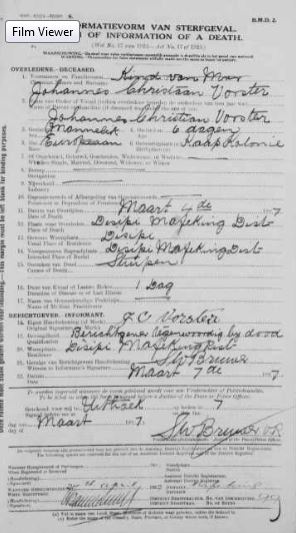
US – Reclaim the Records has added the New Jersey marriage index from 1901 to 2016 to their website. This is an image of the index. It is not yet text searchable. You need to download the appropriate pdf document and go through it manually. The index is organized alphabetically by the bride’s maiden name. Most years also have a groom’s index.
Since this new addition covers such a broad date range, it is not surprising that the information contained in the index varies greatly through the decades.
Reclaim the Record has over 20 million records on their website. Access is free. The website also now accepts donations to help cover the cost of their record requests to various governments. In fact, if you scroll down their home page you can see a list of everything that they are currently working on. [Reclaim the Record]
Like many of the record sets added by the website Reclaim the Records, this one came with a big fight with the government. You can learn more about what Reclaim the Records does by watching the video below.
Canada – Findmypast has added over 334,000 additional records to their Ontario birth index. This collection now contains more than two million records. The new additions span the years from 1860 to 1920.
Each record lists the person’s name, date of birth, place of birth and both parents’ names. Sometimes additional information is given, such as the parents’ occupation and place of residence. An image of the original record is also available. This collection can be searched by first name, last name, year of birth and parents’ names. Access is by subscription. [Ontario Birth Index]
England – Findmypast has put online a small collection of bastardy records from Warwickshire. Bastardy is a contemporary term that historically meant a child born outside of marriage. Bastardy records are hard for genealogists to find because they were usually administered by a court. However, they are very important for tracing ancestors who were born out of wedlock, which was not an uncommon experience. The records in this collection span the years from 1844 to 1914.
Bastardy records in England were administered by petty courts. The purpose of a bastardy record was for the mother to ask the court for an order compelling the father to pay child maintenance. The mother was responsible for providing evidence of paternity. In the days before DNA testing, this was done primarily through witness statements by people who were aware of the relationship between the two individuals. Fathers who failed to pay maintenance were imprisoned.
A typical record in this collection lists the name of the mother and the name of the father. Unfortunately, it does not list the name of the child. These records can be searched by the mother’s first name and last name. Access is by subscription. [Warwickshire Bastardy Records]
England – TheGenealogist has put online the British army index for the years 1851, 1861 and 1871. This is essentially a list of all British soldiers worldwide that was compiled from various muster lists.
This collection is essentially the equivalent of a military census for the British army. It serves as a nice substitute for the real census if your ancestors served in the military and you are having difficulty finding them because they tended to move around.
Also included in this collection are recruitment records, lists of boy soldiers and bandsmen. As well, civilians who worked for the armed forces are also listed. Typical civilian positions included clerks, pension recruiters and teachers.
There are some 600,000 records in this collection. Many records list additional details such as place of birth of the soldier and former occupation. These records can be searched by first name, last name, service number and regiment. Access is by subscription. [British Army Index]
TheGenealogist has also prepared a background article on this topic.
Scotland – ScotlandsPeople has released the 1935 Valuation Rolls for Scotland. This roll contains some 2.7 million names. With this newest addition, ScotlandsPeople has eleven valuation rolls online spanning the years from 1855 to 1935. In total, this collection contains some 28 million records.
If you are looking for Scottish ancestors, valuation rolls are one of the most popular record sets to research. Valuation rolls were essentially local property tax records. In Scotland, property taxes were based on the assumed rental value of a property (known as the rateable value). These rolls were typically drawn up by August 15th of each year to give people time to object to the value assigned to their property before they had to pay the tax (just like today!).
A typical record in a valuation roll lists the first name, last name and status (occupier or tenant) as well as the county/city, parish, burgh and place. Later valuation rolls (like the just-released 1935 roll) tend to be more detailed and list things such as the specific address of the property, type of property (for example, house, shop, croft or mill), full name of the owner, name of the tenant, occupation and the tax rate on the property.
A couple of things to note about finding people in Scottish valuation rolls. First, widows were often listed under their former husband’s name. For example, instead of looking for an Elizabeth Fraser, try looking for her under the name of her deceased husband, which would be “Mrs William Fraser”.
As well, often in census returns, the husband is listed as the head of the household. However, in valuation rolls it is often the wife who is listed as the tenant. So always search for both the husband and the wife with Scottish valuation rolls. You will get better results this way.
Access to the Scottish valuation rolls is by buying credits. The records can be searched by first name, last name and year range. [Scotland 1935 Valuation Roll]
UK & Ireland – The British Newspaper Archive has surpassed 22 million historic newspaper pages. Some of the latest additions include the Dublin Evening Mail (1882, 1897-1901, 1903-1906), Birmingham Daily Post (1954, 1956), West Sussex County Times (1875, 1890, 1901-1911, 1913-1957), Aberdeen Press and Journal (1963-1967, 1969-1971, 1975) and the Thames Gazette (1857-1869m 1873, 1875, 1877, 1928). Access is by subscription. [British Newspaper Archive]
September 2017
England and Wales – The General Register Office of England and Wales has launched an important new service that will be of significant use to genealogists. Most other genealogy websites seem to have missed this announcement (thanks to our reader Cliff for pointing it out to us). It is a free online index to births (1837 to 1916) and deaths (1837 to 1957) for both England and Wales (i.e. births over 100 years old and deaths over 50 years old).
There are several reasons why you should use the GRO service first when looking for English birth and death records before going to FreeBMD or the various commercial genealogy websites:
• The General Register Office (GRO) is the keeper of the official birth, marriage and death records in England and Wales from July 1837 up to the present day.
• As the official source, the GRO will have the most accurate records. They will be generally free of the usual transcription errors found on other websites.
• Unlike other websites, the birth records can be searched by the maiden name of the mother. This can be a very valuable tool when looking for siblings, especially ones that died young.
• In all cases, the full name of the person is given in the record (other websites often list only the first name and the last name and omit middle names).
There are some minor issues with this new service. First, it does not yet cover marriage records. Second, the search range is limited to +/- 2 years. And third, you must register to use the free search. However, once you do find your ancestor, you can easily order a copy of the original certificate online (for a fee, of course). [Historic English Birth and Death Records]
If you want to learn more about how the service works, you can consult their FAQ page.
England – TheGenealogist has just added over 1.1 million parish records from the county of Sussex. This is the first tranche of what is expected to be several releases in the near future of baptism, marriage and burial records. These records are being published in association with The Parish Record Transcription Society.
These new parish records can be searched by first name, last name and date range. Access is by subscription. [Sussex Parish Records]
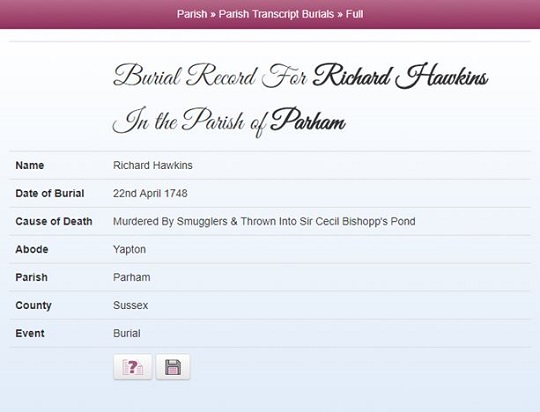
England – Findmypast has added a collection of Herefordshire baptism, marriage and burial records. Some wills are also included in this collection. Herefordshire is a county in the West Midlands of England. It is on the border with Wales. Hereford cattle, a popular breed, come from Herefordshire.
The records in this collection go as far back as the 1500s and as recent as 1936 (for the marriage records). Up to 240 parishes are covered by the collection (the complete list of parishes is here). Some of the records come from the Leintwardine History Society and the balance come from FamilySearch. The records can be searched by first name, last name, year, place and (in the case of the baptism records) mother’s name and father’s name. Access is by subscription. [Herefordshire Baptism Records]
Denmark – This week, we have huge news for anyone with Danish ancestors. FamilySearch has put online the Denmark census for 1860, 1870, 1880, 1890, 1901 and 1906. These collections can be browsed by image or searched by first and last name (in total, some 12.5 million records have already been indexed).
The 1860 census was Denmark’s ninth census since 1787. It was taken on 1 February 1860. The records are in Danish and German. An example is given below. All these census records can be searched by first name and last name. Access is free. [Denmark 1860 Census] [Denmark 1870 Census] [Denmark 1880 Census] [Denmark 1890 Census] [Denmark 1901 Census] [Denmark 1906 Census]
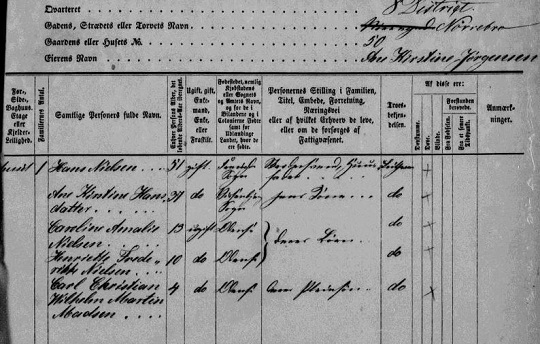
US – American Ancestors, the website of the New England Historic Genealogical Society has added two more parishes to their collection of parish records from the Roman Catholic Archdiocese of Boston.
The two new additions (images only) are the parishes of Sacred Heart of Jesus (East Cambridge) and St. Mary’s (Waltham). The records in the Boston parish collection span the years from 1789 to 1900. Access is by membership to the society, which now has over 1.4 billion records online. [Boston Parish Records]
The video below explains how to search their record collection.
Ireland – County Tyrone Genealogy, the website for all things related to genealogy in County Tyrone, Ireland has a new website. Originally established in 2006 as part of Rootsweb, this volunteer-run initiative now has a stand-alone website.
If you have ancestors from County Tyrone then this is the website to consult. It provides links to many genealogical records – everything from census records to church records to emigration records to obituaries. And best of all, everything is free! [County Tyrone Genealogy]
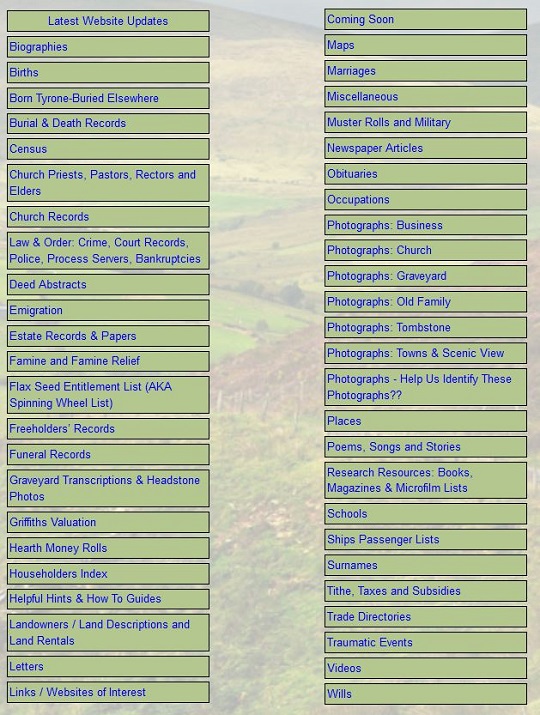
Canada – Findmypast has added the Canada census of 1851 to their website. This census covered Canada West (mainly present-day Ontario), Canada East (mainly present-day Quebec), New Brunswick and Nova Scotia. Some 2, 312, 919 individuals are listed in this census.
Although this census is available at other websites (such as the free search here), Findmypast has made it easier to search. The records can be searched by first name, last name, year of birth, place, sex, place of birth, province, the name of other household members and keyword. Access is by subscription.
Please note that the returns for some counties are incomplete. Some counties are also outright missing, particularly in Nova Scotia. Please also note that even though it is called the 1851 census, the actual enumeration day was in January 1852.
Finally, it should be mentioned that the census districts used for the 1851 census corresponded to the voting districts of the time. They did not always conform exactly to the county districts. Bottom line, if you cannot find your ancestors in this census, do not take it as proof that they did not live in Canada at that time. [Canada 1851 Census]
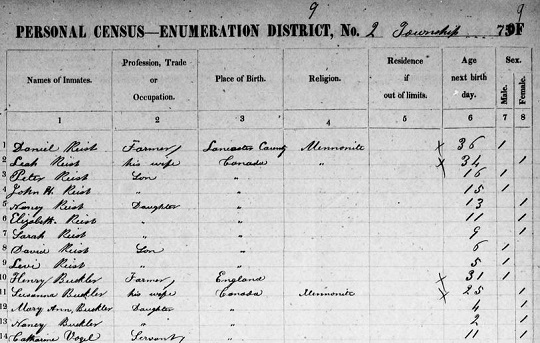
US – FamilySearch has added an additional 1.4 million records to their collection of 1895 Kansas State Census Records. This census lists all members of the household as of 1 March 1895.
In addition to listing each person, it gives their age, sex, race, place of birth, occupation, education level, military service and where the person lived prior to coming to Kansas. Below is a sample image from the census. These records can be searched by first name and last name. Access is free. [Kansas State 1895 Census Records]
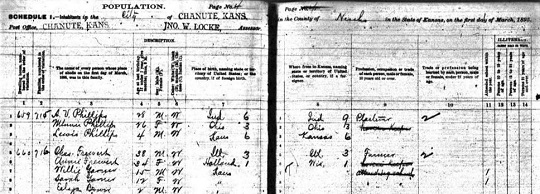
US – FamilySearch has put online an index of Washington State marriages and divorces spanning the years from 1969 to 2014. It lists the names of both parties and either their date of marriage (for the marriage records) or the date of divorce (for the divorce records). There are 2.0 million names in the marriage index and 1.2 million names in the divorce index. Both indexes can be searched by first name and last name. Access is free. [Washington State Marriage Index] [Washington State Divorce Index]
World – FamilySearch, the world’s largest free genealogy website (see our Top 100 List) announced that effective 31 August 2017 that they have discontinued their microfilm distribution service. FamilySearch began using microfilm back in 1938 to help people find their ancestors. However, with many of their microfilms now converted to digital, they have made the difficult decision to stop their microfilm distribution service. You can read the full announcement here.
England – Findmypast has added about 46,000 marriage bond indexes from Oxfordshire. These indexes span the years from 1634 to 1849.
For those who are not familiar with marriage bonds in England, they were a financial guarantee given by an intended groom and an associated bondsman to the local archdeacon, bishop or archbishop. The financial guarantee provided assurance by the groom that there were no legal or moral reasons why a couple should not marry. To ensure the groom was telling the truth, if the marriage was not consummated, the financial guarantee was forfeited to the Anglican Church.
In England, a marriage bond served much the same function as a marriage bann. A significant difference, however, was that a marriage bann required a notice to be posted in a church for at least three consecutive weeks announcing the pending marriage. This was a necessary condition before the couple could get married. The church notice allowed the local community an opportunity to provide legal or moral objections to the marriage.
The most common reasons why a marriage might not proceed included the bride or groom changing their mind, the possibility that one of them was already married (in a world before strong record keeping, people tried this more often than you might think), either the bride or groom was underage or the risk that the two were more closely related than allowed by law, which could happen in a small village (and which sometimes even the bride and groom did not know) .
In England, labourers tended to get married by marriage bann, whereas those who had more money, or were in a hurry (perhaps the bride was pregnant), would often instead take the financial risk and get a marriage bond.
Marriage bonds are interesting for genealogists because they can provide useful information not typically found on a marriage record. For example, the person listed as the bondsman (the person who provided the financial guarantee) was often a brother, an uncle or other relative or close friend of the bride.
Please note that this is an index only to the Oxfordshire marriage bonds, although in some cases, it appears the original record has been lost. The index lists the first and last name of the bride and groom, their marital state before getting married (S – spinster, B – bachelor, W- widow), the parish, the year and the county. The index can be searched by first name, last name, year and location. Access is by subscription. [Oxfordshire Marriage Bond Records]
England – Findmypast has put online a collection of some 42,000 clandestine marriage records. In England, a clandestine marriage (sometimes called an irregular marriage) was a marriage physically performed outside of an Anglican church, although it was often done by an Anglican minister.
Most of the records in this collection are from the Fleet area of London, which was nearby London’s notorious Fleet Prison. Fleet Prison, in addition to its appalling conditions, was also known as a debtor’s prison where people who could not pay their debts were sent to serve out a prison term. Over the years, Fleet Prison held many famous people, including William Penn who subsequently went on to found Pennsylvania. Fleet Prison was so infamous that it was even mentioned in the writings of Charles Dickens and Shakespeare.
The records in this collection span the years from 1667 to 1754. As mentioned in the article A Date Guide to English Genealogy (Part II), the introduction of Hardwicke’s Marriage Act in 1754 stopped the practise of clandestine marriages. Please refer to this article for more background information.
Many of the records in this collection are thought to be marriages performed by Anglican clergy for residences of both, the date and the marital status of those getting married (i.e. it identifies if someone was previously married). Not a large collection, but an interesting collection. Access is by subscription. [Fleet Prison Marriage Records]
England – The website Forces War Record announced that their collection has now reached 10 million military records from the UK. The type of records they hold include World War I, World War II, Crimean War, Boer War, Napoleonic War and prisoner of war records.
The records cover the various military services including the army, navy and air force. The records can be searched by first name, last name and time period. Alternatively, the records can be searched by military unit name and service. Forces War Record is a popular website that gets over 600,000 visits per month. Access is by subscription. [Forces War Record]
England – Findmypast has put online an index to more than 229,000 Lancashire wills and probate records. The index spans the period when it was the responsibility of the Anglican Church for administering such documents (1457 to 1858). The index can be searched by first name, last name, year, place and (surprisingly) occupation. Access is by subscription. [Lancashire Will & Probate Records]
Italy – FamilySearch has created a new indexed collection of civil registration records from Padova, Italy. These are birth, marriage and death certificates spanning the years from 1621 to 1914. This first release consists of some 42,000 indexed records plus some 43,000 digital images. The records can be searched by first name and last name. Access is free. [Padova Civil Registration Records]
Scotland – Findmypast has put online over a thousand Roman Catholic parish registers from Scotland. These registers span the years from 1736 to 1942 and cover all eight Scottish dioceses (Aberdeen, Argyll & The Isles, Dunkeld, Galloway, Glasgow, Motherwell, St Andrews & Edinburgh and Paisley). There are some time gaps in the registers. As well, some counties are missing from the collection (Shetland, Berwickshire, Kinross and Clackmannan).
The registers contain baptisms, marriages and burials. As well, some registers provide clergy lists, seat rentals, cemetery grave site purchases and parish lists. The registers have not yet been indexed by name. They can be browsed by place, county, diocese and year. Access is by subscription. [Scotland Roman Catholic Church Register Records]
These registers are full of Latin phrases and expressions. We suggest you use our specially-designed Genealogy Latin Dictionary as a reference source when looking through this collection.
England - Findmypast has released an interesting video that reviews how to get the most out of parish records, particularly in England. Parish records are a critical source for anyone wanting to trace their ancestors since they cover all three of the most important events in your ancestor's life (birth, marriage and death). The video can be viewed below:
May 2017
World – MyHeritage has just launched a very useful new feature called the Collection Catalog. As the name implies, it lists all the different record sets held by MyHeritage. As well, for each record set it also shows how many records are in each collection and when the collection was added to the website or last updated. This will make it much easier for users to follow along with all the updates to the MyHeritage website.
MyHeritage currently has some 6,500 different collections in their Collection Catalog (which works out to roughly 7.8 billion records in total). The list of collections can be filtered by type of record, geographic location and date range.
For a genealogist, this is a very useful addition. No one likes wasting effort searching for a record that doesn’t exist (for example looking for a birth record in a collection only to find out the record you seek is outside the range of birth records held in the collection). Well done MyHeritage! [MyHeritage Collection Catalog]
England – FindMyPast has significantly increased their collection of Nottinghamshire parish records. The latest addition includes some 1.3 million new baptism, marriage and burial records. A small number of marriage banns have also been added to the collection. The birth records span the years from 1538 to 1917.
A typical baptism record from the region lists the name of the person, church, denomination (after the Religious Toleration Act of 1689, the Anglican Church started collecting records from other denominations such as Methodists and Roman Catholics), date, father’s name and occupation, mother’s name and occupation, residence, etc.
These records can be searched by first name, last name, date and place. Access is by subscription. [Nottinghamshire Baptism Records]
England – FindMyPast has put online an intriguing collection of records pertaining to guilds and trade associations for the City of York. The roughly 73,000 records in this collection span the years from 1272 to 1930. They list freeman (basically guild members) as well as apprentices.
A typical record lists such information as name, date of birth, place of baptism, occupation, residence, employer and the name of the father (some positions were passed down from father to son). This is a good record set to search if you had ancestors from the region that may have skilled tradespeople. They may have been members of a guide or trade association.
These records can be searched by first name, last name, year and occupation. Access is by subscription. [Historic City of York Guild Records]
England – The website TheGenealogist has expanded their historic newspaper collection with the release of the popular newspaper The Sphere. This release covers the World War I period (August 1914 to June 1919).
The Sphere was a weekly newspaper that was very similar in tone and style to the Illustrated London News, which is well known to many genealogists (The Sphere was actually the Illustrated London New’s main competitor at the time).
The Sphere covered general news stories from England and around the world. It had extensive reporting on World War I. The Sphere was also known for its illustrations and photographs. It is a great newspaper for getting contextual information about your ancestors. Access to this collection is by subscription. [TheGenealogist]
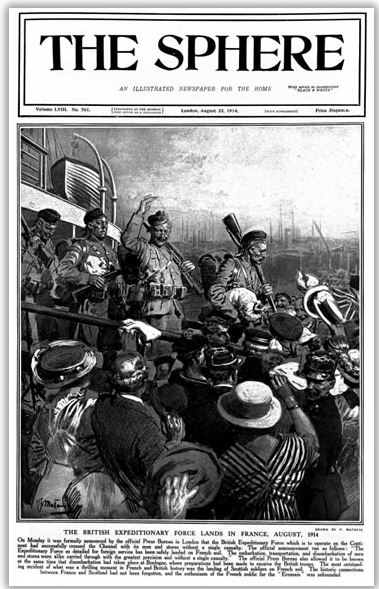
England – FindMyPast has added 48 historic directories from the City of York to their directories and almanacs collection. We have talked about directories before and how they are a great way to trace the address of your ancestors on a year-by-year basis.
At GenealogyInTime Magazine, we have some useful resources to help you get the most out of your historic directory searches, including List of First Name Abbreviations, City Directory Abbreviations and List of Occupation Abbreviations.
The FindMyPast directory and almanac collection can be searched by first name, last name, year, county, country and keyword. Access is by subscription. [Historic Directories]
US – This is an advance notice. The Arkansas State Archives has partnered with Newspapers.com to digitize and put online 17 different historic Arkansas newspapers. The newspapers will be available starting in June on the Newspapers.com website. The newspapers span the years from 1830 to 1925. The link provides the complete listing of Arkansas newspapers that will soon go online. [Historic Arkansas Newspapers]
US – FamilySearch has created a new record collection of vital records from Rhode Island. There are some 528,000 records in this new collection. It consists of birth records (1846 to 1898 and 1901 to 1903), marriage records (1901 to 1903) and death records (1901 to 1953). These records come from the state archives in Providence.
It is interesting that Rhode Island death records list place of birth of the deceased as well as the name of their parents (in addition to cause of death). The records can be searched by first name and last name. Access is free. [Rhode Island Birth, Marriage, Death Records]
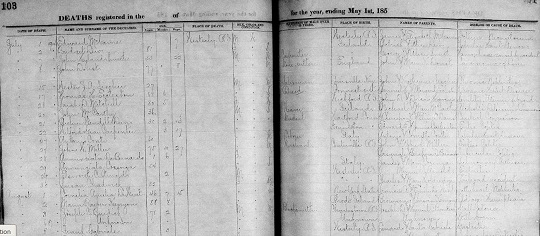
US – FindMyPast has added some 6.7 million more records to their growing collection of historic US marriage records. These new additions cover 18 different states and according to FindMyPast, the records are unique to them. These records can be searched by first name, last name, year, place, spouse’s name and parent’s name. Access is by subscription. [Historic US Marriage Records]
US – FamilySearch has added some 750,000 new indexed marriage records from Connecticut to their collection. This collection spans a broad date range from 1640 to 1939. The records come from the Connecticut State Library. The records can be searched by first name and last name. Access is free. [Historic Connecticut Marriage Records]
Australia – FindMyPast continues to add to their collection of Queensland school records. Note this is an index only. It does, however, cover some 1.6 million names across more than 1,000 schools, many of which are no longer in existence. The oldest record dates to 1864.
A typical record in this collection lists the name of the student, name of the school, year of admission and references the source document. As you can probably imagine for a collection like this, the records comes from a very diverse source of documents. The records are searchable by first name, last name, year and school name. Access is by subscription. [Historic Queensland School Records]
Italy – FamilySearch has added some 1.1 million images of civil registration records from Trapani (on the west coast of Sicily). These are images only (they have not yet been indexed) and span the years officially from 1906 to 1928 (although some records seem to go back as far as 1891). The images are of birth, marriage and death records. In total, this collection now contains some 1.4 million images. The images can be browsed by commune or frazione, then by type of record and year.
Please note that although access is free, these records are restricted for home viewing (this restriction is usually imposed by the legal owner of the records, not FamilySearch). You will need to go to your nearest FamilySearch library to see the images unless you are a Latter-day Saints member - i.e. a member of the Mormon Church. [Trapani Civil Registration Records]
Italy – FamilySearch has created a new browsable image collection of state birth, marriage, divorce and death certificates from Brescia, Italy. Brescia is a region of Lombardy at the foot of the Alps in northern Italy. The images in this collection span the years 1797 to 1815 and 1866 to 1943. There are some 620,000 images in total. The images can be browsed by commune or frazione, then by record type and year.
Please note that although access is free, these records are restricted for home viewing (this restriction is usually imposed by the legal owner of the records, not FamilySearch). You will need to go to your nearest FamilySearch library to see the images unless you are a LDS member. [Brescia Civil Registration Records]
Italy – FamilySearch has added some 1.1 million images of civil registration records from Benevento, Italy. This collection now has some 1.8 million images with the underlying records spanning the years from 1810 to 1942. These images can be browsed by province, then by commune or frazione and then by record type and year.
Benevento is northeast of Naples. Please note that although access is free, these records are restricted for home viewing (this restriction is usually imposed by the legal owner of the records, not FamilySearch). You will need to go to your nearest FamilySearch library to see the images unless you are a LDS member. [Benevento Civil Registration Records]
April 2017
England – The website TheGenealogist has expanded their collection of poll and electoral records. The latest additions cover voter record lists from Wakefield, West Yorkshire, Hampshire, Gloucestershire and Somerset.
Electoral records are an excellent alternative method for tracing your ancestors. Just be aware that if you are looking for voting records before roughly 1900, voting lists were normally limited to adult male landowners. These records can be searched by first name, last name and year. Access is by subscription. [Historic English Electoral Records]
England – FindMyPast has significantly expanded their collection of parish marriage records from Kent. The 312,000 new records cover the parishes of Bapchild, Biddenden, Kilndown, Tenterden and Wittersham. The collection spans the years from 1538 to 1987. These records can be searched by first name, last name, marriage year and spouse’s name. Access is by subscription. [Historic Kent Marriage Records]
England – The website TheGenealogist has added 100,000 new parish records from the county of Worcestershire. These are baptism, marriage and burial records. These records can be searched by first name, last name and date. Access is by subscription. [Worcestershire Parish Records]
Ireland – FindMyPast has added another 400,000 newspaper articles to their historic Irish newspaper collection. The latest addition comes from the Ballymena Weekly Telegraph and covers the years 1904, 1906-1916, 1921-1929 and 1931-1957. Access is by subscription. [Historic Irish Newspapers]
Ireland – The website RootsIreland has added an index to 60,000 south Mayo cemetery headstones. The index was derived from the gravestone collection held at the South Mayo Research Centre. A typical index lists the name of the deceased and the name of the graveyard.
In many instances, additional information is also available such as the date of death, age of the deceased and address of the deceased. The link provides a complete list of all the parishes covered by this new index. [South Mayo Gravestone Index]
England – FindMyPast has put online a collection of approximately 4.6 million parish records from the county of Wiltshire in southwest England. This collection consists of baptism (1538 to 1917), marriage (1538 to 1933) and burial (1538 to 1991) records. There are also some marriage banns in the collection.
These records come from the Anglican Church. It was a requirement in England from 1538 until the start of the civil registration in 1837 that each parish of the Anglican Church keep vital records (baptisms, marriage and burials) of everyone in their community (see the article A Date Guide to English Genealogy). Most other denominations (with the exceptions of the Quakers and the Jews) used the Anglican parishes for registration purposes. So even if your ancestors were not Anglican, you are likely to find them in this collection.
This collection can be searched by first name, last name, year and place. In the case of the baptism records, they can also be searched by the name of the father and mother. This is a good method to use when searching for children who may have died at a young age. Access to this collection is by subscription. [Wiltshire Baptism Records]
France – FamilySearch has put online the 1876, 1891 and the 1906 census records from the region of Hérault, which is in the far south of France. In total, there are close to 1 million records in these three collections. Each census lists each member of the household, their gender, their age and their occupation. The collections can be searched by first name and last name. Access is free. [Hérault 1876 Census] [Hérault 1891 Census] [Hérault 1906 Census]
France – FamilySearch has put online the 1906 census from the Nord region (department), which is located in northern France near Belgium. There are over 1.3 million records in this collection, which can be searched by first name and last name. Access is free. [Nord 1906 Census]
France – FamilySearch has put online both the 1876 and the 1906 census from Côtes-d’Armor department, which is in northwest France. This department was originally created from part of the province of Brittany. The two censuses contain some 1.1 million records in total. The collections can be searched by first name and last name. Access is free. [Côtes-d’Armor 1876 Census] [Côtes-d’Armor 1906 Census]
Scotland – FindMyPast has expanded a partial collection of Scottish Roman Catholic parish records. Few details have been provided by the website, but they appear to be the usual baptism, marriage and burial records from all eight Scottish dioceses. Also included are some congregational records such as registers of confirmations, registers of communion recipients, parish lists, seat rentals and a list of people who converted to Catholicism.
These records can be searched by first name, last name, year, place, county or diocese. Access is by subscription. [Scotland Roman Catholic Congregational Records]
Cape Verde – FamilySearch has added to their collection of Catholic Church records from Cape Verde. Cape Verde is a small archipelago of islands off the west coast of Africa founded by Portuguese settlers in 1462. It was the first colony founded by the Portuguese in Africa.
These records span the years from 1787 to 1957 and consist of baptisms, marriages and death records. The records can be searched by first name and last name. Alternatively, the records can be browsed by island and parish. Access is free. [Cape Verde Church Records]
Canada – FindMyPast has put online some 780,000 probate records from British Columbia. Probate records provide details about the estates of deceased persons. They are typically full of important dates, names of relatives and places related to the deceased.
This collection is browse only – it has not yet been transcribed. The collection spans the years from 1859 to 1949. It appears to consist mainly of probate records from Vancouver. The collection can be browsed by year and district. Access is by subscription. [Historic Vancouver Probate Records]
Canada – The Halifax Municipal Archives has started to put online (on Flickr commons) a small collection of some 531 historic photographs from the city. This collection spans the years from 1958 to 1969 and consists of such images as street scenes, children playing, municipal workers working, people hanging out laundry and Africville (the African American settlement on the outskirts of the city). See image below. Access is free. [Historic Halifax Photographs]
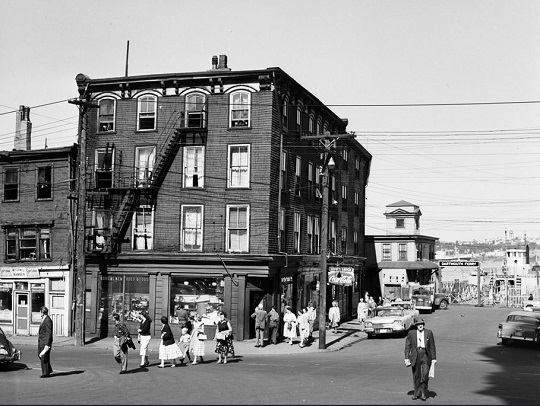
March 2017
New Zealand – FindMyPast has created a collection of University of New Zealand graduate records. These are records of students who graduated from the university. This record set spans the years from 1870 to 1963.
Up until 1961, the University of New Zealand was the only degree-granting university in the country. It consisted of four separate universities and two agricultural colleges. These were the University of Otago (Dunedin), University of Canterbury (Christchurch), University of Auckland (Auckland) and Victoria University of Wellington (Wellington). The two agricultural colleges were Canterbury Agricultural College (Lincoln) and Massey Agricultural College (Palmerston North).
The 37,000 records in this collection list the name of the graduate, year of graduation, university and the degree. Some records also contain additional notes on the student. The records can be searched by first name, last name, year and keyword. Access is by subscription. [Historic University of New Zealand Student Records]
Australia – FamilySearch has indexed an additional 170,000 records from its collection of outbound passenger lists from the state of Victoria. This collection spans the years from 1852 to 1924. A typical record lists the name of the passenger, year, gender, age, port of departure, port of arrival (many are London, England). Some records also list occupation and nationality.
The original image is not available for this collection. However, the record will reference the exact film/folder/image number so that the original record can be looked up at the Public Record Office of Victoria.
This collection can be searched by first name and last name. Access is free. [State of Victoria Outbound Passenger Records]
Ireland – FindMyPast has added to their collection of Quaker (Society of Friends) congregational records from Ireland. Some 250,000 new records in this collection list details of attendance at various gatherings and activities as well as minutes of more formal half-yearly meetings. A typical record lists the person’s name, date and address of the meeting. Depending on the type of meeting, additional details may also be available.
The records in this collection go back as far as the mid 1600s. The records can be searched by first name, last name and keyword. Access is by subscription. [Irish Quaker Congregational Records]
Ireland – The Church of Ireland has just published an updated list of historic parish registers for Ireland. This very useful 96-page pdf document lists by parish and diocese what baptism, marriage and burial records exist by date range and where to find them (including where to look online).
This guide is indispensable for anyone trying to trace their Irish ancestors. It will save you many hours of unnecessary frustration. The first step in any ancestral search (and one that many genealogists unfortunately overlook) is making sure that a record exists for a given place and time. This guide allows you to do that.
We strongly urge our readers to download a copy of this guide to your computer. Thanks to Claire Santry at Irish Genealogy News for pointing this out. [List of Church of Ireland Historic Parish Registers]
Ireland – Ancestry has significantly expanded their collection of Irish city directories (sometimes also referred to as street directories). The collection span the years from 1850 to 1946 and includes Dublin street directories as well as regional directories. The early directories in this collection list mainly merchants and tradespeople while the later directories tend to have much broader listings of residents. A typical Dublin city directory, for example, will list the name, address and occupation of the residents of the city.
These directories can be searched by first name, last name, occupation and keyword. Access is by subscription. [Irish City Directories]
City directories can be difficult to read. Often the publisher would cram as many names as possible onto a page to save money. These directories also often used abbreviations for common first names, for addresses and for occupations. GenealogyInTime Magazine has three very useful resources that can help you when reading these directories; List of First Name Abbreviations, City Directory Abbreviations and List of Occupation Abbreviations.
England – The website The British Newspaper Archive has reached an important milestone this week. They announced that following the digitization of a newspaper from the county of Rutland, the website now has at least one historic newspaper online from all 48 counties in England.
For those who are not familiar with the British Newspaper Archive website, it is the digitization of the British Library’s historic newspaper collection. This collection spans nearly 300 years (1709 to 2003).
The British Newspaper Archive now contains over 18.8 million pages of historic newspapers from 747 different titles from all over England, Wales, Scotland and Ireland. This year has also seen a dramatic increase in the rate of digitization of the historic newspaper collection. Since the beginning of 2017, over 100,000 pages of new content are now added to the website on a weekly basis.
The British Newspaper Archive is an incredibly valuable website for anyone trying to trace their British, Scottish or Irish ancestors. Access is by subscription. [British Newspaper Archive].
Here is a bit of interesting background on the British Newspaper Archive: the digitization process of the British Library’s newspaper collection originally began in May 2010. It will eventually encompass some 40 million digitized newspaper pages. At the current pace of digitization, the process should be completed in about four years’ time.
The complete printed historic newspaper collection is thought to contain some 750 million pages (starting in 1840, the British Library has an almost complete collection of all British and Irish newspapers when it became law for all publications to send a copy of each edition to the national library). This means roughly 5% of the entire collection will be digitized and put online .
Presumably archivists have chosen the 5% of the collection that can be digitized without destroying the original paper copy (old newspapers can crumble to the touch because they were typically printed on the lowest quality paper stock - especially during the war years) and which contain the highest information content for modern readers.
Most of the old physical newspapers are located at a specially designed facility in Boston Spa, West Yorkshire (see images below).
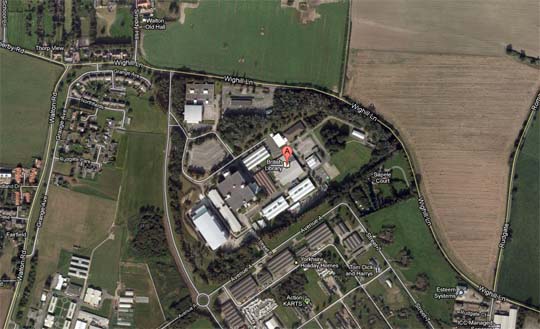
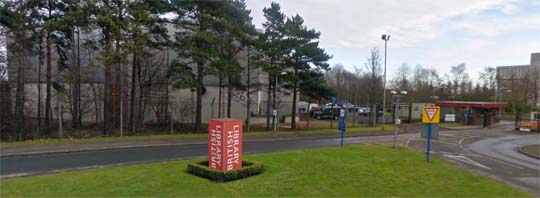

The digitization process and the British Newspaper Archive website is run by brightsolid. This is the same company that owns FindMyPast. Over the years, there have been some complaints about allowing a private company to digitize the British Library’s newspaper collection and then charging for access. However, from a practical perspective, if brightsolid had not digitized this collection it would probably have never gone online.
Canada – FindMyPast has created a collection of Manitoba probate records. This collection of some 802,000 images contains original estate files and application books that span the years from 1871 to 1930. The collection lists a wide range of information on deaths, estates and heirs. The application books, for example, list the name of the deceased, date of death, occupation, residence and heir as well as the occupation and residence of the applicant.
These records can be searched by year, judicial district and record type. Unfortunately, it does not appear that this collection can currently be searched by name. Access to this collection is by subscription. [Historic Manitoba Probate Records]
Australia – FindMyPast has created a collection of cemetery records from the state of Victoria. The some 250,000 records in this collection come from the following cemeteries: Boroondara; Coburg; Footscray; Lilydale and St Kilda. The records span the years from 1856 to 2005. The records can be searched by first name, last name, keyword and cemetery. Access is by subscription. [Victoria Cemetery Records]
France – FamilySearch has indexed some 600,000 records from the Saone-et-Loire census of 1876. This district (or department to use the formal French name) is near Burgundy between the Saone and Loire Rivers. This collection covers part of modern-day Burgundy.
This was a population census. It lists the name, address, gender, age, marital status, occupation and nationality of every household member. This collection can be searched by first name, last name, gender and marital status. Access is free. [Saone-et-Loire 1876 Census]
US – Great news for anyone with ancestors from the US Virgin Islands. The Danish National Archives has just launched a free new website to commemorate the day one hundred years ago in which the Dutch transferred the Territory of the Virgin Islands over to the United States. The website is called DanishWest Indies - Sources of History.
Known historically as the Danish West Indies or Danish Antilles, it consisted of the islands of Saint Thomas, Saint John and Saint Croix. The Dutch controlled these islands from 1754 until 1917. It was transferred over to the United States on 31 March 1917.
This new website contains some 5 million images of original documents, maps and drawings related to the time when the Dutch controlled the island. More than 150 volunteers have been working on digitizing these records for genealogical research. It is a treasure trove for anyone looking for ancestral records, including slave records.
The search engine on this website works just like our own Genealogy Search Engine. You can enter names, dates and places. A complete search guide is also available for anyone who requires assistance. Access is free. [US Virgin Island Genealogy Records]
Australia – FindMyPast has increased the size of their wills and probates collection for the State of Victoria. It now contains some 1.3 million records. This collection is an index that lists the names of deceased people whose estate passed probate through the Supreme Court of Victoria in Melbourne.
The index spans the years from 1841 to 1989. The index lists the name of the person, date of death, occupation, residence and date of probate. This information can then be used to order the full probate record from the Public Records Office Victoria. This collection can be searched by first name, last name, year of death and probate year. Access is by subscription. [Victoria Will & Probate Records]
You can also directly search the probate records online at the Public Records Office Victoria.
UK – The British Newspaper Archive has surpassed 18 million pages of online searchable content. The latest additions include Freeman’s Journal (1903-1905 and 1907); Pall Mall Gazette (1921); Irish News and Belfast Morning News (1894-1895, 1899, 1902-1910); Nottingham Journal (various dates 1860 to 1930); North London News (1893); Aberdeen Evening Express (1956) and Irish Society – Dublin (1889-1894, 1920-1924).
There are multiple ways to search these records, including by keyword (like a name), phrase, date, town, name of newspaper, etc. Access is by subscription. [Historic Online British Newspapers]
World – FamilySearch, the world largest free ancestral record website has put together a couple of short and very useful videos on how to find records on their vast website. These are great videos to watch if you are new to the website. They are also provide useful tips for more experienced users.
Canada – FindMyPast has put online the Lower Canada census of 1842. This collection of some 46,000 records covers the Province of Lower Canada, which is basically the southern part of modern-day Quebec plus Labrador.
This census lists the name of the head of the household, whether they owned their own property, whether they were entitled to vote, occupation or trade, country of origin and total number of people in the household broken out by gender and age group. This collection can be searched by first name, last name, occupation, town and county. Access is by subscription. [Lower Canada 1842 Census]
For those who do not have a subscription to FindMyPast, this census is also available for free on FamilySearch. Here is the link.
UK – FindMyPast has added some 295,000 records to their collection of Anglo-Boer War military records. This database comes from a wide variety of sources (apparently some 470 different sources) and contains a wide selection of information, including medal lists, honors lists, award lists, casualty records, etc.
Most records in this collection list (at a minimum) the person’s service number, rank, unit and regiment. The records can be searched by first name, last name, service number, rank, regiment and keyword. Access is by subscription. [Anglo-Boer War Records]
February 2017
Ireland – Dublin City Library has released a collection of historic photographs. Also included in this new collection are postcards, letters, pamphlets and city maps. This release contains about 43,000 items in total.
Most of the photographs date from the 1930s to the 1990s. Some are images of street scenes, and various cultural and social events. Most of the images of people seem to be publicity shots of actors from the Irish Theatre. Some of the maps show property boundaries listing the names of the owners of the property (see example below). This collection can be searched by keyword (like a name). Access is free. [Historic Dublin Photographs]
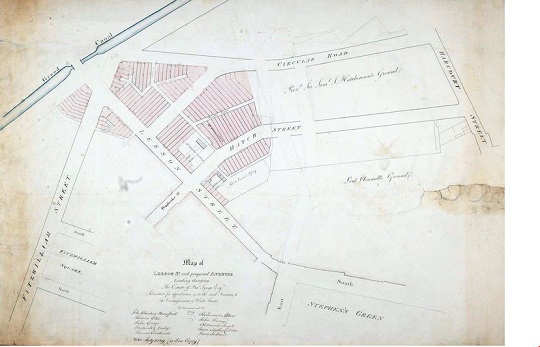
UK – The website TheGenealogist has released a collection of what are known as police letter books for the county of Hampshire. Police letter books record promotions, misdemeanors, movements and retirements of police officers in the county. This collection spans the years from 1891 to 1911. You can use this collection to trace the career path of your police ancestors in the county. Access is by subscription. [Historic Hampshire Police Books]
US – This is a preannouncement that will be big news for anyone with ancestors from Iowa. The State Historical Society of Iowa has announced that they have signed an agreement to digitize their collection of historic newspapers. The collection consists of some 12 million pages of newspapers from more than 300 titles that go back as far as 1837.
The digitization process will be done by Advantage Companies, a Cedars Rapid, Iowa company. It is expected to take five years to get the entire collection online. Here is the full press release.
UK – FindMyPast has released new Norfolk parish records. These are technically Bishop’s transcripts, which mean that they are copies of church records that were sent by the parish churches to the local bishop.
This collection consists of some 650,000 baptism records, roughly 155,000 marriage records and about 435,000 burial records. The records span the years from 1685 to 1941. These records can be searched by first name, last name, year and place. Access is by subscription. [Norfolk Baptism Records]
UK – FindMyPast has created a collection of Norfolk electoral rolls. This collection contains some 4.5 million records and lists details on eligible voters. The collection spans the years from 1832 to 1915. During this period, eligible voters would have been predominantly male landowners. For more information on how electoral rolls work, and how to use them to find your ancestors, see our article Searching Electoral Rolls for Ancestors.
Each entry in this collection lists the name of the person, place, district and year they were registered to vote. This collection also contains images of the original register, which also lists the person’s address and type of property owned or rented. These records can be searched by first name, last name, year, place and keyword. Access is by subscription. [Norfolk Electoral Rolls]
US – FindMyPast has released a new collection of Roman Catholic parish records from Philadelphia, Pennsylvania. These include baptism records and marriage records. The records cover Bucks County, Chester County, Delaware County, Montgomery County and Philadelphia County. You can also browse each of the 199 sacramental registers in this collection from the Archdiocese of Philadelphia.
FindMyPast has not stated the size of this collection or the date range. However, it looks like there are at least one million records in the collection. As well, the Catholic Church has been present in Pennsylvania since its founding in 1681. The Philadelphia region was originally formed as a diocese in 1808 and an archdiocese in 1875.
These records can be searched by first name, last name, year, parish, town and county. Access is by subscription. [Philadelphia Baptism Records] [Philadelphia Marriage Records]
US – FindMyPast has put online a variety of ancestral records from the Historical Society of Pennsylvania. These include lists of births & baptisms, deaths & burials, marriages and church congregation records. The records generally run from the late 1600s to the mid 1900s. There is also a record set of World War II army casualty cards in this collection.
These records can be searched by first name, last name, year, place and diocese. Access is by subscription. The link will take you to the baptism record search. To search the other records, click on the links on the bottom right of the page. [Pennsylvania Ancestral Records]
UK – The website TheGenealogist continues to add to their collection of English parish records. The latest additions come from Essex, Cumberland and Norfolk. These some 282,000 new records go back as far as 1672 and consist of baptism, marriage and burial records. Access is by subscription. [Historic English Parish Records]
UK – FindMyPast has put online the 1893 Roman Catholic census from the archdiocese of Westminster. This census lists all the parishioners in the region. A typical record gives the name of the person, year of birth, occupation, address, parish and (this is unusual) criminal risk.
The record also provides information on how active the person was in the church and comments about the character of the family and individuals within the family. This includes such things as attendance at mass, participation in Easter duties, confirmation details, etc. There is even a column where the priest can make comments about the family, such as ‘trustworthy’, ‘good poor family’, ‘bad Catholics’ and ‘living on charity’. Somehow, we get the feeling the parishioners were never shown these records…
These records can be searched by first name, last name, year of birth and parish. Access is by subscription. [Westminster 1893 Roman Catholic Church Census]
Australia – FindMyPast has added over 1 million new electoral records for the states of Queensland and Tasmania. With this latest addition, the collection of Australian electoral rolls has grown to some 12.6 million records in total. The entire collection covers New South Wales, Queensland, South Australia, Western Australia, the Northern Territory and Tasmania and spans the years from 1860 to 1959.
These records can be searched by first name, last name, birth year, occupation, town, district and state. You can even search by street, which is a great feature if you happen to know your ancestor’s address. Access is by subscription. [Australian Electoral Rolls]
If you need help understanding how electoral rolls can be used to trace your ancestors (including some of the abbreviations found in individual records), we suggest reading the article Searching Electoral Rolls for Ancestors.
Barbados – FindMyPast has put together a collection of some 20,000 documents that list emigrants from Britain to Barbados between 1678 and 1715. Included in these assorted documents are baptism records, burial records, censuses and landowner lists. These records can be searched by first name, last name, year and parish. Access is by subscription. [Early Barbados Emigrant Records]
Poland – The Polish Institute of National Remembrance (INR) has put online the names of the guards and SS commanders at the Auschwitz death camp. This collection consists of some 9,000 (mostly German) names. This list is thought to be the most comprehensive list to date.
If you look closely, you can see the website is in Polish, German and English. The list can be searched by first name and last name. The records can also be scanned by last name (scroll to the bottom of the page). Access is free. [Auschwitz Guard Records]

January 2017
Australia – FindMyPast has released a collection of some 3 million petty court records from the state of Victoria. In Australia, petty court cases were held to hear minor criminal cases such as public drunkenness, criminal damage and theft. The cases usually involved just a judge (no jury).
The records in this collection span the years from 1854 to 1985. A typical record lists the first and last name of the person, the name of the court, cause or reason for the charge, a description of the case and the actual court date. These records can be searched by first name, last name, year and court. Access is by subscription [Victoria State Petty Court Records]
Australia – FindMyPast has put online some 107,000 ship records from the port of Brisbane. These are passenger and crew manifests covering some 485 ship voyages between the years 1852 to 1885. These records come from the National Archives of Australia and list the vessel name, date and port of arrival, ancestor’s name, nationality and occupation. The vessels in this collection cover departures from England, Europe, North America and Southeast Asia. The records can be searched by first name, last name, ship name and date range. Access is by subscription. [Historic Queensland Ship Passenger Records]
Sweden – ArkivDigital, the Swedish genealogy website has announced that they will be adding several million aerial photographs to their extensive collection of some 58 million ancestral records. These aerial photographs appear to be primarily of rural regions and cover farms, cottages, rural stores, etc. Most of the images were taken from the 1950s to the present.
These images are expected to be added over the next several months (in addition to the some 600,000 new records added to the website on average every month). [ArkivDigital]
Ireland – FindMyPast has added some 1.2 million newspaper articles this month to their collection of historic Irish newspapers. Also included are seven new titles: the Leinster Leader, Donegal Independent, Kildare Observer, Eastern Counties Advertiser, Wicklow Newsletter & County Advertiser, the Longford Journal and the Ballyshannon Herald. Access is by subscription. [Historic Irish Newspapers]
England – FindMyPast has released a number of parish records from the county of Rutland in the East Midlands of England. Although Rutland is the smallest historic county in England, this collection covers some 50 parishes. Included in the collection are over 140,000 baptism records (1538 to 1916), some 25,000 marriage bann records (1653 to 1931), some 59,000 marriage records (1538 to 1931) and over 103,000 burial records (1538 to 1991).
The entire collection can be searched by year and place. Individual record types (baptism, banns, marriages and burials – click on the links on the right side of the page) can be searched by first name, last name, year and place. Access to these records is by subscription. [Historic Rutland Parish Records]
England – FindMyPast has released a number of parish records from Leicestershire. Included in this collection are 37,000 baptism records (1538 to 1916); 319,000 marriage banns (1670 to 1940); 672,000 marriage records (1537 to 1931) and 790,000 burial records (1538 to 1991).
Also included is a small collection of some 22,000 marriage license records (1604 to 1891) and some 173,000 will and probate records (1490 to 1941).
The entire Leicestershire parish record collection can be browsed by year and place. Alternatively, clicking on the links on the right side of the page allow searches of the specific record types by first name, last name, year and place. Access is by subscription. [Historic Leicestershire Parish Records] [Leicestershire Will and Probate Records]
England – FindMyPast has added Methodist parish records from the Sheffield district in South Yorkshire. These latest additions include 42,000 baptism records (1795 to 1997); 22,000 marriage records (date range not listed). These records cover eight branches of the Methodist Church: Free Methodist, Methodist, Methodist New Connection, Primitive Methodist, United Free Methodist, United Methodist, Wesleyan Methodist and Wesleyan Reform Methodist.
These records can be searched by first name, last name, place, and denomination. Access is by subscription. [South Yorkshire Methodist Baptism Records]
US – The Oklahoma state government has put online a free searchable index of births and deaths for the state of Oklahoma. This covers births that occurred more than 20 years ago and deaths that occurred more than five years ago. The death index only begins in 1908 (it does not cover the territorial period).
The indexes can be searched by first name, last name, middle name (a good option if your ancestor had an unusual middle name), date of birth, sex and county.
Searching the indexes is free. Please note that these are indexes only. It costs money to order the full record. Please also note that for genealogists (per state law), the birth certificate must be more than 125 years old for you to be able to order it. Death records must be at least 50 years old. [Oklahoma Birth and Death Indexes]
Scotland – Just a reminder that with the new year, new records have appeared on ScotlandsPeople. In particular, birth records from 1916 (110,000 records), marriage records from 1941 (47,000 records) and death records from 1966 (64,000 records). Access is by subscription. [ScotlandsPeople]
Ireland – FindMyPast has completed their collection of Irish Petty Session Court Registers. The collection now contains some 22.8 million records in total. Petty court records cover both civil and criminal cases and generally cover minor offenses such as merchants who did not pay for their bills, workers suing for unpaid wages, various debt collection actions and public drunkenness. These records can be searched by first name, last name, year and county. Access is by subscription. [Historic Irish Petty Court Records]
Ireland – The Irish Genealogical Research Society has announced that their early Irish birth, marriage, death indexes have collectively reached a quarter of a million names. Congratulations! The link takes you to the full announcement. [Irish Ancestors]
India – The Families in British India Society have added indexes for birth, marriage and death records for the years 1806 and 1807. These indexes come from the Asiatic Annual Register, which as the name implies is an annual register primarily of the activities of the British in India. Although a small collection, these indexes can be very valuable if you had British ancestors in India. Access is free. [Asiatic Annual Register]
December 2016
US – The St. Louis Genealogical Society has completed a 16-year project to transcribe and index every burial in the city and county of St. Louis. Congratulations! In total, some 444 cemeteries were identified and indexed. These records cover some 1.5 million internments. Access to this collection is available to St. Louis Genealogical Society members. [St Louis Cemetery Records]
France – FamilySearch.org has indexed an additional 350,000 records for the 1856 census for the region of Dordogne, France. This index lists the first name, last name, occupation (nationality, if applicable), gender and age for all members of the household. There is also an Observation column that sometimes gives useful information. See image below. This collection can be searched by first name and last name. Access is free. [Dordogne 1856 Census]
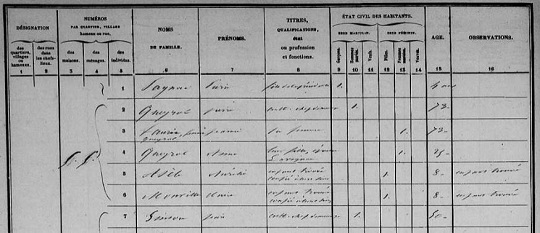
England – FamilySearch.org has started a new collection of Cambridgeshire parish records. These records date from 1599 to 1860. These are bishop’s transcripts, which are basically summary records held by the local bishop for baptisms, marriages and deaths. Some 36,000 records have already been transcribed with more to come. The records can be searched by first name and last name. Access is free. [Cambridgeshire Parish Records]
South Africa – FamilySearch.org has created a new image collection from South Africa of Transvaal probate records. These records come from the Supreme Court in Pretoria and span the years from 1869 to 1958. There are some 1.5 million images in this collection, which has been partially indexed and is searchable by first name and last name. This collection of probate records includes wills, death notices, property transfers, lists of heirs and asset distribution lists.
The death notices are particularly useful because they list all the children, their dates of birth and (if applicable) their spouses. See example below. Access is free. [Historic Transvaal Probate Records]
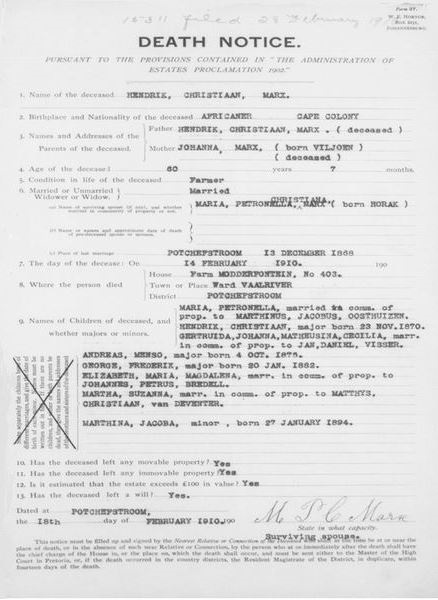
Bolivia – FamilySearch.org has indexed an additional 370,000 Bolivian Catholic Church records. These records span the years from 1566 to 1996 and can be searched by first name and last name. Access is free. [Bolivia Church Records]
England – FindMyPast has completed a significant new upload of historic British newspapers to their extensive UK collection. This batch includes 204 million new articles. Also added were eight new titles, including the Northern Daily Telegraph, the Evening Star and the Illustrated Sporting and Dramatic News. Access is by subscription. [Historic British Newspapers]
England – FamilySearch.org has created a new collection of historic non-conformist (i.e. non-Anglican) church records for Bristol. These are primarily christening, marriage and burial records that cover the years from 1777 to 1936. The 160,000 records in this collection cover the following religions: Methodist, Society of Friends (Quakers), Catholic, Presbyterian, Unitarian, Wesleyan, Swedenborgian, Congregational and Baptist. Access is free. [Historic Bristol Church Records]
England – FindMyPast has added over 49,000 records to their collection of Buckinghamshire parish marriages records. These records come from 26 parishes within the county of Buckinghamshire. A typical record lists the names of the bride and groom, date of marriage and the parish. FindMypast has not specified the date range for this collection. Access is by subscription. [Buckinghamshire Marriage Records]
Ireland – FindMyPast has put online Royal Irish Constabulary service records. The some 486,000 service records in this collection span the years from 1816 to 1922. A variety of records are included in this collection, including records of clerical staff who worked for the constabulary.
The Royal Irish Constabulary was the armed police force of the UK government in Ireland. It was officially formed in 1836, meaning that some of the records in this collection predate the official formation of the force.
The records in this collection can be searched by first name, last name, year, service number and place. Access is by subscription. [Royal Irish Constabulary Service Records]
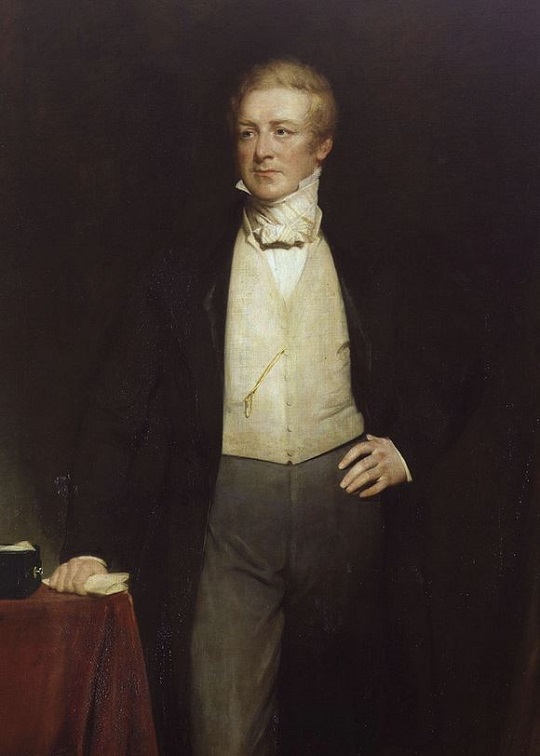
US – We don’t usually talk about free offers from subscription genealogy websites because often they don’t last long. However, this one caught our attention. The Ancestry website Fold3 (it specializes in US military records) is offering free access to their 113 million World War II records for the entire month of December 2016.
Included in this collection are 35 million WWII draft registration cards. Also included in the free search for the month are World War II navy muster rolls, missing air crew reports and European army records.
This link will take you directly to the free offer. [Fold 3 World War II Free Records]

US – MyHeritage has launched a collection of some 24 million US World War I draft registrations. These records span the years from 1917 to 1918 and include such information as name, address, date of birth, place of birth, marital status, race, occupation, employer and citizenship.
The 1917 draft registration records (done on 5 June 1917) covered all men from the age of 21 to 31. The second registration done exactly a year later on 5 June 1918 added all men who had just turned 21. The final registration was done on 12 September 1918 and covered all men 18 to 45 who had not previously registered. Access to these records is by subscription. [MyHeritage World War II Draft Cards]
We should note that FamilySearch.org also has these records for free.

Australia – FindMyPast has increased their collection of historic New South Wales passenger lists. The collection now contains some 8.5 million records. The assisted passenger lists (which refers to those people who received financial assistance to migrate to Australia) spans the years from 1828 to 1896. The unassisted passenger lists span the years from 1826 to 1900.
Included with each record are a transcript and an image of the original record. Typical information includes name, passage type (assisted or unassisted), year of birth, nationality, port of departure, port of arrival and the dates of travel. The records can be searched by first name, last name, year, port of departure and vessel name. Access is by subscription. [Historic New South Wales Passenger Lists]
England – The website TheGenealogist has added some 2.1 million parish records from Hampshire. Released in partnership with the Hampshire Genealogical Society, the collection consists of 1.8 million baptism records from 1538 to 1751. Also included in the collection are 212,000 marriage records from 1538 to 1753 and 144,000 burial records from 1838 to 1865.
Hampshire is located on the southern coast of England and includes the cities of Southampton and Portsmouth. Hampshire also contains Winchester, the former capital of England. Access to these parish records is by subscription. [Hampshire Parish Records]
November 2016
England – FindMyPast has announced they have added an additional 5 million more records to their 1939 UK register collection. For those who recall, the 1939 register was launched with great fanfare in October 2015 (see our October 2015 commentary below).
There are now 32.8 million records in this collection, which provides a great snapshot of England and Wales at the beginning of World War II. Each record lists the names of the inhabitants at each address, their date of birth, marital status and occupation.
This record set can be searched in a number of ways, including first name, last name, year of birth, sex, marital status, occupation, district, county and keyword. You can even search by other household member’s names. Access is by subscription. [England 1939 Register]
The video below provides some good background on the 1939 register.
England – FindMyPast has put online British Royal Navy muster rolls that cover the years from 1739 to 1861. There are some 280,000 muster rolls in this collection, which list who was assigned to a particular ship, their rank, their pay, etc.
Formal service records for the Royal Navy did not begin until 1853. These muster rolls serve as a nice proxy for anyone who had seafaring ancestors in the navy before the mid-1850s. These records can be searched by first name, last name, birth parish, birth county and ship name. Access is by subscription. [Historic British Navy Muster Rolls]
Australia – FindMyPast has put online a roll of honour for all New South Wales government railway and tramway employees who died while serving in World War I. This roll of honour covers a wide variety of military units and lists the name of the employee, the branch of the railway or tramway where they worked and the military unit where they served.
There are some 280,000 records in this collection, which spans the years from 1914 to 1919. The records can be searched by first name, last name and military unit. Access is by subscription. [New South Wales Railway WWI Honour Roll]
Canada – FindMyPast has put online the Lower Canada census from 1825. This collection contains some 74,000 records and covers Quebec and parts of modern-day Labrador. The collection can be searched by first name, last name, town, county and keyword. Access is by subscription. [Lower Canada 1825 Census]
US – FamilySearch.org has released a new collection of Tennessee birth records. The some 215,000 indexed records in this collection consist of birth records from the state spanning the years from 1908 to 1912. For those who have a detailed knowledge of Tennessee birth records, this collection is from the Enumerator Record Series from the Tennessee Division of Vital Records.
It should be noted that not all Tennessee birth records were captured in this series. Below is a sample birth record. This collection can be searched by first name and last name. Access is free. [Historic Tennessee Birth Records]
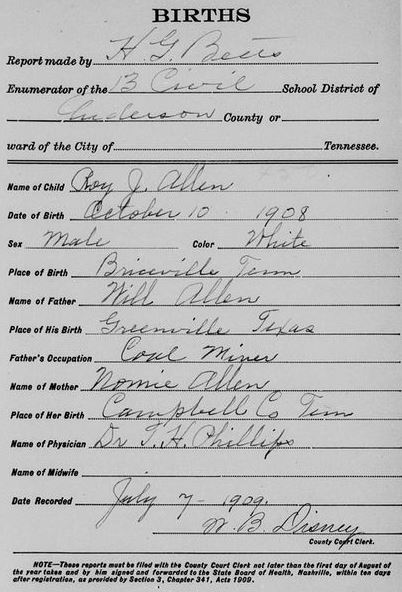
US – FamilySearch.org has created a new indexed collection of delayed birth records from Iowa. The some 540,000 records in this collection span the years from 1850 to 1939. One nice thing about Iowa birth records is that the birth certificates from the later years in this collection list the parent’s place of birth and their age at the time of the birth of their child. These can be powerful clues to help trace the previous generation.
The earlier birth certificates in the collection (see example below) provide an abstract of supporting documents to support the date of birth of the child. These supporting documents can also provide valuable clues. These records can be searched by first name and last name. Access is free. [Historic Iowa Delayed Birth Records]
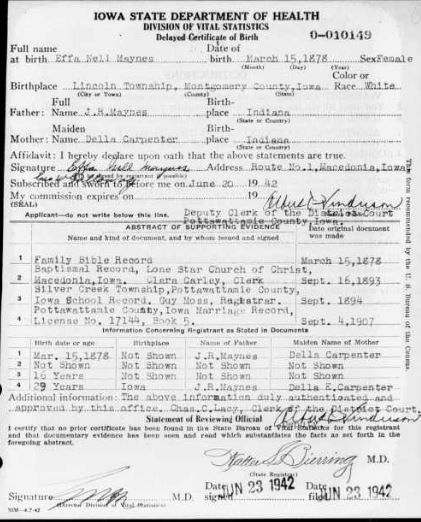
US – FamilySearch.org has created a new indexed record collection of Iowa death records that span the years from 1921 to 1940. The some 520,000 records in this collection come from the State Historical Society of Iowa. In addition to the usual information found on a death record, these records list the names of the parents of the deceased as well as the address of the deceased. A cause of death is also listed. The records can be searched by first name and last name. Access is free. [Iowa Death Records]
US – FamilySearch.org has released a big new collection of cemetery records from the Archdiocese of Chicago, Illinois. These records list over 1.9 million cemetery records under the jurisdiction of the archdiocese and span the years from 1864 to 1989. The majority of the collection is comprised of burial index cards, as shown below. The collection can be searched by first name and last name. Access is free. [Archdiocese of Chicago Cemetery Records]
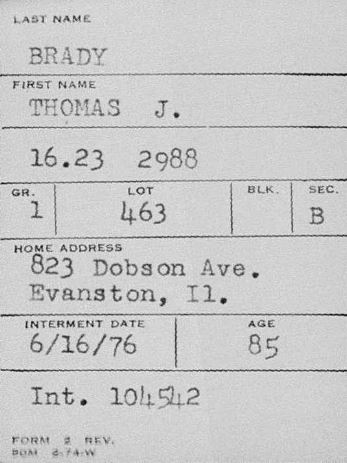
UK – The website Forces War Records, which specializes in UK military genealogy, has created a special dedication wall ahead of November 11th Remembrance Day. It allows anyone to upload a dedication to an ancestor who died fighting in a war. People can upload photographs and write short dedications on the website. You have to register first at the website before uploading information. We have included a screenshot of the web page below to give you an idea of how it works. [Remembrance Day Dedication Wall]
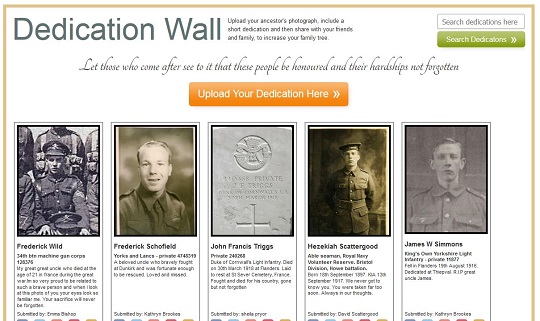
US – FindMyPast has put online an intriguing collection of US naval records from World War II. These records pertain to Naval Group China, the US Naval intelligence unit that operated in China during the years from 1942 to 1945. The records are mainly muster roll reports collected approximately every two weeks. They list the name, rank, rates of pay, branch of service and duty location. Since the same person is likely to be listed on multiple muster rolls, you can use these reports to track the location of your naval ancestor in China over the course of the war. Access is by subscription. [US World War II Naval Records]
US – FamilySearch.org has indexed an additional 213,000 records from the New Jersey state census of 1865. This is a good census to check even if you don’t think you had ancestors living in New Jersey. As we pointed out in our article Ellis Island Immigration Facts, many immigrants who landed at Ellis Island ended up living in nearby New Jersey for a while before ultimately migrating somewhere else in America. They may have been captured in this census. These census records can be searched by first name and last name. Access is free. [New Jersey 1865 State Census]
New Zealand – FindMyPast has released a small collection of some 5,000 records of people eligible for a military pension in New Zealand between the years 1900 and 1902. A typical record lists the name of the person, their military rank, service number, name and address of next of kin. Access is by subscription. [New Zealand Military Pension Records]
Czech Republic – FamilySearch.org has added over 1.6 million images to their collection of censuses and inhabitant registers (somewhat similar to a census) from the Czech Republic. This collection spans the years from 1800 to 1990 and now consist of some 4.9 million images in total. Most of the records seem to be from the 1921 census. The images are sorted by district, town and year. Currently, the images only come from Bohemia and Moravia-Silesia. The images are in Czech and German.
A typical census record from the Czech Republic lists the head of household, names of all the members of the household (including servants), their ages, occupation and religion as well as their relationship to the head of the household. Some records also give dates and place of birth. Below is a sample census image. Access to this collection is free. [Historic Czech Census Records]
For those with Czech ancestors who do not know the Czech language, FamilySearch has also included a handy Czech genealogical word guide.
October 2016
US – FindMyPast has released a collection of Utah divorce records. These are recent records that span the years from 1997 to 2016. Each record includes a transcript of the divorce proceedings with such information as date of divorce, name of the petitioner, name of the respondent, the attorney, the case type and the final judgement. Access is by subscription. [Utah Divorce Records]
US – FamilySearch.org has created a new indexed record collection of Maine World War I draft registration cards. The some 162,000 records in this collection span the years from 1917 to 1919 and come from the Maine State Archives. Below is a sample draft card. The records can be searched by first name and last name. Alternatively, you can scan through the images in this collection, which are organized alphabetically by last name. Access to this collection is free. [Maine World War I Draft Cards]
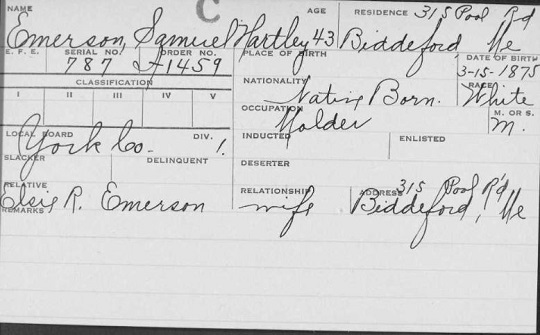
Ireland – FindMyPast has added 10 new publications to their collection of Dublin registers collection. Included in this new addition are school registers, district censuses, business directories and monumental inscriptions. The collection now contains over 3,500 pdf images. The collection can be searched by first name, last name, publication year, publication title and keyword. Access is by subscription. [Historic Dublin Registers]
Ireland – FindMyPast has added 1.7 million newspaper articles to their historic Irish newspaper collection. Notable new additions come from the Irish Times and the Weekly Irish Times. This newspaper collection can be searched by date range, place, county, newspaper title and article type in addition to searching by first name, last name and keyword. Access is by subscription. [Historic Irish Newspapers]
Canada – FindMyPast has put online the 1901 Canada Census. This collection consists of some 5.1 million records. The 1901 Canada census was the first Canadian census that asked questions on religion, place of birth and citizenship. These records can be searched by first name, last name, year of birth, sex, marital status and place of birth. Access is by subscription. [Canada 1901 Census]
Alternatively, you can search this census for free by going directly to the Library and Archives of Canada website, which in addition to having the same information as FindMyPast also provides a digital image of the original census form. [Free Canada 1901 Census]
US – FamilySearch has significantly expanded their collection of New Hampshire Revolutionary War records. The records in this collection span the broad range from 1675 to 1835. There are some 85,000 records in this collection, which consist of records such as muster rolls, tax books, oaths of allegiance, pension rolls, pension applications and officer account books.
A typical record might list such information as name of the soldier, their home residence, date of muster and possibly some description of their military service. The collection can be searched by first and last name. Alternatively, it is possible to browse the images in this collection, which are organized by type of record. Access is free. [New Hampshire Revolutionary War Records]
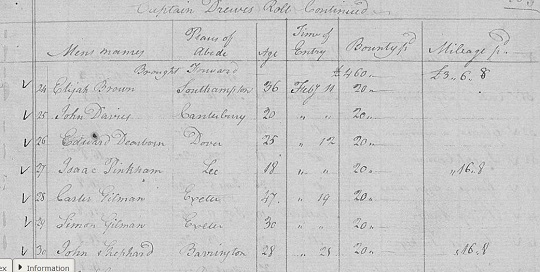
US – FamilySearch.org has indexed some 49,000 Revolutionary War pay vouchers from the state of North Carolina. These pay vouchers cover the period from 1779 to 1782 and come from the North Carolina State Archives in Raleigh. Pay vouchers were issued in lieu of cash and were paid both to soldiers and to people who provided supplies to the army. They are worth checking out even if you don’t think your ancestor fought in the war – they may have provided supplies.
The records in this collection can be searched by first and last name. Alternatively, the images for the records are available and they are arranged alphabetically by last name. It might be worthwhile browsing the images if you cannot find your ancestor using the search function. See image below.
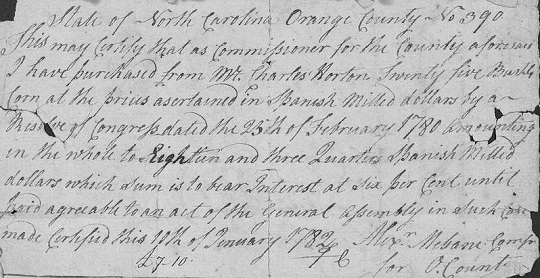
A typical pay voucher lists the first and last name of the recipient, date of the voucher, date of the oath certifying that payment is required, state or place where the voucher can be redeemed, and the value of the voucher (or the value of the goods received in the case of supplies). Access is free. [North Carolina Revolutionary War Pay Vouchers]
Belgium – FamilySearch.org continues to add more images and translate more records from their collection of civil registration records from Limburg, Belgium. The latest update brings the collection to some 900,000 images, many of which have already been transcribed. This collection spans the years from 1798 to 1906 and consists of birth, marriage and death records from the region. These records come from the Belgium National Archives.
Limburg is the easternmost of the five Dutch speaking provinces in the region of Flanders. Most of the records in this collection are in Dutch, although some are in French.
It is interesting to note that birth records in this collection list the address of the parents as well as the place of birth of both the father and the mother. Death records sometime list the names of the children of the deceased. The images in this collection can be browsed. The records that have already been transcribed can be searched by first name and last name. Access is free. [Limburg Birth Records]
US – FamilySearch.org has created a new collection of Florida marriage records. The collection lists some 705,000 names and span the years from 1830 to 1957. The collection consists of marriage affidavits, marriage applications and marriage licenses (see image below).
The marriage affidavits and licenses combined list the names of the bride and groom, their date of birth, place of birth, current residence, race, occupation, the names of the parents and date and place of marriage. Witnesses to the marriage are also listed. These records can be searched by first name and last name. Access is free. [Historic Florida Marriage Licenses]
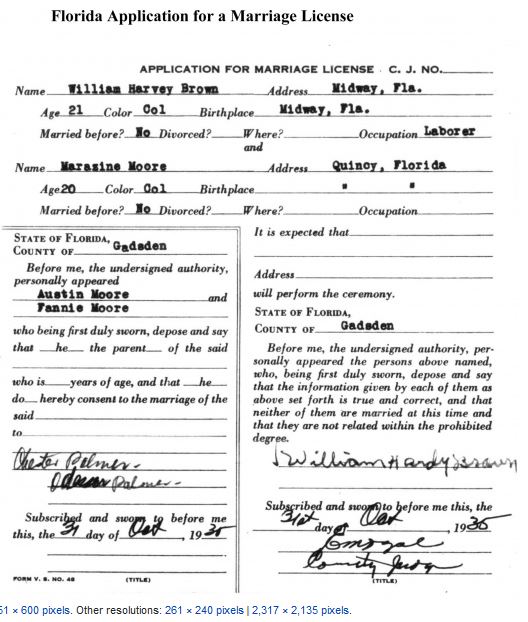
US – FamilySearch.org has indexed an additional 1.5 million names in the New York City police census of 1890. What is a police census you might ask? Apparently, the New York City government felt that the federal census of the city in 1890 had undercounted the number of inhabitants of the city (i.e. not everyone had been properly enumerated). We have talked about this issue before in a broader sense, where poor (and often black) neighbourhoods could be undercounted in historic census enumerations. The city government decided to conduct its own census using the police as enumerators.
As it turns out, the city government was correct. The New York City police census managed to count 13% more people than the federal census of the same year (the federal census was done 2 June 1890 while the police census was done 19 September and 14 October 1890).
The police census only contains basic information, such as name, age, gender and address. However, as fate would have it, much of the 1890 federal census was destroyed in a fire in 1921. Thus this police census can be very valuable to anyone who had ancestors in New York City at the time. Unfortunately, not all the books from the police census survived (894 out of 1008 books still exist or roughly 90% of the census records), but it is still a very valuable resource. The records can be searched by first name and last name. Access is free. [New York City 1890 Police Census]
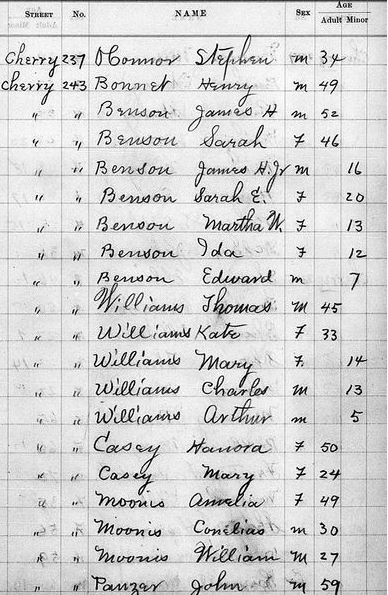
US – The New York Public Library is in the process of digitizing 137 years of New York City directories. The first batch from 1849/50 through to 1923 have already been digitized and put online. The second batch from 1786 onwards will be digitized next.
This is great news for genealogists with ancestors from New York City as it will be possible to trace your ancestor’s home address on basically a year by year basis. Access is free. [New York City Directories]
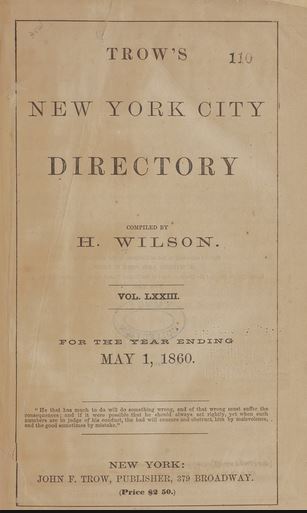
Australia – FamilySearch.org has put online an intriguing collection of court inquest papers from the state of Victoria. These are essentially deposition files from police and various witness accounts regarding inquests into people who died under unusual circumstances, such as a workplace accident.
The records span the years from 1840 to 1925. Some 102,000 names have been indexed in the collection, which can be searched by first name and last name. These files provide a lot of detailed background into a person’s death, much more than most genealogical sources. They would be a good collection to search for anyone who had ancestors from that time period. Access is free. [Historic Victoria Inquest Papers]
New Zealand – FamilySearch.org has created a new searchable collection of Archives New Zealand civil records indexes. The some 860,000 records in this index span the years from 1800 to 1896 and consist of indexes of birth, marriage and death records. Please note that these are indexes only. The full record can be found by searching the New Zealand government’s Department of Internal Affairs website (www.bdmhistoricalrecords.dia.govt.nz).
In New Zealand, historic birth records from the time period normally list the first and last name of the child, date of birth, place of birth, as well as the first and last names of the mother and father. Marriage records usually lists the bride and groom’s first and last name, date of wedding and the location of the wedding. Death records list the first and last name of the deceased person, date and place of death, date of birth and age at time of death.
These indexes can be searched by first and last name. At the moment, there is no way to browse the collection. Access is free. [Historic 1800s New Zealand Birth Marriage Death Index]
Argentina – FamilySearch.org has created a collection of Catholic Church parish records from the province of Mendoza, Argentina. The 144,000 records in this collection span the years from 1665 to 1975 and consist of baptisms, confirmations, marriages and death records.
The baptism records in particular are fairly complete, listing the parent’s names and their origin as well as the date of birth of the child. The records can be searched by first name and last name. Access is free. [Historic Mendoza Baptism Records]
Wales – FindMyPast has put online a collection of workhouse registers from Monmouthshire. This collection of some 138,000 records comes from the Abergavenny workhouse and spans the years from 1837 to 1929. Included in the collection are admission records, medical notices, religious creed (oath) records and school admission records.
Each record contains a transcript and an image of the original record. Typical information listed in a record include name, year of birth, residence and admission date to the workhouse. These records come from the Gwent Archives. Access is by subscription. [Abergavenny Workhouse Records]
Wales – FindMyPast has put online a large collection of electoral rolls from Monmouthshire, Wales. These rolls span the years from 1832 to 1889 and consist of over 100 volumes. The rolls are currently available primarily for image search. So far, only about 10,000 records from the collection have been transcribed (although presumably more will be transcribed in the future).
Please note that during the timeframe of this collection, the only eligible voters would have been adult male landowners. The images can be browsed by year and constituency. Access is by subscription. [Historic Monmouthshire Electoral Rolls]
US – The University of Kentucky Libraries and the Fayette County Clerk’s office have put online an interesting collection of early African American marriage indexes from Fayette County. The books date from 1866 to 1882 and from 1958 to 1968.
Please note these are indexes and are currently searchable only by scanning through the online books. Work is underway to transcribe the indexes. See image below. Access is free. [Early Kentucky African American Marriage Indexes]
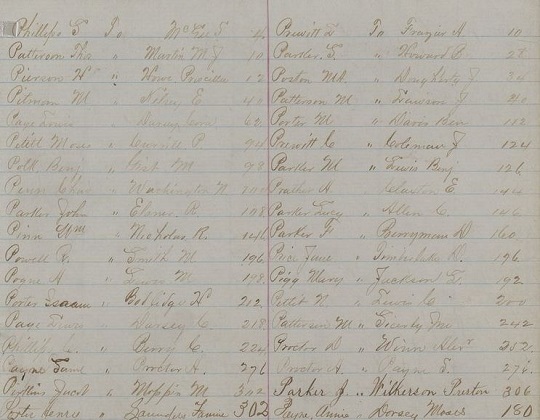
US – TheGenealogist, a well known website for UK genealogy records is expanding in a big way into US ancestral records. They are releasing over 220 million US records. Some of the highlights include 90 million Social Security Death Records (1935 to 2014), 132 million records from the 1940 US census and immigration records of some 600,000 Irish citizens who arrived in New York between 1846 and 1851.
One nice thing about how TheGenealogist has organized the 1940 census records is that they are linked to the enumeration maps. This makes it much easier to find your ancestors, who can be searched by address. Access to these new collections is by subscription (although TheGenealogist does offer a free 14-day trial). [US 1940 Census Records]
US – The website Reclaim the Records (which we have talked about before) has been successful in obtaining more free genealogy records. They have created a website called NYC Marriage Index that has 3.1 million marriage licenses for New York City spanning the years from 1950 to 1995. The index shows the first, middle and last names of the bride and groom, the borough and the year they were married. Access is free. [Historic New York City Marriage License Index]
Scotland – The Scottish website ScotlandsPlaces has done something rare in the world of genealogy. They have decided to switch from being a subscription website to one that is completely free (thanks to the British Genes blog for pointing this out).
For those who are not familiar with the website, it organizes genealogy records by county. Pick a county and it will provide a list of all the free genealogy records for that region. The website is particularly strong on ordinance survey records, tax rolls and unusual records such as window tax rolls and dog tax rolls. Access is free. [ScotlandsPlaces]
September 2016
Scotland – The popular genealogy website ScotlandsPeople is going to re-launch on Monday 26 September with a new look and hopefully some new features. The existing website has been offline since Thursday 22 September.
For anyone not familiar with ScotlandsPeople, it is the official Scottish government website for genealogy. It works on a pay-per-view system. It is also the most important genealogy website for anyone researching their Scottish ancestors.
According to ScotlandsPeople, anyone with existing credits, saved images or saved searches from the old website will be able to access them on the new website once it becomes available.
ScotlandsPeople is run by a company called brightsolid, the same people who own FindMyPast. It will be interesting to see what the new website looks like when it launches. [ScotlandsPeople]
Scotland – Ancestry.co.uk have added Glasgow electoral registers spanning the years from 1857 to 1962. Electoral registers list the names and residences of people who are eligible to vote. For those who are not familiar with electoral registers (also called electoral rolls), please see our article Searching Electoral Rolls for Ancestors.
Please note that for this collection, the eligibility to vote (and thus whether your ancestor will appear on the register) in Scotland was as follows:
• Up to 1918 - male landowners over the age of 21.
• 1918 onward - men over the age of 21 and some women (typically landowners) over the age of 30.
• 1928 onward - men and women over the age of 21.
This collection can be searched by first name, last name, year, gender and keyword. Access is by subscription. [Historic Glasgow Electoral Registers]
England – The website TheGenealogist has released a series of lists from books detailing clergy and lay members of various religions primarily in England but also Scotland, Wales, Canada and New Zealand. Included in this collection are members of the clergy from the Anglican Church of Canada in 1926 and 1935; New Zealand Methodist ministers from 1912; Catholic clergy in England, Scotland and Wales in 1867 and 1877, Catholic Registers in Shropshire 1763 to 1837; multiple Jewish yearbooks in England and synagogue seat holders in London for various years from 1896 to WWII; London Register of Missionaries 1796 to 1923 plus several other religious lists of clergy, missionaries and lay members. Access is by subscription. [Historic England Religious Registers]
England – The British Newspaper Archive has reached the milestone of 15 million digitized pages online. Congratulations! Some of the more notable new additions include the Belfast Telegraph (1902); the Birmingham Chronicle (1819 to 1822 and 1824 to 1827); the Cork Constitution (1863, 1874/75, 1877/78 and 1893/94); the Leeds Mercury (1921 to 1926) and the West Surrey Times (1856 to 1857). Access is by subscription. [British Newspaper Archive]
England – FindMyPast has updated their Lincolnshire parish record collection. There are now 4.4 million records in the collection. Roughly half the collection is baptism records. These baptism records can now be searched by first name, last name, birth year, baptism date, baptism location and (interestingly) the father and mother’s first name. Access is by subscription. [Lincolnshire Baptism Records]
Ireland – Last week, we announced that FindMyPast had added several key new Irish genealogy record sets from the National Archives of Ireland. This included wills and indexes, marriage license bonds, Catholic conversion rolls, shipping crew lists and land valuation records (see the complete listings below). These same record sets have now been added to the National Archives of Ireland website. Access is free. [Free Irish Genealogy Records]
England – FindMyPast has added an additional 1.6 million articles to their historic British newspaper collection. Included with this latest update are 14 new titles from across the country including the Preston Herald, the Norwich Mercury and the Durham Chronicle. Historic newspapers served the function of chronicling daily life for many communities and contain a wealth of information for genealogists including historic obituaries. This collection can be searched by first name, last name, keyword, date range, by county, by town and by newspaper name. Access to this collection is by subscription. [Historic British Newspapers]
England – The website TheGenealogist has added some 450,000 new parish records from North Warwickshire, particularly around the town of Nuneaton. Included in this collection are some 300,000 baptism records, some 90,000 marriages and some 60,000 burial records. The date range for this collection depends on the parish, but generally goes from 1813 to 1911. Access is by subscription. [TheGenealogist]
This collection was released in partnership with the Nuneaton & North Warwickshire Family History Society. It can also be accessed through the Family History Societies Online website for a modest fee. The family history societies get 100% of the income from this website. [Nuneaton & North Warwickshire Parish Records]
Ireland – FindMyPast in concert with the National Archives of Ireland has added a collection of Irish wills. Known as the Original Will Registers, it contains a register of Irish wills from 1858 to 1920. There are some 181,000 wills in this collection, which was formed from books created by local district courts. The collection includes wills from Northern Ireland up to 1917.
Each record in this collection contains both a transcript of the will and an image of the original will. The transcript will list such items as name of the deceased, year, address, parish, description of the will, names of heirs, etc. The collection can be searched by first name, last name, year, address and registry place. According to the agreement between FindMyPast and the National Archives of Ireland, this collection is to remain free to search forever. [Historic Irish Wills]
Ireland – FindMyPast in concert with the National Archives of Ireland has published Irish merchant navy crew lists from 1863 to 1921. What is interesting about these crew lists is that it contains names of sailors from other countries who served on Irish vessels. Sailors from Norway and America are apparently well represented in this collection.
A typical record lists the name of the sailor, date of birth, place of birth, vessel name and the ship’s registered port plus other information such as records of death of certificates of discharge. The records can be searched by first name, last name, year, date of birth, port and vessel name. If you had a sailor in your family then this would be a good collection to check out. According to the agreement between FindMyPast and the National Archives of Ireland, this collection is to remain free to search forever. [Historic Irish Merchant Marine Lists]
Ireland – FindMyPast in concert with the National Archives of Ireland has put online an interesting and somewhat unique collection of Catholic qualification and convert rolls. These are basically Irish Catholics who swore loyalty to the British Crown or who converted from Catholicism to Protestantism. This collection spans the years from 1701 to 1845.
During the period of the harsh Penal Laws of the 1700s, Irish Catholics were restricted from owning property or conducting business. Many business people converted (at least on paper) to Protestantism or swore loyalty to the British Crown in a court of law.
There are some 50,000 records in this collection. Each record lists the name of the individual, their address, occupation, date of conversion, date of court hearing and the name of the court. The records can be searched by first name, last name, year and county. According to the agreement between FindMyPast and the National Archives of Ireland, this collection is to remain free to search forever. [Irish Qualification and Convert Rolls]
Denmark – FamilySearch.org has put online the name index for the 1911 Danish census. This collection consists of some 2.8 million records and approximately 450,000 images. The 1911 census was the 13th census conducted in Denmark (the first one dates back to 1787). Please note that three different forms were used in this census: one for the capital of Copenhagen, one for other cities and one for rural areas. The information you get from this census will depend on where your ancestor lived. This collection can be searched by first name and last name. Access is free. [Denmark 1911 Census]
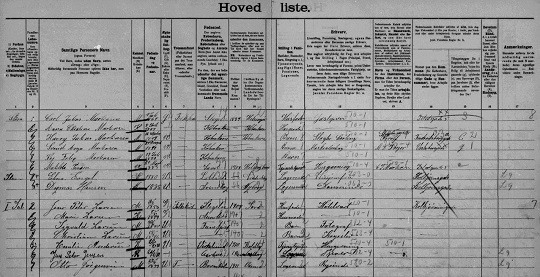
Germany – FamilySearch.org has created a new indexed record collection of civil records from the district of Schleswig-Holstein. The some 135,000 records in this collection span the years from 1874 to 1983 and consist of birth records, marriage records and official death records. Schleswig-Holstein is the northern most state in Germany. It borders Denmark. These records can be searched by first name and last name. Access is free. [Historic Schleswig-Holstein Civil Registration Records]
Hungary – FamilySearch.org has added an additional 50,000 civil registration records from Hungary. These records span the years from 1895 to 1980 and contain birth records up to 1920, marriage records up to 1950 and death records up to 1980. A typical birth record in the collection lists the name of the person, date of birth, place of birth, date of registration, gender, religion, parent’s name, gender and religion and the mother’s age. The records can be searched by first name and last name. Access is free. [Hungarian Birth Records]
US – FamilySearch.org has started a new collection of Laredo, Texas index of arrivals records. These are mainly Mexican immigrants who passed into the United States at Laredo. The some 615,000 names in this collection span the years from 1903 to 1929. These records can be searched by first name and last name. Access is free. [Laredo Texas Immigration Records]
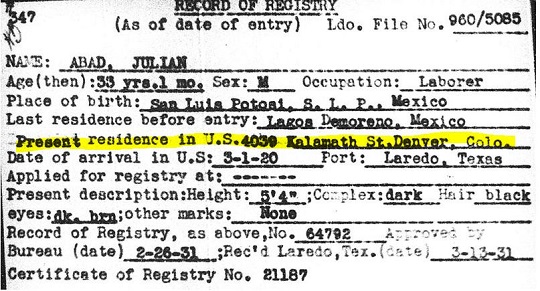
Ireland – The Irish government through their IrishGenealogy.ie website has just released this week a major new collection of historic birth, marriage, and death records from the General Register Office (GRO). The birth records are over 100 years old, the marriage records are over 75 years old and the death records are over 50 years old.
Currently, the birth records cover the time period from 1864 to 1915, the marriage records span the years from 1882 to 1940 and the death records are from 1891 to 1965. Work is ongoing to extend the marriage records back to 1845 and the death records back to 1864.
Most of the records also provide access to an image of the original register page, as shown below.
The GRO is the official keeper of civil records in Ireland and IrishGenealogy.ie is the official genealogy website of the Irish government. This release is big news for anyone with Irish ancestors. These records can be searched by first name, last name, civil registration district, year range and type of record (birth, marriage or death). Access is free. [Free Irish Birth Marriage Death Records]
Please note the IrishGenealogy.ie website is experiencing extremely heavy traffic – not surprising given this major new collection. You might experience some service disruptions. Just be patient and try again later. Happy hunting!
England – FindMyPast has put online the 1842, 1851 and 1861 London Post Office directories. In total, these directories contain some 1.5 million names organized into commercial directories, trade directories, a parliamentary directory, a street directory and a court directory. At the moment, these directories are not searchable by keyword. However, the directories are listed alphabetically by surname. Access is by subscription. [London Post Office Directories]
You can use our City Directory Abbreviations dictionary to help you read/decipher the entries.
England – FindMyPast has put online a collection of over 1.1 million War Office records covering British Army casualty lists from World War II. These lists cover soldiers and nurses who were reported as killed in action, wounded, prisoner of war, missing, died of wounds, involved in accidents or who had fallen dangerously ill. The collection comes from the National Archives and covers the various theatres of war, including the Western Dessert, Malaya, Italy, Greece and France. It also includes soldiers who were killed or seriously injured at overseas stations outside the main theatres of war.
Each transcript lists the person’s name, rank, service number, regiment, status and previous theatre of war (if applicable). Other information, such as date of death is also often included as well.
These records can be searched by first name, last name, year, service number, rank, regiment and additional keywords. Access is by subscription. [British Army World War II Casualty Lists]
June 2016
England and Wales – TheGenealogist has released a few early British telephone directories. Included with this release are the 1907 national directory (which covers the entire country) and the 1938 South Wales directory. Previously, TheGenealogist had also released the 1899-1900 national directory.
In the early days of the telephone, the only people who could afford them tended to be wealthy individuals, doctors and merchants (who needed them for their business). However, by the time of the release of the 1938 South Wales directory, telephone use had spread to some middle class households.
Telephone directories from this period tended to list a person’s name, their occupation and address, as shown below. Access to this collection is by subscription. [Early British Telephone Directories]

Italy – FamilySearch.org has launched a new browsable image collection of civil registration records from the Rome capital region. This massive new collection has 4.2 million images consisting primarily of official government birth, marriage and death records. The collection also contains some marriage banns and residency records. The records span the years from 1863 to 1930. The images in the collection are sorted by province (Rieti, Roma and Viterbo), then by commune or frazione and then by type of record and year.
These records come from the State Archive of Roma. Many genealogists will be happy to see that FamilySearch has put this collection online. Access is free. [Historic Rome Birth Marriage and Death Records]
Belgium – FamilySearch.org has recently indexed a number of Belgium civil registration records. The largest new addition (about 200,000 records) comes from Liège. The Liège records consist of government birth, marriage and death records. There are also some marriage proclamation records in the collection. It spans the years from 1621 to 1914. The records can be searched by first name and last name. Access is free. [Historic Liège Birth Records]
Australia – FamilySearch.org has indexed an additional 70,000 civil registration records from Tasmania. These records span the years from 1839 to 1938. They consist of both government records and church records. Please note these are records from registries, as shown below. Access is free. [Tasmania Birth Records]
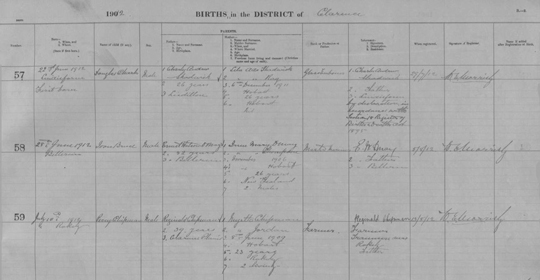
Israel – The Israel Genealogy Research Association (IGRA) continues to add some very interesting new genealogy record sets to their ever expanding collection. The latest additions include miscellaneous lists dealing with immigration from Europe to Palestine during 1942-43 (the middle of World War II).
Included in the latest update are such things as lists of women and children in 1942 authorized to enter Palestine from Germany, Czechoslovakia, Romania, Latvia, Hungary, Holland, Lithuania and Poland; lists of immigrants from Hungary to Palestine in 1947 and lists of donors who sent care parcels to Jews in Poland (through the Jewish Joint Distribution Committee) immediately after WWII.
The IGRA website is available in both Hebrew and English. In total, there are now some 745,000 records on the website across more than 271 databases. All the names in the databases have been transliterated into English so that you can do full searches in English. The link takes you to the page that describes how the whole process works. Access is free after registration. [Israel Genealogy Research Association]
US – We don’t normally talk about when subscription websites offer free trial periods because the trial periods tend to be very short and/or the trial comes with strings attached. However, this one caught our eye.
The website American Ancestors (run by the New England Historic Genealogical Society) is offering full access to all 23 databases devoted to New York State genealogy records. Access is free for the entire month of June. All that is required is to register as a guest user.
The video below provides a good overview of the various New York State genealogy resources held by the website. [American Ancestors New York State Genealogy Records]
England – The website Lancashire BMD continues to add new Lancashire genealogy records at a steady pace. Some of the latest additions include 6,000 birth records from Radcliffe (1934 to 1943) 5,000 burial records from Elton (1888 to 1909) and 4,000 birth records for Trafford. In total, the website has 9.8 million birth records, 4.5 million marriage records and 5.8 million death records. Access is free. [Lancashire BMD]
England – FindMyPast has released an interesting collection of prison records from Plymouth, Devon. These are records of both prisoners and prison officers. The records originate from the Plymouth and West Devon Record Office. The 13,000 records in this collection span the years from 1832 to 1919.
The records come from a variety of sources including prisoner registers, calendars of prisoners and registers of prison officers. For prisoners, the records usually list the name of the prisoner, details on their offense, their sentence and a physical description of the prisoner. For prison officers, it usually lists the name of the officer, rank, where they worked and their salary. Access to this collection is by subscription. [Historic Plymouth Prison Records]
May 2016
US – FamilySearch.org has indexed 106,000 New Hampshire birth certificates spanning the years from 1901 to 1915. These records come from the New Hampshire Division of Vital Records. See the sample image of a New Hampshire birth record below. The records can be searched by first name and last name. Access is free. [Historic New Hampshire Birth Certificates]
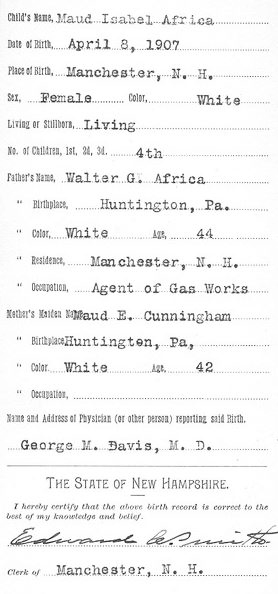
US – The American Jewish Joint Distribution Committee (JDC) maintains an archive for genealogists, personal historians and scholars that contain records of people who have received aid from JDC over the years. The core holdings contain records of displaced persons from World War II, although the database spans the years from 1914 to 1973.
The archive continues to grow and JDC continues to add more material to their online collection (their physical archive consists of over 3 miles of text documents, over 100,000 photographs and a research library containing 6,000 books). So far 500,000 names, 2.6 million digitized pages and 67,000 photographs have been put online. Access is free. [JDC Archive]
New Zealand – FamilySearch.org has indexed the burial records from Waikumete Cemetery in Auckland. This is New Zealand’s largest cemetery and since 1908 it has served as the main cemetery for the Auckland region. The records in this collection span the years from 1886 (when the cemetery was first established) to 1948. There are roughly 27,000 records in this collection.
A typical burial record (see image below) lists the name of the deceased, age, date and place of death and burial, occupation, cause of death, place of birth, religion and years in the province. Please note that if you happen to be looking through historic documents that the original spelling of the cemetery was Waikomiti. These records can be searched by first name and last name. Access is free. [Waikumete Cemetery Records]
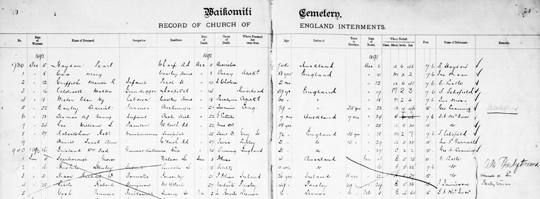
Ireland – FindMyPast has added an additional 500,000 pages this month to their Irish newspaper collection. Four new titles were recently added, including the Belfast Weekly News (1897-1898 and 1904-1914). In addition, seven other titles saw significant new additions. Most notable was the Northern Whig (almost 200,000 additional pages) and the Derry Journal.
With these new additions, FindMyPast’s Irish newspaper collection consists of 119 different national, regional and local newspapers. The collection can be searched by first name, last name, place, country, newspaper and approximate date range. Access is by subscription. [Historic Irish Newspapers]
South America – Vanderbilt University has established a website devoted to digitizing and preserving documents related to enslaved Africans and Afro-descended peoples in the Americas. The website is called Ecclesiastical & Secular Sources for Slave Societies. Most of the documents on the website relate to Brazil and Columbia, with some additions covering Cuba and Spanish Florida.
The database currently contains nearly 400,000 documents from an incredibly diverse range of sources. Many are from various ecclesiastical sources and contain such things as baptism records.
At the moment, the documents do not appear to have not been transcribed. The images are organized by country and then by type of document. Access is free. [Ecclesiastical & Secular Sources for Slave Societies]
UK – FamilySearch.org has put online the cemetery registers from Oldham, Lancashire. Oldham is now part of greater Manchester and this collection covers the following cemeteries: Hollinwood, Failsworth, Royton, Crompton, Chadderton, Lees and Greenacres.
In total, there are some 480,000 records in this collection, which spans the years from 1797 to 2004. A typical record lists the name of the deceased, age, date and place where death occurred, date and place of burial and the grave number. The records can be searched by first name and last name. Access is free. [Oldham Burial Records]
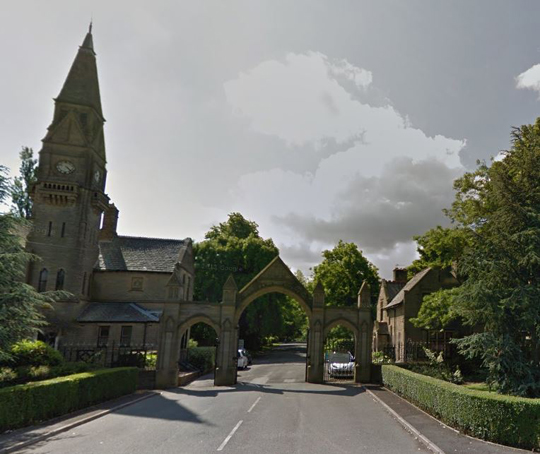
UK – FindMyPast has put online new marriage and burial records from Westminster. In total some 410,000 new marriage records and 520,000 burial records have been added this month. The burial records can be searched by first name, last name, burial year and burial place. Access is by subscription. [Westminster Burial Records]
UK – FindMyPast has put online British Royal Navy and Royal Marine records related to the 1916 Battle of Jutland. This was the largest naval battle of World War I. It occurred in the North Sea on 31 May and 1 June 2016. The battle involved roughly 250 ships and 100,000 men from both the British and German sides. Britain lost over 6,000 men in the battle.
There are various different types of records in this collection. Most list the person’s name, rank, regiment, service number, year of birth and place of birth. The original document is also included with most records. The records can be searched by first name, last name, year of birth and service number. Access is by subscription. [Battle of Jutland Records]
South Africa – FamilySearch.org has created a new image collection of church records from the Lesotho Evangelical Church in South Africa (LECSA). LECSA is one of the oldest Protestant churches in Africa, having been established by the Paris Evangelical Missionary Society in 1833. The church currently has some 350,000 members across over 100 parishes. This online collection spans the years from 1874 to 1983 and contains primarily membership lists, marriage records and baptism records.
The membership lists are particularly interesting because they contain the name of the member, date of birth, baptism date, age, church name and (something really interesting) the name of close relatives. The older baptism records are more like a combination birth/baptism record and list the name of the child, date of birth, place of birth, parent’s names, date of baptism, place of baptism and the person who performed the baptism.
The images in this collection are organized first by district and then parish and then type of record. A sample marriage record is shown below. Access to the collection is free. [Lesotho Evangelical Church Records]
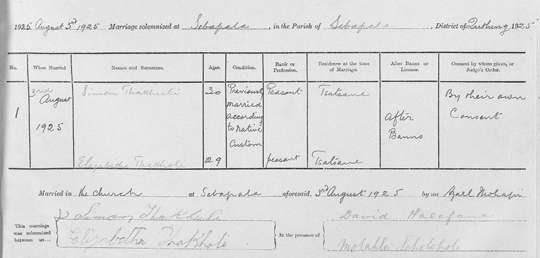
New Zealand – The popular New Zealand website Papers Past is testing a new beta version of the website. The objective is to improve the search tools and provide more kinds of content. For those who are not familiar with Papers Past, it is the definitive source for researching historic New Zealand newspapers. It has over four million pages of digitized content.
The website now also has historic magazines and journals, letters and diaries and parliamentary papers. It is run by the National Library of New Zealand. The website can be searched by keyword (like name), date range and title. Did we mention that it is free? [Papers Past]
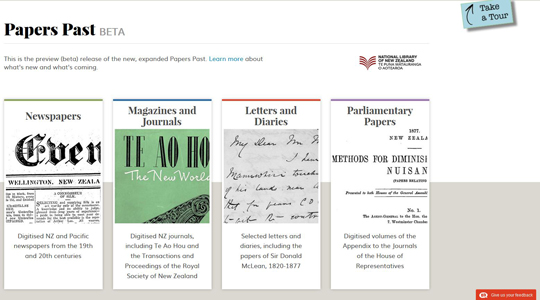
US – FamilySearch.org has indexed some 172,000 Arkansas ex-Confederate pension records. These records date from 1891 to 1939 and come from the Arkansas State Auditor (who was responsible for managing and disbursing the pension payments). Although these records don’t provide much detail (see image below), they are a fascinating record set. This collection can be searched by first name and last name. Access is free. [Arkansas ex-Confederate Pension Records]
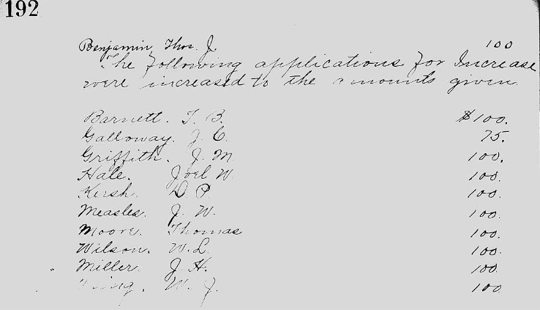
France – FamilySearch.org has created a new collection of military conscription records from Saône-et-Loire, France. The 245,000 indexed records in this collection span the years from 1867 to 1940 (which covers World War I and the beginning of World War II).
Basically this collection is a register of all men in the region who were 20 years old or older and who were eligible for military conscription. The registers come from the Saône-et-Loire Departmental Archive.
A typical record lists the first name, last name, age, occupation, nationality and position in the household. The records can be searched by first name and last name. Note that for legal/privacy reasons, only people born more than 120 years ago will be found in the listings. Access is free. [Saône-et-Loire Military Conscription Records]
Canada – FamilySearch.org has created a new browsable image collection of Saint John, New Brunswick burial permits dating from 1889 to 1919. There are roughly 14,000 images in this new collection and each image typically lists four permits. Thus, this collection covers roughly 50,000 burials. The images are organized by date.
A typical burial record in this collection (see image below) lists the name of the deceased, date of death, gender, marital status, spouse’s name (if married), color, age, residence, occupation, place of death, place of birth, name of father, birthplace of father, place of internment and cause of death. Access is free. [Saint John Burial Records]
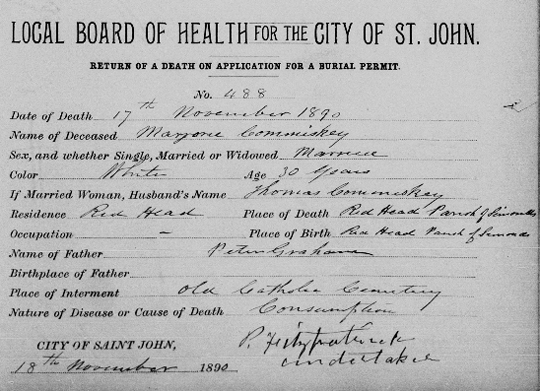
Paraguay – FamilySearch.org continues to expand their collection of family records from South America. The latest addition is from Paraguay. These are Catholic Church records from 1754 to 2015. The records can be searched by first name and last name. Included are the usual baptism, confirmation, marriage and death records. Also included are some parish census records and pre-marriage investigation records. Access is free. [Paraguay Parish Records]
Canada – The website BritishColonist.ca has increased their online collection of historic newspapers from Victoria, British Columbia. The collection now spans the years from 1858 to 1950 (the original release only went to 1910) and includes the British Colonist, the Daily British Colonist and the Daily Colonist. These are all essentially the same newspaper that has changed names over the years. It is still published today in Victoria as the Times Colonist.
The most recent addition to the online archive (1941 to 1950) covered some 67,000 pages. Dave Obee, a well-known Canadian genealogist, is the current editor-in-chief of the Times Colonist.
The Times Colonist is the oldest newspaper in Western Canada. It is a wealth of information for anyone researching Victoria, Vancouver Island and the surrounding areas. The database can be searched by keyword. Access is free. [Historic Victoria Newspapers]
England – FindMyPast has increased the size of their Yorkshire parish record collection. An additional 2.2 million baptism, 1.4 million marriage and 1.5 million burial records have been added to the collection. The marriage records can be searched by first name, last name, birth year, marriage year, marriage place, county and spouse’s first and last name. Access is by subscription. [Historic Yorkshire Marriage Records]
US – FindMyPast has released another tranche of US marriage records. This tranche contains some 10 million marriage records primarily from Indiana, Illinois, New York, Maine and Pennsylvania. These records are released as part of their partnership with FamilySearch. The records can be searched by first name, last name, year, place, spouse’s name, mother’s name and father’s name. Access is by subscription. [Historic US Marriage Records]
April 2016
Ireland – FindMyPast has added another 525,000 articles to their historic Irish newspaper collection. One notable new title comes from Northern Ireland – Lisburn Herald and Antrim and Down Advertiser. It covers the time period from 1891 to 1896.
FindMyPast’s Irish newspaper collection now contains 115 different titles spanning the years from 1708 to 1955. In total, there are 20 million searchable articles. Access is by subscription. [Historic Irish Newspapers]
England- FindMyPast has added to their collection of Dorset parish records. Included in this update are baptism, marriage and burial records. The website now contains some 390,000 Dorset baptism records, some 650,000 marriage records and some 380,000 burial records. Access is by subscription. [Historic Dorset Parish Records]
Australia – Just in time for ANZAC day on April 25th, Ancestry has released a new collection of Australian World War II military service records. These records cover army, navy and air force personnel. A typical record lists the following: full name, date of birth, place of birth, service number, marital status, religion, occupation (prior to enlistment), next of kin, any prior military service, details of any injuries and any transfers between units. These records can be searched by first name, last name, keyword and service number. Access is by subscription. [Australian WWII Military Service Records]
Please note that in order to access the full original service file, a request must be made to the National Archives of Australia. In fact, unless you are already an Ancestry subscriber, you are better off going directly to the National Archives website. They are the keeper of the original records. As well, you can search their website for free. [Australia Military Service Files]
US – A very interesting new website called Reclaim The Records has been successful in putting online the New York City marriage index from 1908 to 1929. These are essentially microfilms of the original records organized by year.
The website has a unique way of getting historic genealogy records online. Basically, they file what is known in the US as a Freedom of Information Law (FOIL) request. The objective is to compel the government to release historic ancestral records. If they are successful, they then post the records on Archive.org for free for anyone to use or download.
The New York City marriage index was their first successful pilot attempt. We are sure there will be many more record sets from this group going forward (they are already actively working on several additional FOIL filings). [Historic New York City Marriage Records]
If you are interested/intrigued by what Reclaim The Records does then we would encourage you to check out their website. They explain in clear terms what they do and why. They are also looking for more people to help them with their cause. [Reclaim The Records]
Australia – FindMyPast has put online Queensland birth and marriage records. There are some 930,000 birth records that span the years from 1829 to 1919 while the 700,000 marriage records are from 1829 to 1939. When looking at the birth records, it is important to realize that birth registrations in Queensland were not mandatory until March 1856. Therefore, it is perfectly possible to have someone born before March 1856 who does not have an official birth certificate. Also, be aware that Queensland was part of New South Wales until 1859. Finally, for a complete list of when different record sets first became available in various parts of Australia, please see this list.
As well, given how isolated some communities were in the 1800s, it is possible that a birth might be registered some time after the actual date. In particular, someone born in December might not be registered until January of the next year. Be aware of this when searching for the records and always use a wide date range in your search. The same logic applies when searching marriage records.
These records can be searched by first name, last name and registration year. Birth records can also be searched by father’s first name and mother’s first name. Please note that these are transcripts of the original records. A copy of the original record can be ordered from the Queensland government. Access is by subscription. [Historic Queensland Birth Records]
England – FindMyPast has added to their British Newspaper collection with an additional 3.9 million articles. The latest update includes more articles from some of the larger cities, such as the Birmingham Daily Gazette, the Sheffield Independent and the Newcastle Evening Chronicle. The newspapers can be searched by first name, last name and keyword. In addition, it is possible to filter the search results by newspaper title and date range. Access is by subscription. [Historic British Newspapers]
FindMyPast has also put out a useful video to help you get the most out of their newspaper collection.
England – FindMyPast has put online a collection of British Royal Navy & Royal Marines pension records. This collection of some 911,000 records spans the years from 1704 to 1934. The information contained in each record varies depending on the time period, but in general includes such information as the full name, years of service, year joined the navy, service number, home parish, date of death, name of next of kin and pension details. These records can be searched by first name, last name. Access is by subscription. [Royal Navy Pension Records]
England – TheGenealogist has put online 900,000 new Essex parish records. These are primarily baptism, marriage and burial records. This brings their collection of Essex parish records to some 2.5 million. The records span the years from 1512 to 2005. Access is by subscription. [Essex Parish Records]
UK and Ireland – The popular website Genuki (#81 on our Top 100 Websites of 2016 and one of the top free genealogy websites in the UK) is going through a major overhaul. After 21 years, the website is working towards improving the user experience with new stylized pages making it easier for users to find their ancestors. Details can be found on the Genuki news page. Check it out. [Genuki]
Ireland – The Irish Genealogical Research Society through their website Irish Ancestors has launched a new initiative to capture the personal stories of Irish-born ancestors. If you have an interesting tale to tell about one of your Irish ancestors, then this is the place to do it. [Irish Ancestor’s Stories]
Ireland – FindMyPast has put online Quaker birth, marriage and death records going back as far as the mid 1600s. Also included in the broader collection are Quaker school records, migration records and congregational records. Although Quakers were a very small proportion of Irish society, this collection may be worth checking out. There are 28,000 birth records alone. The records can be searched by first name, last name, year and (in the case of birth records) mother and father’s first name. Access is by subscription. [Irish Quaker Birth Records]
March 2016
England – FindMyPast has added an additional 527,000 records to their collection of national school admission registers. The records come from multiple archives covering various parts of the country. This collection spans the years from 1870 to 1914 and contains such things as school admission records, log books (which usually record attendance), school visitor lists and other lists associated with the daily activities of a school.
These records can be very valuable in providing useful background information (beyond the school record, of course). Some examples would include a father’s occupation, exam results and potential long absences due to illness. This collection can be searched by first name, last name, year, town and school name. Access is by subscription. [Historic English School Records]
England – Deceased Online over the next couple of weeks will be adding the cemetery and crematorium records from the Calderdale Council in West Yorkshire. In total, these records will encompass seven cemeteries. The records for Brighouse Cemetery and the Halifax General Cemetery have already gone online. The records go back as far as 1842. Access is by subscription. [Halifax West Yorkshire Cemetery Records]
Australia – FindMyPast continues to increase their collection of Australian records. They have just put online Western Australian birth, marriage and death indexes. Note that these are indexes only. The birth index alone contains over 106,000 names. It lists the name of the individual, year of birth, place of birth and the registration number.
Once you have the registration number, you can apply to the government for the full birth record. Please note that Western Australia began keeping civil records of births, marriages and deaths starting 1 September 1841. To research ancestors prior to that date, it is necessary to consult church records. Access is by subscription. [Western Australia Birth Index]
Ireland – FindMyPast has released an interesting collection of Irish Revenue Police records. The Irish Revenue Police were formed to combat bootlegging and illegal distillation of alcohol from the years 1830 to 1857 (when the force was disbanded). This record set consists of some 37,000 records of the men who served with the force. Many members of the Irish Revenue Police eventually became members of the Irish Constabulary.
Each record lists the name of the person, where they worked and the date. Further details include lists of new appointments (so you can know when they joined), date of transfers to other districts and discharge records. Access is by subscription. [Irish Revenue Police Records]
Ireland – Ancestry has put online two collections of records from the UK National Archives related to the Irish independence struggle. The first collection consists of court martial papers from 1916 to 1922 related to events that began with the Easter uprising of 24 April 1916.
Some 2,000 names are in this collection of people who were arrested and tried under martial law. The second collection consists of intelligence profiles collected by the Dublin Metropolitan Police and the Royal Irish Constabulary of people suspected of being disloyal to the British Crown. This collection consists of photographs, newspaper clippings, notes on Sinn Fein meetings, etc. This collection contains 800 names and over 22,000 images.
Although you are not likely to find an ancestor in either collection, they do make for fascinating reading. Access to both collections is by subscription. [Irish Independence Struggle Records]
US – The public library in Caro, Michigan has digitized and put online historic copies of the local newspaper The Tuscola County Advertiser (1868 to 1943). They have also put online the local high school yearbooks for the years 1922 to 2006. Caro is located northeast of Flint, Michigan. Both collections can be searched by keyword (such as a name). Access is free. [Caro Michigan Historic Newspapers]
England – TheGenealogist has added over 150,000 World War II Prisoner of War records to their military collection. These are British military personnel held in German prisoner of war camps from 1939 to 1945. The records provide such information as name, service number and regiment. Access is by subscription. [World War II Prisoner of War Records]
England – Deceased Online has added cemetery records from East Staffordshire. The two new cemeteries are Stapenhill and Rolleston. The records date from 1866 to 1997. Access is by subscription. [East Staffordshire Cemetery Records]
Scotland – The website ScotlandsPeople has released the 1930 valuation rolls for Scotland. This is the latest in a long line of valuation rolls that have been released by ScotlandsPeople. The 1930 valuation roll contains some 2.5 million names and provides a glimpse into Scottish life between the two world wars. Access is by subscription. [Scotland 1930 Valuation Rolls]
Ireland – FindMyPast has put online ten million Irish Roman Catholic parish records. Parish records are particularly important in Ireland because of the number of lost/destroyed/missing census records. These are baptism, marriage and burial records that can be searched by first name, last name, year and location. Access is by subscription. [Irish Catholic Parish Records]
Alternatively, the largest collection of Irish parish records can be found at the website RootsIreland, which is run by the Irish Family History Foundation. Access is by subscription. [RootsIreland]
February 2016
US – FamilySearch.org in concert with the Afro-American Historical and Genealogical Society (AAHGS) and the Smithsonian National Museum of African American History and Culture have announced the project to transcribe the Freedmen’s Bureau records has reached the important milestone of one million transcribed records. Nearly 16,000 volunteers have contributed to this effort. The target is to get the entire collection online by the middle of June 2016.
This is a major announcement for anyone with African American ancestors. It will allow people to extend their family histories to dates before the 1870 national census.
We have talked extensively about Freedman’s Bureau records before. For those who are not familiar with this incredibly important genealogical resource, please see the video below. [Discover Freedmen] [Afro-American Historical and Genealogical Society]
US – FamilySearch.org has created new collections of Idaho birth indexes (1861 to 1911) and death indexes (1938 to 1961). In total, there are some 60,000 new birth indexes and some 118,000 death indexes. These records come from the Idaho Bureau of Vital Records and Health Statistics. A typical birth index lists the name of the person, date and place of birth, father’s name, father’s birthplace, father’s age, mother’s name, mother’s birthplace and mother’s age.
The death certificate indexes however just list basic information since the full death certificates are not yet available. FamilySearch does however have a separate collection of full death certificate records for Idaho for the earlier period from 1911 to 1937, as shown in the image below. Access is free. [Idaho Birth Index] [Idaho Death Index 1938 to 1961] [Idaho Death Records 1911 to 1937]
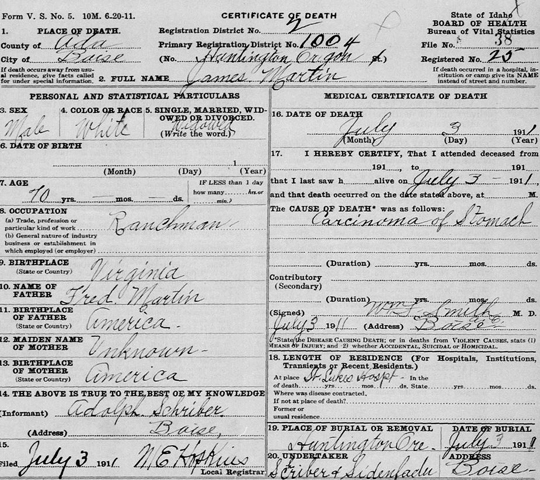
US – Newspapers.com (an Ancestry company) has digitized and put online historic newspapers from Poughkeepsie, New York. Included in this collection are the Poughkeepsie Journal (1785 to 2016) and the Poughkeepsie Eagle-News (1861 to 1974). These two journals combined provide some 1.3 million pages of information on the Hudson Valley. Access is by subscription. [Historic Poughkeepsie Newspapers]
US – FamilySearch.org has indexed an additional 3.7 million Cook County, Illinois death records. These records date from 1878 to 1994 (although the records are missing for the years 1910 to 1915). Please note this collection excludes the city of Chicago records. This collection can be searched by first name, last name, gender and race. Access is free. [Cook County Illinois Death Records]
US – FamilySearch.org has indexed an additional 312,000 marriage records from various counties in Kansas. These county marriage records span the years from 1855 to 1911 and can be searched by first name and last name. Access is free. [Kansas County Marriage Records]
As well, FamilySearch.org has created a new index of Kansas City marriage records. It contains some 185,000 names and spans the years from 1811 to 1911. Please note this is an index only. The index can be searched by first name and last name. Access is free. [Kansas City Marriage Index]
England and Wales – FamilySearch.org has released an additional 2.5 million records from the 1861 England and Wales census. The data was provided by FindMyPast as part of the data exchange agreement between the two entities. It is not clear what percentage of the records from this census has gone online at FamilySearch.
This census covers England, Wales, the Isle of Man and the Channel Islands. It was taken on 7 April 1861. Please note that records from this census are missing from the following regions: North Aylesford, Kent; Northfleet, Kent; and from Shoreditch, Middlesex.
Only people who were home on the night of this census are listed in the forms. So if you had a relative that was in the navy, merchant marine, army or had any job that required them to travel or work in the evening then they may not be listed in this census. These records can be searched by first name, last name, gender, place and relationship to the head of the household. Access is free. [1861 England Census]
England – FindMyPast has enhanced their 1939 Register, which was just released with much fanfare last October (see the October 2015 commentary below). Now the collection can be browsed by county, borough/district, piece number and ED letter code. This provides a complement to performing name searches for those who may have trouble finding their ancestors but know roughly where they lived. Access is by subscription. Just a reminder that the 1939 Register is now included with the 12-month subscription package at FindMyPast. [Browse 1939 Register]
England – FindMyPast has released a collection they call Devon, Plymouth and West Devon Parish Chest Records. Apparently, this is an eclectic mix of documents from parish chests of Plymouth and West Devon. This includes such things as the levying of taxes, the selection of juries and even pew rentals within a given church. Just to be clear, these are not baptism, marriage or burial records.
At one time, Anglican churches in England performed many duties that today would be associated with the government (such as collecting taxes for the crown, maintaining local roads, etc.). The records were usually kept in a locked chest at the local parish church, thus the name parish chest records.
The records in this collection list the individual’s name, the type of event and the date of the event. The records span the years from 1556 to 1950. There are about 434,000 records in this collection. Each record includes a transcript and an image of the original parish record. Access is by subscription. [Plymouth and West Devon Parish Chest Records]
Wales – FindMyPast has added 6.4 million new articles to their historic British newspaper collection. The latest addition includes 26 brand new titles, of which 19 are from Wales. If you are looking for a particular newspaper, use the By Newspaper filter to bring up all the titles. Alternatively, you can search by place and county. Access is by subscription. [Historic Welsh Newspapers]
Liberia – FamilySearch.org has created a new browsable image collection of Liberian marriage records. In total, there are some 25,000 images in this collection, which spans the years from 1941 to 1974. These records come from the National Archives in Monrovia, Liberia and consist of marriage applications, marriage licenses, marriage returns and various other types of documents that certify marriage. Below is a sample two-page marriage application, which contains lots of useful information for genealogists. Access is free. [Liberian Marriage Records]
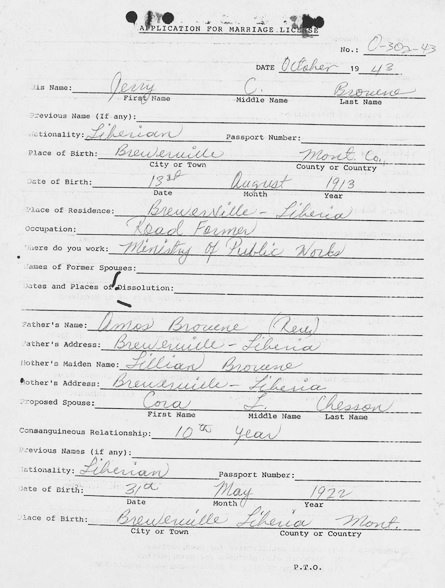
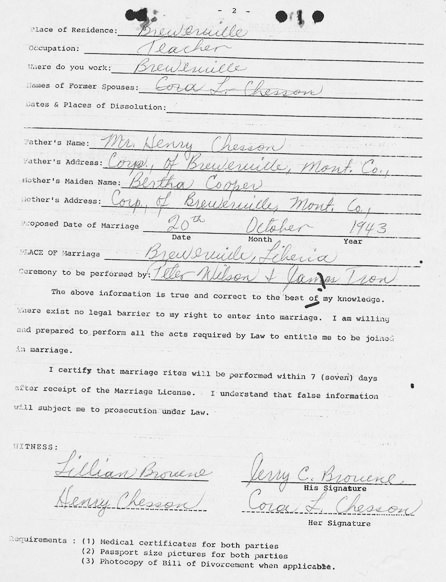
Ireland – This is an advance notice. Both FindMyPast and Ancestry are planning to release some 10 million Catholic parish records in March. The records will span the years from roughly the mid 1700s to 1900 and cover over 1,000 parishes. It appears that these will be primarily baptism and marriage records (with a small number of burial records) that have been transcribed from the collection held by the National Library of Ireland. The records cover both Northern Ireland and the Irish Republic.
At the moment, FindMyPast has about 80 million Irish records and Ancestry has about 45 million Irish records so these new records in March will be a substantial addition for both firms.
The video below from FindMyPast provides an excellent overview of Irish records in general and highlights why land records and court records are very important to anyone with Irish ancestors.
Canada – The Alberta Genealogical Society continues to grow their homestead database. It now contains some 520,000 entries dating from as early as 1870 to as late as the 1950s. Most of the records in the database are essentially indexes and pointers to land records held at the Provincial Archives of Alberta. The index, however, does indicate the section, township, range and meridian of the farm. This provides sufficient information to be able to narrow down the location of your ancestor’s farm.
In the Alberta Genealogical Society collections there are lists of people who applied for land patents (basically a land grant), lists of people involved in the homesteading process (both those who completed the process and those who abandoned the process) as well as various other lists. Land records are a valuable source for anyone tracing early ancestors in Alberta. The indexes can be searched by first name and last name. Access is free. [Historic Alberta Land Patent Records]
For those who want to understand the Alberta township survey system, try this link from the Alberta government.
England – FindMyPast has added over 240,000 records to their British Merchant Seamen collection. These records span the years from 1918 to 1941 (basically from the end of WWI to the middle of WWII). These records are essentially index cards that the Registrar General of Shipping and Seamen used between the two wars to track merchant seamen who served on British merchant vessels.
The typical record lists the name, year of birth, place of birth and rank of the seaman. Sometimes additional information is given, such as a physical description and address of next of kin. Some even contain the signature of the seaman. The records can be searched by first name, last name, year of birth and birth country. Access is by subscription. [WWII British Merchant Seamen]
New Zealand – FindMyPast has put online a small but important collection of New Zealand registered teachers for the year 1906. The collection is from an official government list of some 4,000 teachers and includes the teacher’s name, gender, district position, school name and level of qualification. The collection can be searched by first name, last name and district or region. Access is by subscription. [New Zealand 1906 Teachers List]
New Zealand – This week, FindMyPast has added some 3 million more birth, marriage and death index records from New Zealand. The birth and marriage indexes cover records from 120 or more years ago. The death index covers anyone who died at least 50 years ago. Please note these are indexes only and contain only basic information such as (for the birth index) name, year of birth, mother’s name, father’s name and registration number. Access is by subscription. [New Zealand Birth Index]
Alternatively, you can go to the official New Zealand government website to order the full official birth, marriage and death records, which can be searched by family name or registration number (which the FindMyPast index will provide). Information available includes:
• Births that occurred at least 100 years ago (50 years ago for stillborn births).
• Marriages that occurred at least 80 years ago.
• Deaths that occurred at least 50 years ago (or for anyone who died and was born at least 80 years ago).
There is no cost to search the records but there is a charge to receive a copy of the official legal document. [Official Historic New Zealand Birth Marriage Death Records]
US – FindMyPast has released 33 million historic US marriage records. The records are being released in partnership with FamilySearch. Eventually, this collection will consist of some 100 million records. According to FindMyPast, some 60% of the records in this collection have never before been published online.
The records span the years from 1650 to 2010. Each record includes a transcript plus images of the original documents. This collection can be searched by first name, last name, date range, place, state, county, spouse’s name, father’s name and mother’s name. In other words, there are lots of different ways to search. Access is by subscription. [Historic US Marriage Records]
England – FindMyPast has added a variety of Norfolk County baptism, marriage and burial records. In total, there are 1.8 million new baptism records, some 950,000 new marriage records and 1.4 million new burial records. The records seem to go back as far as 400 years ago. Each record consists of a transcript plus an image of the original record. The records can be searched by first name, last name, date range and parish. Access is by subscription. [Norfolk Baptism Records]
January 2016
US – The Indiana State Library continues to add more digitized newspapers to their Hoosier State Chronicles website. The collection now contains over 100,000 issues and some 780,000 pages from many small-town newspapers across Indiana. The website has advanced search features, which allow users to perform full text search by publication name and date range. Access is free. [Historic Indiana Newspapers]
UK – Good news bad news. Good news - starting 16 February, the UK 1939 Register will be included within the 12-month subscription packages at FindMyPast. Bad news - FindMyPast is also increasing the price of new 12-month subscriptions soon (30th January). [FindMyPast]
UK – FindMyPast has made a substantial new addition to their collection of Isle of Man records. The latest update includes 422,000 new birth and baptism records (1600 to 2010), 167,000 new marriage records (1598 to 1979) and 249,000 new burial records (1598 to 2011). Access is by subscription. [Isle of Man Birth Records]
US – Readex has launched their second major collection of African American Newspapers. Formally called the African American Newspapers Series 2 (1835-1956), this collection was digitized from the holdings of the American Antiquarian Society, Center for Research Libraries, the Library of Congress and the New York Public Library.
Included in the collection are rare titles such as the Chicago Bee (Chicago), The Louisianian (New Orleans), The Pine and Palm (Boston), New York Age (New York) and the Harlem Liberator (New York).
Readex is available at most public libraries. They do not sell individual subscriptions.
UK – TheGenealogist has put online a complete collection of searchable parish tithe maps and schedules for both England and Wales. This will help you determine the correct parish for your ancestors. This is an important consideration when searching for historic parish records, especially since parish boundaries sometimes changed over time.
The schedules linked to the parish maps provide further detail of each parish, such as land use in the region. Some maps even reveal individual buildings, houses, fields, rivers, streams, woods, etc. This can be invaluable when you want to narrow down your research to the last mile. Access to TheGenealogist is by subscription. [English Parish Tithe Maps]
US – FamilySearch.org has created a new collection of Alaska vital records. These are birth, marriage, death and divorce records that span the years from 1816 to 1959. About 57,000 records have been indexed and put online, with more expected to become available.
So far, most are marriage and death certificates from the 1900s. The records in this collection can be searched by first name and last name. This is the first time we have seen early Alaska vital records go online. Access is free. [Early Alaskan Vital Records]
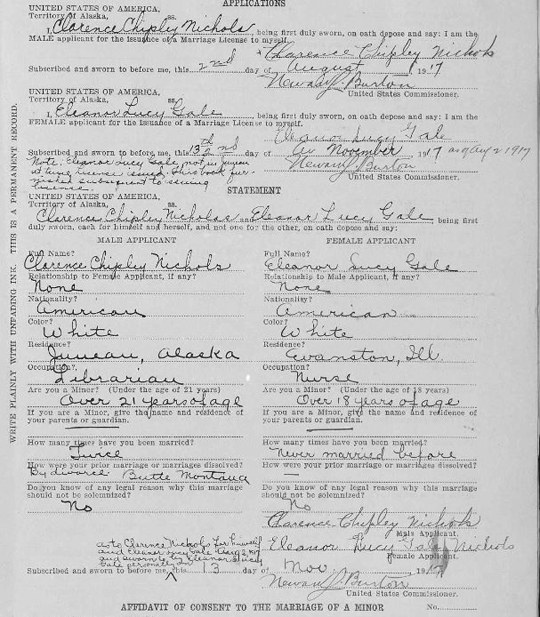
UK – TheGenealogist has released over 3.6 million parish records from Norfolk County. These are baptisms, banns, marriages and burial records that cover many of the parishes in Norfolk. This is the first part of a two-part release of Norfolk parish records as part of TheGenealogist’s agreement with the Norfolk Record Office. The link provides access to the complete list of parishes and dates that are covered by this release. Access is by subscription. [Norfolk Parish Records]
UK – FindMyPast has released a collection of Plymouth and West Devon electoral registers. These registers span the years from 1780 to 1983 and consist of parish and parliamentary electoral rolls, electoral registers and lists of county voters. These records have been digitized in partnership with the Plymouth and West Devon Record Office.
A typical record lists the name, year, electoral event and place of the election. Some records even record who your ancestor voted for. Please see our article Searching Electoral Rolls for Ancestors to get the most out of this collection. Access is by subscription. [Historic Plymouth and Devon Electoral Rolls]
UK – The UK National Archives have come out with a very useful video on navigating the 1939 register, which we have talked about previously. It is worth watching. [1939 Register Instructional Video]
Italy – FamilySearch.org has indexed an additional 252,000 civil registration records from the state archive in Udine. These records span the time period from 1806 to 1815 and 1871 to 1911. These are primarily birth, marriage and death records that can be searched by first name and last name. Access is free. [Udine Vital Records]
Australia – The genealogy website Gould Genealogy has published a useful list of all the historic newspapers that are expected to be digitized and put into the Trove system over the next six months. A very useful list if you want to get a head start on your planning for 2016. [Gould Genealogy]
Colombia – FamilySearch.org has added 1.4 million more indexed records from Colombia. These are Catholic Church records that span the years from 1576 to 2014. These records include primarily baptisms, confirmations, marriages and deaths. This is a very large collection consisting of some 12.6 million images. The records that have been indexed can be searched by first name and last name. Access is free. [Historic Colombia Church Records]
Southern Africa – FamilySearch.org has created a new image collection of records from the registers of the South Africa Netherdutch Reformed Church that covers various areas of South Africa, Angola, Kenya, Namibia, Tanzania, Zambia and Zimbabwe. These records span the years from 1838 to 1991.
There are some 141,000 images in this collection and consist primarily of christenings, marriages and church membership records. The records are in both Afrikaan and English. Access is free. [South Africa Church Records] Here is a useful link to common Afrikaan words found in genealogy records.
December 2015
Australia – FamilySearch.org has indexed an additional 326,000 records from the 1891 New South Wales census. This census lists the head of household, street address, and the number of male and female members of the household. There is also a separate column listing the “Number of Chinese and Aborigines” in the household. The collection can be searched by first name and last name. Access is free. [New South Wales 1891 Census]
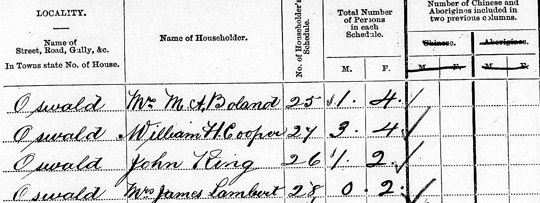
Australia – The State Library of Western Australia has just completed digitizing a series of local almanacs spanning the years from 1849 to 1889. These almanacs list local government officials and local businessmen (either through ads or directory listings). They also provide a wealth of local information. You can read more about this new collection in the official blog of the State Library of Western Australia. Access is free. [Historical Almanacs of Western Australia]
Germany – FamilySearch.org has created a new indexed collection of civil registration deaths from Frankfurt Germany. These are official death records spanning the years from 1928 to 1978 including the important period during World War II. The records come from the Hessian State Archives in Marburg. The records can be searched by first name and last name. In total, there are some 567,000 records in this collection. This will be an important collection for anyone with ancestors from Frankfurt. Access is free. [Frankfurt Civil Death Records]
US – FamilySearch.org has indexed some 28,000 records of North Carolina estate files. These are basically loose papers from the North Carolina Department of Archives and History. Many of the records appear to be related to the settlement of estates, including the provision for heirs and the distribution of land and property. These files were indexed by the North Carolina Genealogical Society. The records span the years from 1663 to 1979 and can be searched by first name, last name, place of probate and probate year. Access is free. [North Carolina Estate Files]
England – The website Deceased Online has added more cemetery records from Lincolnshire. The new additions come from Grimsby’s Scartho Road cemetery and crematorium and the Cleethorpes cemetery. In total, there are some 400,000 new records dating as far back as 1877. Burial registers from Grimsby tend to be very complete. They contain a considerable amount of information such as the exact location of the grave, date of death, date of burial, first and last name of the deceased, occupation, sex, home address, cause of death, name and address of the informant (often a relative) and the officiating minister.
As an added bonus, if the deceased person was a child or not working, under the occupation heading is listed the closest living relative.
With this latest addition, Deceased Online now has 11 cemeteries and two crematoria totalling nearly one million records from Lincolnshire County. The records can be search by first name, last name and year. Access is by subscription. [Grimsby Burial Records]
Australia – The UK website TheGenealogist has put online over 190,000 ship passenger records from England and Ireland to New South Wales. These passenger records span the years from 1828 to 1896. In addition to the usual information found in ship passenger records (name, port and date of departure, port and date of arrival, etc.), some of these new records also list additional information such as the passenger’s occupation, name of employer and salary.
TheGenealogist now maintains fairly extensive emigration databases from the UK to various colonies and they continue to expand their capabilities in this area. The records can be searched by first name, last name and year. Access is by subscription. [Australia Ship Passenger Records]
Australia – FindMyPast.com has put online historic mental hospital records from the State of Victoria. The collection covers 11 institutions. Admission records span the years from 1811 to 1919 and discharge records span the years from 1838 to 1914. Although details vary by institution, a typical record lists name, date of admission, age, date of discharge, method of discharge and hospital. Some records are much more complete and include medical histories. These records can be searched by first name, last name, year and hospital name.
Mental health hospital records are an excellent source to search for genealogists looking for ancestors who appear to have dropped off the face of the earth. Sometimes, they ended up in mental hospitals. Access to the collection is by subscription. [Historic Victoria State Mental Health Records]
November 2015
Canada – Library and Archives Canada (LAC) announced they are making good progress digitizing and putting online Canadian World War I soldier records. Known formally as the Canadian Expeditionary Force Service Files, these are the detailed service files of each Canadian soldier who served in the war. We have talked about this record set before.
These records are being digitized in an alphabetical manner. So far, all WWI soldiers with last names from A to Fitzpatrick have been completed. This represents about 1/3 of the entire collection. A typical soldier file might contain some 20 pages of detailed information about the soldier. This is a great resource for anyone who had a Canadian ancestor who fought in WWI. Access is free. [Canada World War I Soldier Records]
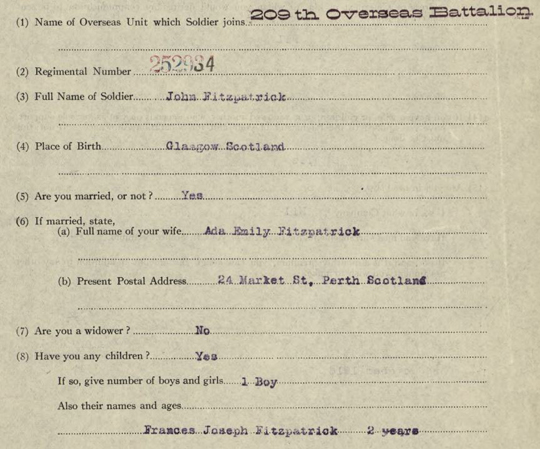
Canada – Library and Archives Canada (LAC) has launched a new database called Immigrants to Canada: Porters and Domestics 1899 – 1949. This database contains reference to some 8,600 individuals who came to Canada as porters or domestics (i.e. maids) between the years 1899 and 1949. It should be noted that many orphan girls from England were sent to Canada as domestic servants during this time period. If this fits the profile of one of your ancestors, then it may be worth checking out this database. Access is free. [Porters and Servants of Canada]
Canada – LAC has extended their database of naturalization records. The database now covers the years from 1915 to 1944, with work ongoing to extend the database to 1951. The database can be searched by first name, last name and country of origin. Access is free. [Canada Naturalization Records]
Russia – FamilySearch.org has added some 900,000 images to their collection of Russian Tatarstan church books. These are images of births, baptisms, marriages, deaths and burials performed by priests of the Russian Orthodox Church in the Republic of Tatarstan, which is in the Volga region of Russia. The records span the years from 1721 to 1939. Online genealogy records from Russia are rare. With this latest addition, it almost doubles the size of the Tatarstan collection to some 1.7 million images. Access is free. [Tatarstan Genealogy Records]
England and Wales – FindMyPast has put online nearly 10,000 volumes of English and Welsh electoral registers. These registers contain the names of eligible voters from various voting districts. A typical register will list the name of the voter and the reason why they were eligible to vote (typically because they were a land owner).
The registers span the years from 1832 to 1932. At the moment, the registers cannot be searched by name. Instead, it is possible to locate the register book by searching by year, constituency and county. In total, this collection contains some 5.4 million pages from register books that list approximately 220 million names.
We have talked extensively about UK electoral registers in our article Searching Electoral Rolls for Ancestors. We suggest you consult this article before diving into this new collection. Access to this collection is by subscription. [England Electoral Rolls]
Italy – FamilySearch.org has created a new collection of images of civil registration records from Forli. These are birth, marriage and death records from the State Archives of Forli. The records span the years from 1800 to 1815 and 1866 to 1930. In total, there are some two million images in this collection. Access is free. [Historic Forli Birth Records]
US – Readex has put online a collection of some 320 religious denominational newspapers from around the country. Most of the major religions are included in this collection, including Anglican, Baptist, Catholic, Church of Christ, Congregationalist, Episcopalian, Lutheran, Methodist, Presbyterian and Reform Church. The newspapers span the years from 1799 to 1900. Some major titles in the collection include the Pacific (San Francisco), Methodist Advocate (Atlanta), Sandwich Island Gazette (Honolulu), New Covenant (Chicago), Catholic Standard (New Orleans), Christian Mirror (Portland, ME), Catholic Herald (Philadelphia), Christian Witness and Church Advocate (Boston), Christian Messenger (Dallas) and the Deseret News (Salt Lake City).
In addition to containing many names, this religious newspaper collection provides rare denominational insight into the news and opinions of the day on matters of local, regional and national interest to congregants. It could provide some unique information and insight to genealogists.
As we have mentioned before, Readex is available only through public libraries. They do not provide individual subscriptions. Check with you local public library.
England and Wales – We have some more information to share on the recent release of the 1939 National Identity Register by FindMyPast. Here are some important facts to know about this collection:
• The collection includes records on 41 million people. At launch, some 28 million records will be available online.
• There were 1.2 million pages that needed to be scanned, converted and tagged by hand to build this record set.
• At the time of the survey in England and Wales, the average age was 33 for men and 35 for women, with 53% of the population being female.
• The UK government had already begun evacuating London in September 1939. Women, children and the disabled were moved out of the city. At the time of the survey, only 2% of the population in London was aged 0 to ten. Therefore, if you are looking for a young ancestor from London at the beginning of the war in this collection, chances are they had already been moved out of the city.
Please note that this collection can be searched for free but access to the underlying record is by pay per view. This collection is not covered by a normal FindMyPast subscription. [1939 National Identity Register]
England – FamilySearch.org has indexed some 160,000 records or the Women’s Army Auxiliary Corps (WAAC) records from 1917 to 1920. These are detailed service records on the some 7,000 women who joined WAAC. Each file contains name, date and place of birth, residence, marital status, number of children, occupation, age and date of enlistment. These records can be searched by first name and last name. Access is free. [WWI Women’s Army Auxiliary Corp Records]
October 2015
UK – FindMyPast is launching the UK 1939 National Identity Register on Monday 2 November. This is huge news for anyone with UK ancestors. The video below provides some background:
We first talked about this digitization project in March 2014. Here is what else you need to know:
• Basically, the 1939 National Identity Register, although not a census, did have some similar information to a census. It was taken on the night of Friday 29 September 1939 just after the start of World War II.
• For genealogists, this 1939 register will help bridge the time gap between the 1911 census (the last census currently online) and the year 1939. The UK 1921 census is not allowed to go online for another seven years (in January 2022). The 1931 census was destroyed by fire in World War II (at least the England part of the census - the Scottish part is still safe in Scotland) and the 1941 census was never taken because of the war. So, the 1939 National Identity Register is hugely important for anyone tracing UK ancestors because it is the only large national resource currently available for the 28 year time period between 1911 and 1939.
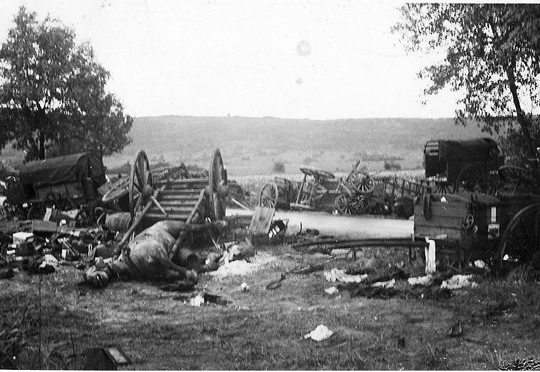
• The British Government conducted the survey because it wanted updated statistics on the population so that identity cards could be issued. It was also required in case a draft was needed, in case of mobilisation, in case of mass evacuation of the general population and in case rationing was required (which was introduced just a few months later in January 1940).
• The details recorded in the 1939 National Identity Register include name, address, sex, specific date of birth (not just their age), marital status, occupation and whether the person was a member of the armed forces or reserves.
• The process for the enumeration worked as follows. On the night of Friday 29 September 1939, some 65,000 enumerators delivered forms to each household. Each household was responsible for filling out their own form. Two days later on the Sunday and Monday, the enumerators returned to collect the forms. The enumerators checked the forms and (if there were no problems) issued a complete identity card on the spot to each member of the household.
• There was a strong incentive for everyone to register correctly. Other than societal pressure given that war had just broken out, it was widely broadcast that anyone who “neglected” to register would not be eligible in the future for ration books.
• One thing to note is that due to privacy issues, information listed on individuals still alive today will not be included in the database.
• Access to the 1939 National Identity Register is by pay per view. Note: this is in addition to a normal FindMyPast subscription. [1939 National Identity Register]
US – The Midwest Genealogy Center, part of the Mid-Continent Public Library in Missouri has put online a free index to over 1.5 million pension records from the US Railroad Retirement Board. According to Cheryl Lang, manager of the Midwest Genealogy Center, “This is the first time this treasure trove of genealogical information is publicly available to search by name or date.”
For those who are not familiar with the Railroad Retirement Board, it is an independent agency of the US government that was formed in 1935 to administer retirement benefits to the country’s railroad workers (local streetcar workers and local city electric railway workers are not covered).
“Providing this public index of national railroad pension records has been a project in the making for more than three years,” Lang said. “This is a collaboration with NARA to make indexed information available to the public. Also, our staff and volunteers have been compiling indexes of various materials held by MGC that we would like to make searchable by the public."
Please note: only railroad workers who have been deceased for more than seven years will be included in the index. Access is free. [Railroad Retirement Pension Index]
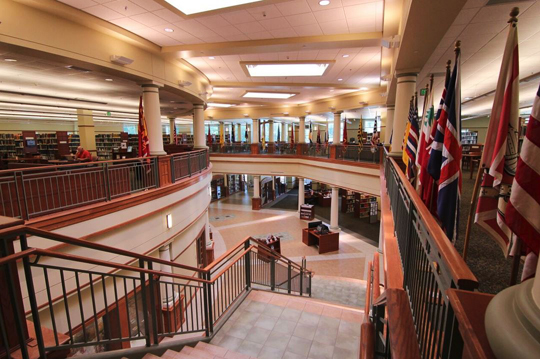
US – FamilySearch.org has indexed an additional 450,000 birth and death records from Montana. These are county courthouse records that span the years from 1840 to 2004. The counties covered are Broadwater, Deer Lodge, Jefferson, Lewis and Clark, Powell and Silver Bow. The collection can be searched by first name and last name. Access is free. [Montana Birth and Death Records]
US – FamilySearch.org has created a new browsable image collection called United States Rosters of Revolutionary War Soldiers and Sailors. It spans the years from 1775 to 1783. The collection initially consists of some 18,000 images of published state rosters of revolutionary war soldiers from Alabama, Connecticut, Massachusetts, New Jersey, Vermont and Virginia.
Some of the state records (such as the ones from Virginia) are a simple list of soldier’s names, while other states (such as Alabama – see image below) provide more elaborate descriptions of each soldier. Access is free. [United States Rosters of Revolutionary War Soldiers and Sailors]
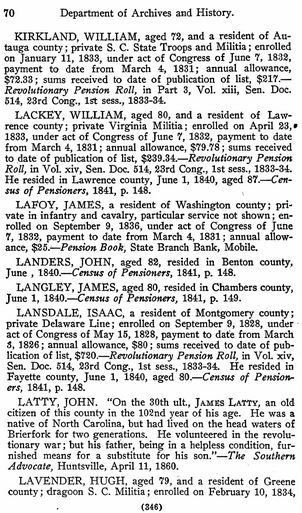
England – The website Forces War Records has reached a milestone of 500,000 World War I hospital records. These are military hospitals admission and discharge registers from the National Archive. A typical record lists the soldier’s name, rank, regiment/sub unit, age, completed years of service, date of admission, date of discharge, injury/illness and any additional medical notes.
This collection also contains many records of women who also served in the war effort. There is an estimated one million more records in this collection waiting to be transcribed. Forces War Records now has some 4.2 million UK military records in total dating from the Napoleonic War (1793 to 1815) to post World War II. Access is by subscription. [WWI Hospital Records]
England – The website TheGenealogist has put online some five million historic ship passenger records from Britain. These are historical records of passengers who departed by sea from Britain for the years between 1896 and 1909. These records will be of interest to anyone who had ancestors that emigrated from Britain during this time period, particularly to America, Canada, India, South Africa, Australia and New Zealand.
These records will also be of interest to anyone with ancestors who transmigrated through England during the time period. In particular, people from Norway, Denmark and Sweden often had to travel first to England in order to board one of the larger transatlantic passenger ships to America.
A typical record in this collection lists the first name, last name, age, gender, marital status, nationality, port of departure, date of departure, voyage length, name of the vessel and the port of arrival. Of course, not all the passengers in this record collection were immigrants. Some were travelling for other reasons, as the image below shows the passenger record of one Winston Churchill travelling to South Africa.
These records can be searched by name, port of departure, port of arrival and nationality. TheGenealogist uses technology in their search that will help group family members together in the search results, which can be incredibly useful when looking through this collection. Access is by subscription. [Historic English Ship Passenger Records]
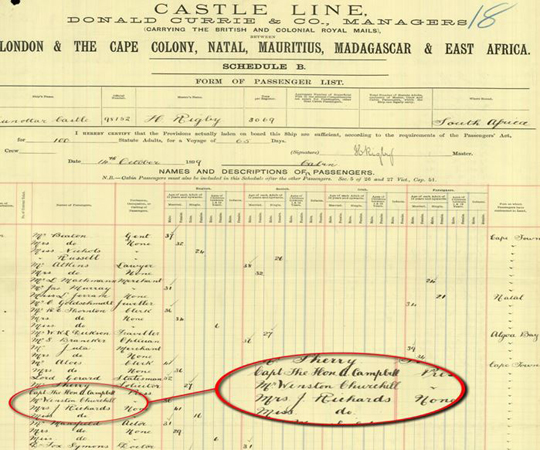
England and Wales – FindMyPast has put online electoral registers from England and Wales that span the years from 1832 to 1932. In total, this mammoth collection consists of some 5.4 million images containing 220 million names. These records can be searched by first name, last name, year, county, constituency and polling district. This is a wonderful new collection.
Most genealogists are not that familiar with electoral rolls as a source of ancestral information. Fortunately, we have an article specifically devoted to this subject: Searching Electoral Rolls for Ancestors. Access to this collection is by subscription. [England Electoral Registers]
Caribbean – Readex has put online a new collection called Caribbean Newspapers 1718-1876. According to Readex, this is the largest online collection of 18th and 19th century newspapers from the region. It features more than 140 newspapers from 22 different islands. Most of the newspapers are in English, but some are in Spanish, French or Danish.
The countries/islands covered by this collection are Antigua, Bahamas, Barbados, Bermuda, Cuba, Curaçao, Dominica, Grenada, Guadaloupe, Haiti, Jamaica, Martinique, Montserrat, Nevis, Puerto Rico, St. Bartholomew, St. Christopher, St. Lucia, St. Vincent, Tobago, Trinidad and the Virgin Islands.
This collection provides a unique tool for genealogists to research their ancestors, study colonial history, the Atlantic slave trade and other aspects of Caribbean culture and history. In the absence of official records, newspapers are a great source.
For those who are not familiar with Readex, it is not available to individual subscribers. Readex is accessible through most public libraries. This is the largest genealogy record collection we have seen in the last five years for anyone with Caribbean ancestors. [Historic Caribbean Newspapers]
Bahamas – FamilySearch.org has indexed some 35,000 civil registration records from the Bahamas. These are birth, marriage and death records that span the years from 1850 to 1959. See an example of a birth record below. The records can be searched by first name, last name and life event (birth, marriage, residence, death and any). Access is free. [Bahamas Historic Birth Records]

Sweden – MyHeritage has put online 46 million Swedish household records spanning the years from 1880 to 1920. These are Lutheran Church parish records. Basically, the local parish priest would be responsible for conducting a mini census of his area every year. He would visit each home and collect information on births, marriages, deaths, changes of address, etc. Since this was done every year, it is in theory possible to trace a family as they moved to different locations within the country.
These so-called household examination books can be searched by first name, last name, year, place, address and keyword. Access is by subscription. [Historic Swedish Household Examination Books]
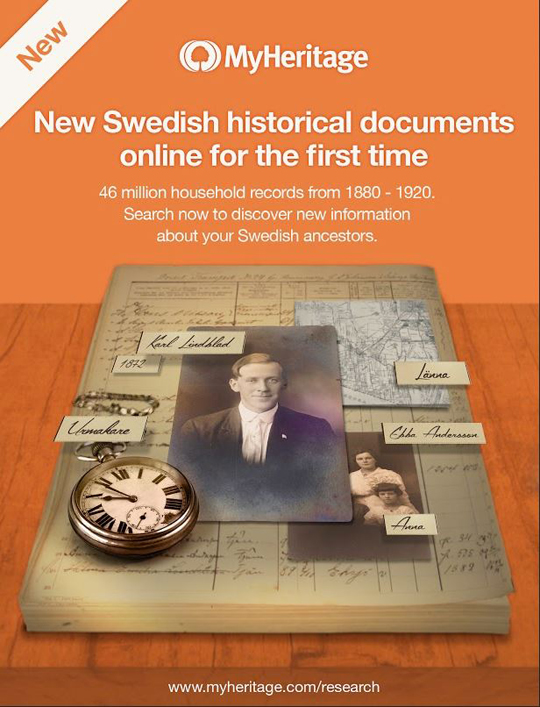
Honduras – FamilySearch.org has indexed an additional 179,000 civil registration records from Honduras. These are birth, marriage and death records spanning the years from 1841 to 1968. The collection can be searched by first name and last name. Access is free. [Historic Honduras Birth Records]
US – FamilySearch.org has indexed some 875,000 Baltimore ship passenger records. These records span the years from 1820 to 1948. After Ellis Island in New York, Baltimore was the second largest port of arrival for immigrants to America (see the article Ellis Island Immigration Facts). Access is free. [Baltimore Passenger Records]
US – FamilySearch.org has indexed an additional one million World War II draft registration cards. This new addition covers the year 1942. A typical draft card is shown below. This collection can be searched by first name and last name. One caution to note: when the National Archives originally scanned the draft cards for the states of DE, MD, PA and WV, the front image of one person's card was scanned with the back image of the previous person's card. So be very careful that you are reading the correct front and back sides for your ancestor. Access to this collection is free. [ US World War II Draft Cards]
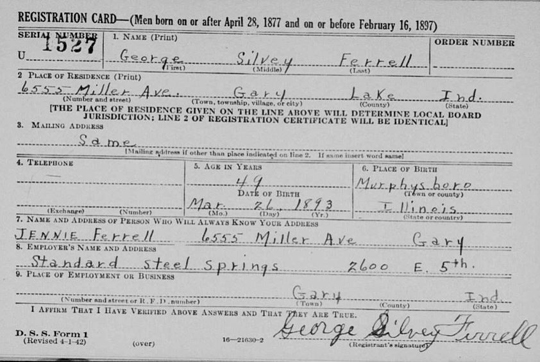
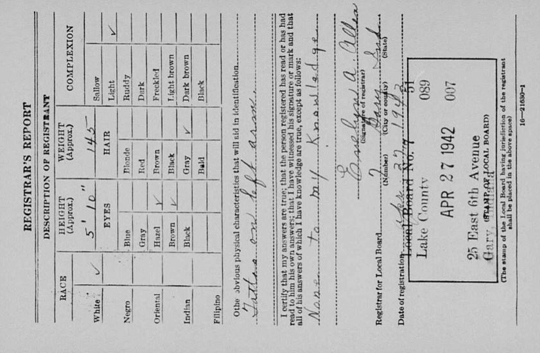
Scotland – FindMyPast has added three Scottish newspapers to their collection from the city of Glasgow. Included are the Glasgow Free Press, the Glasgow Gazette and the Glasgow Morning Journal. In total, about 100,000 articles from these three newspapers have now gone online, primarily from the 1860s. Access is by subscription. [Historic Glasgow Newspapers]
Australia – FamilySearch has indexed some 335,000 cemetery records from Queensland. These records span the years from 1802 to 1990. The records are part of a 1.1 million image collection of indexes, cemetery transcripts and burial records. Cemetery records often provide more information than church death records, particularly on children that died young.
Australia cemetery records are also sometimes useful for finding the maiden name of women. The indexed records in this collection can be searched by first name and last name. The images can be searched by cemetery. Access is free. [Historic Queensland Burial Records]
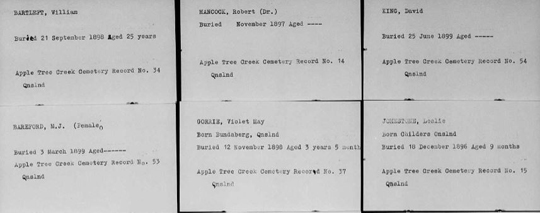
Canada – FamilySearch.org has indexed some 318,000 death registrations from the province of British Columbia. These records cover the period from 1872 to 1986. B.C. started recording deaths in 1872, the year after the province joined Confederacy. Please note Chinese were excluded from the death registration until 1897 and aboriginals were excluded from registration until 1916 (with the exception of one brief period after 1897). Also note that in many circumstances, there were long delays between the date of death and the registration of the death given how isolated some communities were from the nearest government office.
A typical death record (see below) lists the name of the deceased, gender, date of death, where the person was born and cause of death. The collection can be searched by first and last name. Access is free. [B.C. Death Registrations]
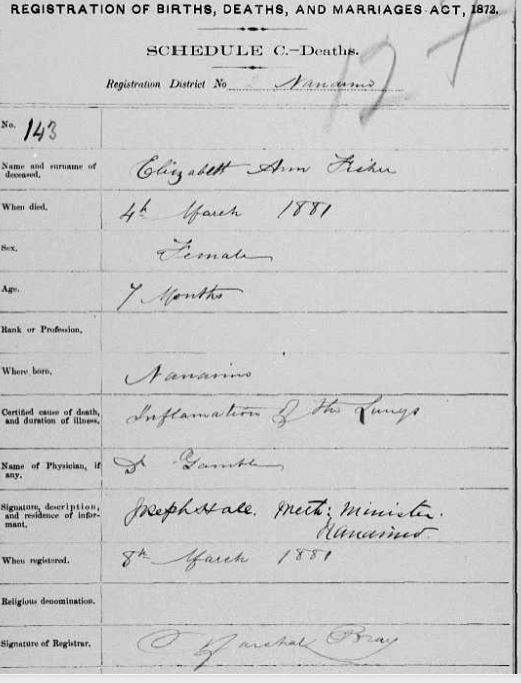
Norway – The National Archives of Norway has digitized and put online images of the entire 1891 census of Norway. Close to 2.5 million images are now available for viewing. The images are sorted by city and the municipalities (called a herred) that existed at the time of the census. At the moment, no master name index exists for this census, so the images must be manually reviewed.
Each individual had their own census sheet (see example below). For people looking for ancestors from the Oslo region, the 1891 address book for the region is also included. This will make it easier to pinpoint your ancestor in the census records.
This census is thought to be fairly complete. For example, for those who had mariner ancestors, it did include seamen. As well, in the cities (where most people could read and write), people were usually asked to fill out the census forms themselves. So if you find your ancestor, you will also be able to see their actual handwriting. Access is free. [Norway 1891 census]
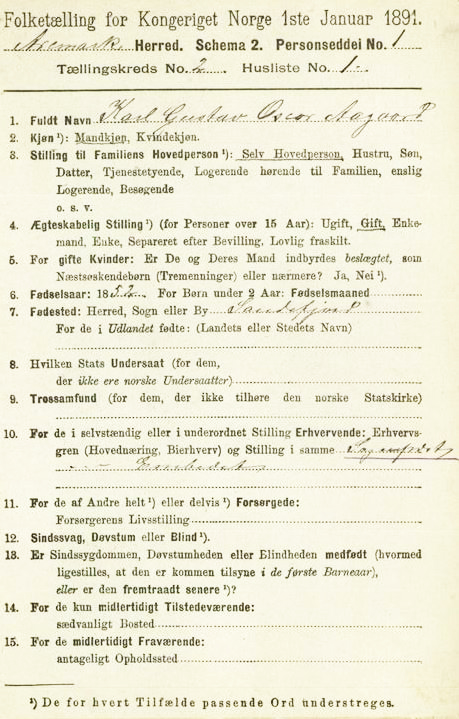
Scotland – The website ScotlandsPeople has released the 1855 valuation rolls. The year 1855 was the first year that valuation rolls were available. It also coincides with the first year that births, marriages and deaths were statutorily required to be registered with the government. Thus, this valuation roll collection will make it easier for genealogists to cross reference an address of their ancestor to birth, marriage and death records. This is big news for anyone with Scottish ancestors.
The 1855 valuation rolls include over one million indexed names and addresses for anyone who owned, rented, or occupied property in Scotland. Details include the name of the owner/tenant/occupier, address of the property, location of the property and details on the assessed value of the land and dwellings.
The reason the Scottish government created the valuation rolls was for the purposes of collecting local land taxes. As a result, the valuation rolls tend to be fairly accurate. Please note that dwellings with a value of less than £4 were not included in the valuation rolls. This means that very modest dwellings of poor people would not be included in the survey. Valuation rolls from 1885 to 1925 are now available on the ScotlandsPeople website. Access is by subscription. [1855 Scotland Valuation Roll]
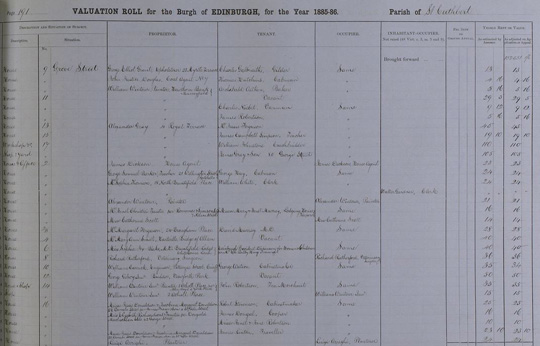
Ireland – The British Newspaper Archive website continues to add more historic Irish newspapers to their vast online collection. The latest additions include the Kings County Chronicle (1845 to 1871) and the Armagh Guardian (various years from 1845 to 1870). The British Newspaper Archive now contains some 509 titles and 11.8 million pages, including at least twenty titles from Northern Ireland and the Republic of Ireland.
One of the nice things about this website is that you can browse publications by location. This is very useful since most people would not be familiar with what local papers may have existed in a given location back in the day. The British Newspaper Archive website has been built in partnership with the British Library. It can be searched by keywords such as a person’s name, a place or an event. Access is by subscription. [British Newspaper Archive]
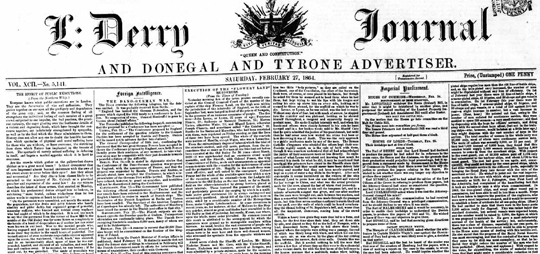
Ireland – IrishGenealogy.ie, the official genealogy website of the Irish government, has updated their indexes to historic civil records. The indexes have been updated to include birth records over 100 years old (1914 and earlier), marriage records over 75 years old (1939 and earlier) and death records over 50 years old (1964 and earlier).
Please note: these are indexes only. However, the latest update has enhanced indexes for some of the older marriage records. This will be a great benefit for anyone with Irish ancestors. Access is free. [Historic Irish Civil Registration Records]
September 2015
Ireland – The County Tyrone Genealogy Website continues to add new content to their website. This is an incredible website for anyone with ancestors from County Tyrone. It contains primary and secondary source documents as well as maps, photos and so much more. For example, the website contains birth records, marriage records, death records, census records, obituaries, parish records, deeds, criminal records, hearth rolls, school records, ship passenger records and on and on and on. Access is free. [County Tyrone Genealogy Records]
You can also search this site using the free Genealogy Search Engine. Simply use the site:cotyroneireland.com command in your search result. For example, if you were looking for an ancestor called Smith, you would type
smith site:cotyroneireland.com
Ireland – FindMyPast has added six new Irish newspapers to their collection of historic Irish newspapers. Included in the new additions is The Evening Freeman, a national publication. In total, FindMyPast’s Irish newspaper collection now covers 88 titles spanning the years from 1719 to 1950. This collection can be searched by first name, last name and by keyword. Access is by subscription. [Historic Irish Newspapers]
Italy – This week, FamilySearch.org has put online three new Italian civil registration record sets from Potenza (1697 to 1923 some 3,140,000 images), Rieti (1840 to 1945 some 395,000 images) and Trapani (1906 to 1928 some 230,000 images). These are birth, marriage and death records that come from the local state archives. The images can be browsed by commune or frazione and then by type of record. Access is free. [Potenza Civil Registration Records] [Rieti Civil Registration Records] [Trapani Civil Registration Records]
England – FindMyPast has put online 112 directories and almanacs. These are street directories, city directories, trade directories, county guides and general almanacs. Street directories are an excellent resource for anyone wanting to trace their ancestors between censuses. A typical street directory lists the name of the head of the household, their home address and their occupation. Most of the directories span the years from 1870 to 1939 and come from traditional sellers of old street directories (Anguline Research Archives, Gould Genealogy, Eneclann and Yorkshire Ancestors). The largest concentration of directories in this collection is from Yorkshire. Access is by subscription. [England Street Directories]
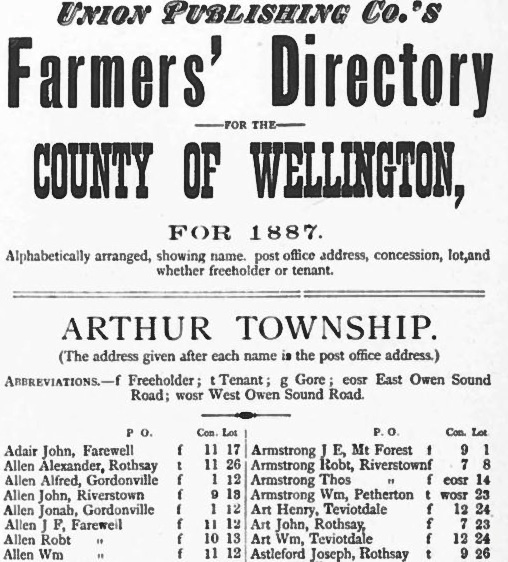
US – FamilySearch.org has created a new browsable image collection of Pennsylvania civil marriages. These are city and county marriage records. Most of the records come from Philadelphia starting in 1885. There are images from other counties in this collection that go as far back as 1677, but many of these images are not available to general members of the public. Access is free. [Historic Pennsylvania Marriage Records]
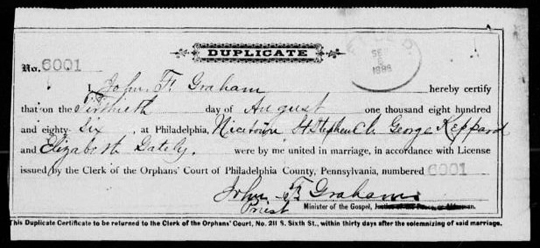
US – FamilySearch.org has created a new index of birth records from Richmond, Virginia. This collection of some 53,000 records covers the years from 1870 to 1912. Note: this is an index only and lists the name of the person, date of birth, gender, race, father’s name and mother’s name. It can be searched by first name and last name. Access is free. [Richmond Virginia Birth Records]
UK – The genealogy website Forces War Record has released a rather unique genealogy record set. To mark the 75th anniversary of the Battle of Britain, Forces War Record has translated and put online for the first time what is known as Hitler’s Black Book (officially called Sonderfahndungsliste Gross Britannien). It lists 2,820 English people that the Nazi regime viewed as enemies of the state. These were the people in the UK who were targeted for execution if Germany was successful in winning the Battle of Britain.
Not surprisingly, this hit list is full of people whom the Nazis knew spied on Germany, such as Conrad Fulke Thomond O’Brien-french, the real-life British Secret Intelligence officer who served as the role model for 007 James Bond. Also included are well-known politicians such as Winston Churchill.
What is surprising are some of the other names on the list, such as Lord Baden-Powell (the founder of scouts), the author HG Wells and the entertainer Noel Coward. They were all on the Nazi hit list.
Most of the people on the list were politicians, writers, prominent émigrés, known intelligence agents, scientists, entertainers and artists. Check to see if any of your ancestors were on the list. The list is alphabetical by last name. Access is free. [Nazi Black Book]
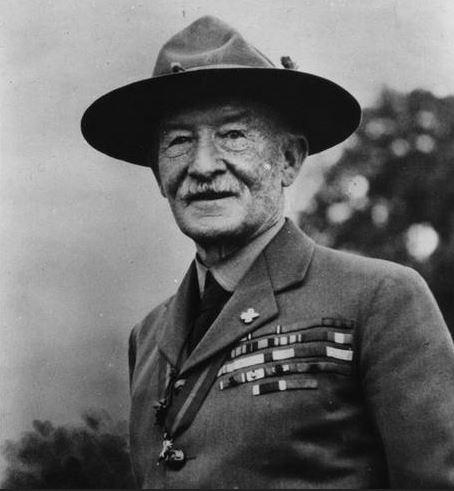
US – FamilySearch.org has added 1.2 million images to their collection of Delaware vital records. These are birth, marriage, death, cemetery and bible records. The records come from the Delaware Public Archives and span the years from 1650 to 1974. This brings the total number of images in this collection to 3.1 million. Some of the images can be searched by first name and last name. Otherwise, the images can be browsed by type of record and last name. Access is free. [Delaware Vital Records]
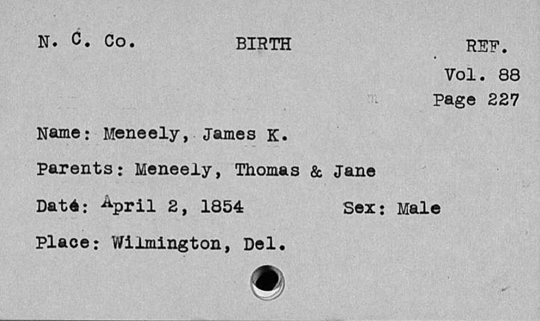
US – FamilySearch.org has indexed an additional 373,000 birth certificates from Cook County, Illinois. Cook County encompasses the city of Chicago. The birth certificates span the years from 1871 to 1940. The records can be searched by first name, last name, place of birth and year. Note that these are indexes only.
To search for and order the full certificate you must access the official Cook County genealogy website. Access to the index is free on FamilySearch. There is a fee for ordering the certificate on the official website. [FamilySearch Cook County Birth Certificates] [Official Cook County Genealogy Website]
US – Readex has improved their user interface for accessing their massive American Civil War collection. This makes it easier for genealogists to find information about their ancestors. For readers who are not familiar with Readex, it is an institutional service provided exclusively through public libraries. If you want to access Readex, go to your local public library.
The Readex American Civil War collection spans the years from 1860 to 1922. It consists of full-color searchable scans of over 13,500 printed works about the war. Much of the material is unique, such as broadsides, lithographs, stereographs and more. The video below describes how this is a valuable research collection in addition to the usual sources of Civil War material, such as the Library of Congress.
US – FamilySearch.org has a new index collection of South Dakota birth and marriage records. It covers some 700,000 records spanning the years from 1843 to 2014. The index was provided by the South Dakota Department of Health (see example below). The index can be searched by first name and last name. Access is free. [South Dakota Birth Records]
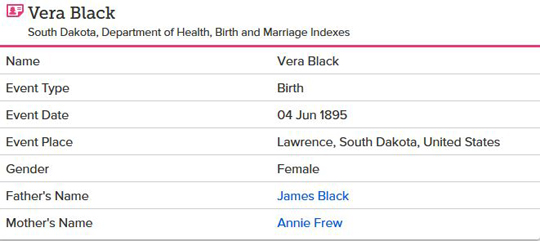
US – FamilySearch.org has indexed an additional 1.3 million marriage records from Texas. These records span the years from 1837 to 1977. The records can be searched by first name and last name. See examples below. Access is free. [Texas Marriage Records]
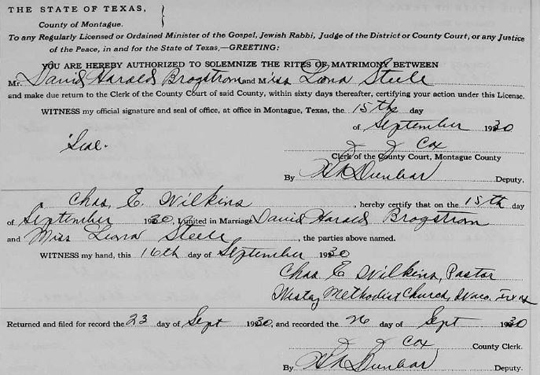
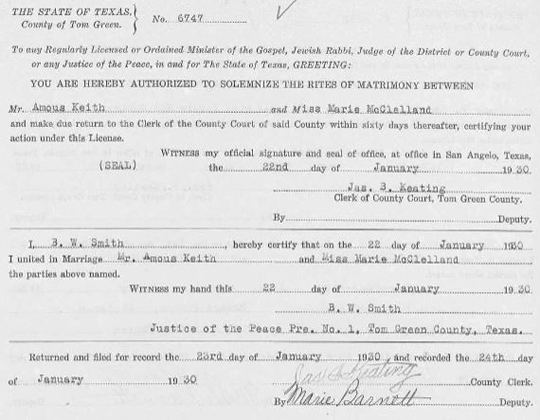
Ireland – The website Irish Ancestors has launched a unique database called the Dublin Presbyterian Colporteur’s Notebook 1875. A colporteur was someone employed by a religious society who was responsible for distributing religious material. In this case, the colporteur was William Malone, who was tasked with the responsibility of making contact with non-affiliated Presbyterians in 1875 Dublin. Fortunately for modern-day genealogists, he kept copious notes on every family he met, including many who were Roman Catholics. In total, he provides biographical notes on some 10,000 individuals.
In the absence of nineteenth century census records for Dublin, this is an incredibly valuable resource. A typical record lists the names of the mother and father, their occupations, education, number of children, place of origin and general living conditions. Some of the entries are a bit chilling, such as the one below:
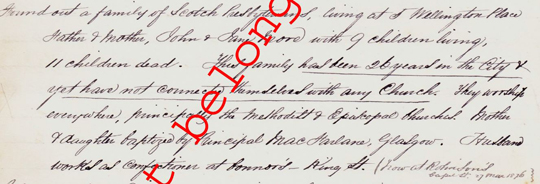
This database can be searched by first name and last name. Access is by subscription. [Dublin 1875 Presbyterian Records]
Italy – FamilySearch.org has indexed an additional 450,000 civil registration records from the state of Bergamo and an additional 355,000 civil registration records from the state of Cremona. Both sets of records come from the regional state archives and cover births, marriages, marriage banns, deaths, and some residency records. The Bergamo records cover the period from 1866 to 1901 while the Cremona records span the years from 1744 to 1942. The records can be searched by first name and last name. Access is free. [Bergamo Civil Records] [Cremona Civil Records]
Italy – FamilySearch.org is on a role with Italian civil registration records. This week, they have added large browsable image collections from Enna (1866 to 1944 some 840,000 images), San Remo (1805 to 1910 some 235,000 images) and Pescara (1809 to 1929 some two million images). These images all come from the regional state archives. Births, marriages, marriage banns and death records are in these collections. The images are organized by commune or frazione and then by type of record and year. Access is free. [Enna Civil Records] [San Remo Civil Records] [Pescara Civil Records]
Canada – Ancestry.ca has put online a collection of World War II service files of war dead. These are essentially files on soldiers that died during the war years. In total, there are about 44,000 WWII war dead files, of which Ancestry has put some 29,000 online. Service files such as these often contain multiple documents on each soldier, such as details on the soldier’s enlistment and service record. The collection can be searched by first and last name. Access is by subscription. [Canada World War II War Dead Soldier Service Files]
Brazil – FamilySearch.org has indexed an additional 350,000 civil registration records from the state of Pernambuco. These are birth, marriage and death records that span the years from 1804 to 2014. The birth records list the mother and father’s occupation and place of origin. Also (unusual for a birth record) the names of the maternal and paternal grandparents are often also listed. These records are in Portuguese (see example below). The records can be searched by first name and last name. Access is free. [Pernambuco Birth Records]
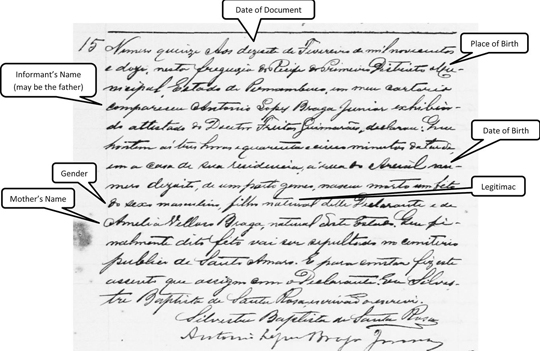
England – FindMyPast has put online one million prisoner of war records from World War II. These are predominantly records of Commonwealth and US prisoners held in German POW camps. The records cover the period from 1939 to 1945. A typical record lists the name, rank and nationality of the prisoner. Also included is the location of the POW camp along with the length of time spent in captivity. The collection also contains some 360,000 images comprised of photographs from the POW camps and pages from personal diaries of the prisoners.
This collection is being published in association with the UK National Archives to mark the 70th anniversary of the end of World War II. Not surprisingly, British prisoners represent the largest number of records in the collection. There also appear to be a substantial number of records of Dutch, American and Australian POWs.
It is not clear if this collection consists of all or just a part of the WWII prisoner of war records held at the National Archives. Access to this collection is by subscription. [World War II Prisoner of War Records]
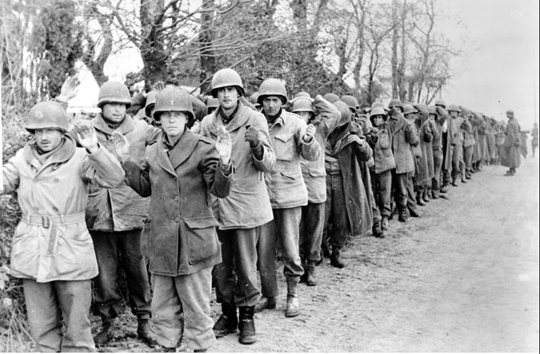
England – Deceased Online has added four new cemeteries in North Lancashire to their collection. The latest additions come from the towns of Fleetwood, Poulton le Fylde and Preesall and go back as far as 1840. This brings the total number of Lancashire burial records to 5 million from over 60 different cemeteries. A typical record in the collection provides a digital scan of the original burial register, details of the grave occupant and a map indicating the location of the grave in the cemetery. Access is by subscription. [Lancashire Burial Records]
England – FindMyPast has put online an additional 2.7 million school registers from across England. These records come from 25 different archives and cover over 3,600 schools spanning the years from 1870 to 1914. Details within the school registers include such things as school attendance records, visitors to the schools and the daily activities of school life.
A typical admission register lists the name of the student, date of birth, admission year and name of the school. Some admission registers include additional information such as the name of parents, father’s occupation, exam results and any illnesses that resulted in an absence from school. Access to this collection is by subscription. [Historic English School Records]
US – Ancestry.com has launched a massive US probates and wills collection. The collection consists of some 30 million records comprised of 170 million images from all 50 states. The collection spans the years from 1668 to 2005. In total, some 100 million people are mentioned in the collection, including the deceased, their relatives, friends, acquaintances and neighbors.
Wills and probates (the legal process by which a will is proved to be valid in a court of law) are a rich source of information for genealogists because they tend to provide a fairly comprehensive view of a person’s life. For example, a will often list a broad cross section of the relatives of the deceased. Some even provide insight into family dynamics based on who got what in the will. As well, it is often possible to infer the occupation and relative wealth of the deceased by their activity, personality and possessions. Finally, it is one of the few historical documents genealogists can access that list so-called FANs of a person (Friends, Acquaintances and Neighbors).
Ancestry has put in a lot of effort to make this collection accessible to everyone, including beginning genealogists. For example, it comes with its own research guide.
It should be noted this collection is the result of collaboration with FamilySearch that began a few years ago. So far, FamilySearch has made no corresponding announcement as to whether they will be separately publishing some of this information. If it follows the usual pattern, Ancestry will have exclusive access to the material for a period of time (possibly one or two years) before it gets published on the FamilySearch website.
The collection can be searched by first name, last name, year of death and location. Access to the collection is by subscription. [Historic US Wills and Probates]
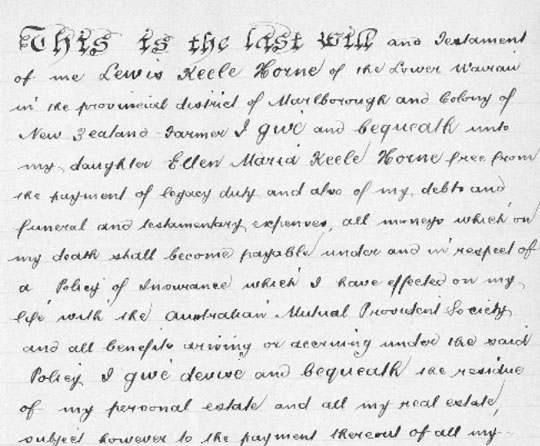
US – GenealogyBank is reporting that their historic Hawaiian newspaper collection has grown to include 25 different titles providing coverage from 1836 to 1991. In total, there are more than 166,000 articles in the collection. The articles can be searched by first name, last name, keywords and date range. Access is by subscription. [Historic Hawaiian Newspapers]
US – The Plainfield Public Library has put online an extensive collection of city directories from Plainfield New Jersey. The collection of 75 directories spans the years from 1870 to 1982 and contains hundreds of thousands of listings. Access is free. [Plainfield New Jersey City Directories]
We have mentioned this before, but we have extensive resources to help people with old city directories, including a List of City Directory Abbreviations, List of First Name Abbreviations and List of Occupation Abbreviations.
US – The San Mateo County Genealogical Society (near San Francisco, California) has put online a unique set of genealogical records. These are an index of the sheriff’s booking registers. The registers cover the years from 1924 to 1953 (1943 to 1945 are missing). Basically, these registers record everyone who was booked into the county jail during that period.
One thing interesting about this collection is that prior to WWII it was not uncommon for homeless residents and transients in the area to use the San Mateo jail as a type of overnight lodging. They would be picked up late in the evening and then released the next morning without being charged. This would include people who were travelling into the county in search of work, but who could not afford more traditional lodging.
The index, which lists some 60,000 names in alphabetical order, provides the name of the individual, their age, book, page and line number of the full record (see image below). The full record (which is currently available offline at the local San Mateo library) provides further detail such as the day of incarceration, occupation, height, weight, amount of time spent in the county, where the person was picked up, the hour of arrest, the hour of release, the number of meals served, any fines paid and a column for remarks. This is a great resource to check if you had ancestors passing through the San Francisco region. They may have spent a night in the San Mateo jail. Access is free. [San Mateo Sheriff Records]
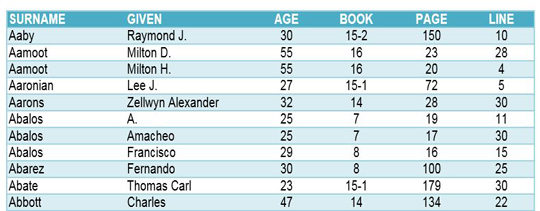
Ireland – Irish Genealogy News is reporting that the civil registration index of birth, marriage and death records previously held at Irish Genealogy appears to have been fully restored. This is great news for anyone with Irish ancestors. You can read more about it here.
Ireland – The Irish Newspaper Archive has added four new titles over the summer months: the Irish (Cork) Examiner 1841 to 1989; the Sligo Champion (from County Sligo) 1950 to the present; the Strabane Chronicle (from County Tyrone) 1908 to 1979 and various years from the Leinster Express in County Laois. Access is by pay per view. [Irish Newspaper Archive]
Ireland – FindMyPast has put online historic Irish school register records. In total, this collection contains some 142,000 records. The records span the years from 1860 to 1920. This collection can be searched by first name, last name, school, parish, county and religious denomination. According to FindMyPast, most of the records come from smaller, more isolated schools. Access is by subscription. [Irish School Records]
August 2015
US – FamilySearch.org has indexed an additional 2.7 million records from the 1915 New Jersey state census. This will be a very useful collection to search for many people with American ancestors since New Jersey was a popular settling point for many immigrants during the height of the immigration boom from 1892 to 1924. The collection can be searched by first name and last name.
The 1915 New jersey state census lists name, location, whether the occupant owned or rented, color, sex, date of birth, age, marital status, place of birth, birthplace of parents, number of years in the US, whether a naturalized citizen, occupation, English reading/writing/speaking proficiency, and (if the person was a child) what school they attended. Below is an example. Access is free. [New Jersey 1915 State Census]
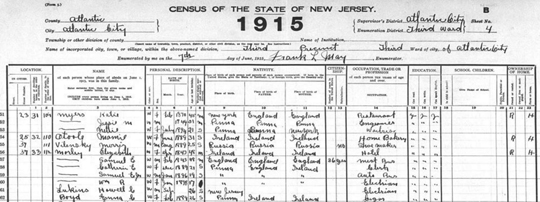
Colombia – FamilySearch.org has added a million new images to their collection of Colombian Catholic Church records bringing the total size of the collection to an astonishing 10.5 million images. These images span a vast time period from 1600 to 2012. Included are baptisms, confirmations, pre-marriage investigations, marriages, marriage dispensations and deaths. Some of these records have been indexed and can be searched by first and last name. Access is free. [Colombia Catholic Church Records]
Mexico – FamilySearch.org has indexed over 12 million Mexican Catholic Church records. These are baptisms, confirmations, marriages, death and burial records. Some of the records go back as far as the 1600s and as recent as 1994. The link will take you to an article that provides an overview of the Mexican church records held by FamilySearch. Near the bottom of the article are all the links to the various collections. The records can be searched by first name and last name. Access is free. [Mexican Catholic Church Records]
Philippines – FamilySearch has added four million more civil registration images to their Manila collection, bringing the total collection to some 5.9 million images. These are images of marriage and death records (no birth records). The records span the years from 1899 to 1984. Access is free. [Manila Marriage and Death Records]
July 2015
Ireland – FamilySearch.org has put online a massive new collection of Irish petty court session records. There are 22 million records in total in the collection, which spans the years from 1828 to 1912. These records were indexed by FindMyPast, which had previously put them on their website. Now you can search for them for free at FamilySearch. This is a great resource for anyone with Irish ancestors since these records touch all levels of society.
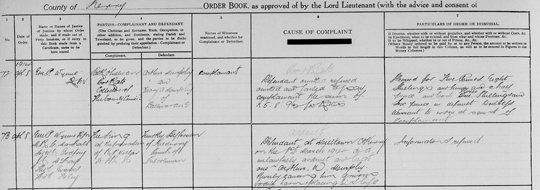
Irish petty court records are basically minor misdemeanor records. Typical offenses would include such things as public drunkenness and trespassing offenses. Dog registrations are also included in this collection. A typical record lists the individual’s name, date, county and other information specific to the court case. This collection can be searched by first and last name. Access is free. [Ireland Petty Court Records]
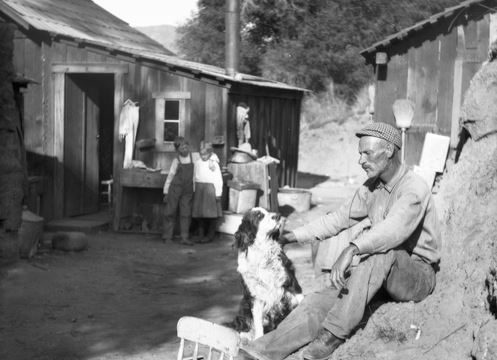
US – FamilySearch.org has indexed the Iowa 1925 state census. In total, there are some 5.6 million records in this collection. A typical record lists the name of the person, relationship to the head of the household, sex, color or race, age, marital status, owner or renter, number of years in the US, number of years in Iowa, education level, literacy level, name of father, place of birth of father, current age of father maiden name of mother, place of birth of mother, current age of mother, place of marriage of parents, military service history (branch of service, war participated in, state enlisted or drafted from), occupation and religion. This collection can be searched by first name and last name.
This is a fairly comprehensive census for the time period. The detailed information on the mother and father will be particularly useful for tracing back the previous generation. Access is free. [Iowa 1925 Census]
US – FamilySearch.org has created a new vital records index of Kentucky births, marriages and deaths. The indexes span the years from 1911 to 1999. There are some 9.9 million names listed in these indexes. This collection came from the Kentucky Department for Libraries and Archives. There are some gaps in the data, particularly for the marriage index. Please also note that when looking at the birth index, a number in the child’s middle name field means that no middle name was provided for the child (1=male, 2=female). Access to this collection is free. [Historic Kentucky Vital Records]
Italy – FamilySearch.org has created a number of new browsable image collections of civil registration records for different regions of Italy. This includes Cremona (1744 to 1942 some 1.3 million images), Grosseto (1851 to 1907 some 394,000 images), Pesaro (1866 to 1942 some 709,000 images), and Ragusa (1900 to 1940 some 111,000 images).
These collections all come from the regional state archives. They contain the usual civil registrations of births, marriages and deaths. Also included are some marriage banns and residency records. Access is free. [Cremona Civil Registration Records] [Grosseto Civil Registration Records] [Pesaro Civil Registration Records] [Ragusa Civil Registration Records]
June 2015
Australia – The Ryerson Index has just reached the important milestone of 5 million names. For those who are not familiar with the Ryerson Index, it provides a free index to Australian obituary and probate notices found in historic newspapers. The notices go back as far as the Sydney Gazette of 1803 and as far forward as the present.
Although the Ryerson Index traditionally focussed on newspapers from New South Wales, it now covers much of Australia. A typical search will provide the last name, given name(s), type of notice (death notice, probate notice), date of death, age of person at death, newspaper, publication date and a reference to the town/city where the person last lived. Access is free. This is a great resource for anyone with Australian ancestors. [Ryerson Index]
US – The archives of the city of Providence, Rhode Island has put online a number of historic city directories from the area. The directories span the years from 1895 to 1935. Technically, these are house directories because householders are listed by street address only (normally, a city directory lists householders by street address and also alphabetically). The usual information is contained in these directories, namely the head of household, occupation, street address and whether the person was a border (b) or homeowner (h) of the property. Our City Directory Abbreviations and List of Occupation Abbreviations will help you when you are searching through these directories. Access is free. [Historic Rhode Island Directories]
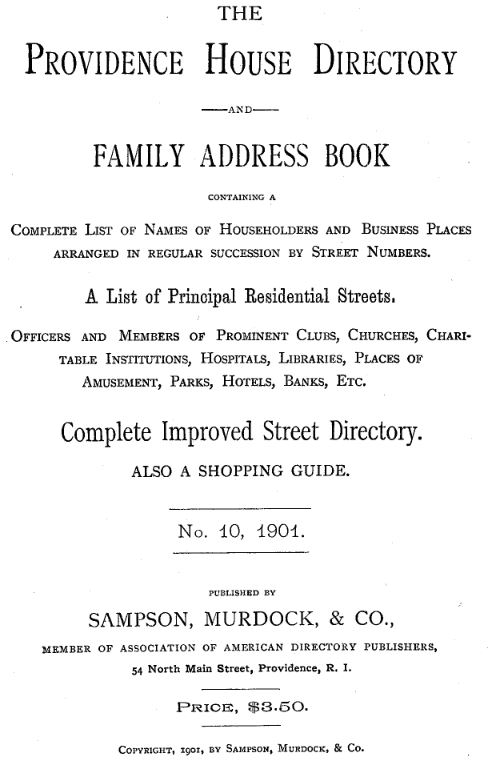
US – GenealogyBank has made a massive new addition to their US digital newspaper collection. Over 450 additional historic newspaper titles have been added to the website. The new additions cover all 50 states and span the years from 1730 to 1900. This has resulted in millions of new obituaries, birth notices and marriage notices going online. Access is by subscription. [GenealogyBank]
Norway – The National Archives of Norway has digitized and put online the records from the silver tax of 1816. This is an unusual record set and one that is worth explaining.
In 1816 the central bank of Norway (Norges Bank) was established. However, the central bank lacked capital. An attempt to raise sufficient funds through a share issuance failed. Thus the king of Norway decided that a special silver tax would be imposed on the citizens. These records can be searched by first name, last name, gender, residence and parish. Access is free. [Norway 1816 Silver Tax Records]
Scotland – The website Deceased Online has begun the process of digitizing and putting online the burial records of some 200 cemeteries in the county of Aberdeenshire. These are cemeteries and burial grounds managed by Aberdeenshire Council. The records from some 20 burial sites have already been completed, with the balance of the records expected to go online over the next couple of months. In total, the collection will number some 600,000 records. The records span the years from 1615 up to 2010. A typical record lists the name of the deceased, occupation, address, date of burial, etc. The link provides the full list of available grave sites. Access is by subscription. [Aberdeenshire Burial Records]
Canada – The website Canadiana.ca has achieved the important milestone of processing some 21 million pages of Canadian historic records. This website chronicles the institutions and people that shaped Canadian history from the 1600s to the mid-1990s.
The non-profit organization behind the website is Canadiana.org. It was originally founded in 1978 to preserve Canada’s print heritage. There are 11 major collections on the website, including one specifically devoted to genealogy and local history and one devoted to the War of 1812. The website can be searched by keyword, collection and date range. Access is free. [Canadiana.ca]
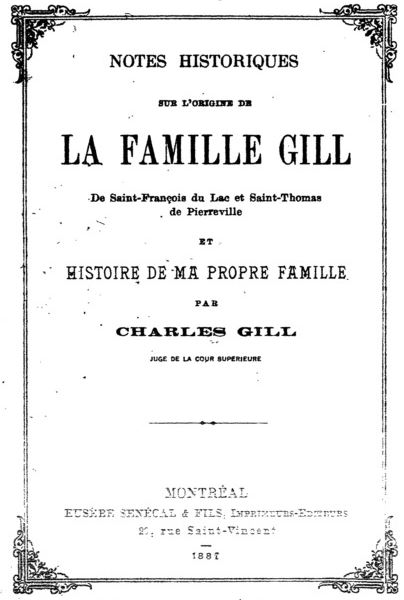
US – Daughters of the American Revolution (DAR) has added an index of over 40,000 digitized family Bible records. Before the days of government birth, marriage and death records, family Bible records remain an important resource for genealogists. The index can be searched for free. [DAR Bible Records]
England – Ancestry has put online an interesting collection of some 11,000 historic Surrey England mental hospital records. These are admission records and span the years from 1867 to 1900. According to Ancestry, one of the shocking things about this collection is the number of patients that were admitted to mental hospitals at the time that were aged ten years or younger.
Each record lists the patient’s name, gender, marital status, occupation, residence, religion and reason for admission. Given the changed nature of the mental health industry, some of the reasons for admission might not be recognizable today. For example giving ‘weak-mindedness’ as a reason for admission is particularly vague. Access to this collection is by subscription. [Historic Surrey Mental Health Records]
England – FindMyPast has added to their collection of Kent parish records. The latest addition consist of 42,000 new baptism records spanning 450 years and 30,000 new burial records also spanning 450 years. With the newest additions, FindMyPast now has over 540,000 Kent baptism records and over 385,000 burial records. These records can be searched by first name, last name, baptism year, father’s first name and mother’s first name. Access is by subscription. [Kent Baptism Records]
England – Ancestry has added a new collection of British Army muster books and pay lists. This new collection spans the years from 1812 to 1817 and consists of over 467,000 records. This might be a good collection to search if you had a relative involved in the Battle of Waterloo in June 1815.
A typical record lists the name, start date, end date, regiment, where stationed, rank and pay of the soldier. It covers cavalry, foot guards and regular infantry regiments. Also included are special regiments, colonial troops, various foreign legions, garrison battalions, veteran battalions and depots. The collection can be searched by first name, last name, keyword and regiment. Access is by subscription. [British Army Muster Books]
May 2015
Australia – FamilySearch.org has started a new browsable image collection of the 1828 census from New South Wales. So far, 2,500 images are in the collection. A sample image is shown below from Botany Bay. The 1828 census lists the name of the family member (including servants), age, class (free or bonded), ship name and year of arrival, sentence (if applicable), employment, residence and religion. If the resident was a farmer, additional information was also collected such as the number of acres and livestock totals.
Two copies of the 1828 New South Wales census were created. One copy was sent to the public records office in England. This is the basis for the copy Ancestry keeps in its collection. The other copy is now resident in the Mitchell Library in Sydney, which is the basis for the FamilySearch version. It is worth consulting both versions since there appears to be slight differences between the two sets (particularly in name spelling).
The images in the FamilySearch collection can be searched by place. Eventually, it will be indexed by name. Access is free. [New South Wales 1828 Census]

Australia – FamilySearch.org has created a new browsable image collection of Tasmanian civil registrations of births. The collection consists of some 12,700 images and spans the years from 1899 to 1912. A typical record (as shown below) gives the name of the child, date of birth and sex. For the father it lists the name, age and birthplace. For the mother it lists the name, maiden name, age, when/where married, place of birth and other children.
The images in this collection are organized by place and then by year. For this collection there is often a long lead time between when the child was born and when it was registered. It is possible that children who died soon after birth were not put in the register in Tasmania during this time period. Access is free. [Historic Tasmanian Birth Records]

Ireland – FindMyPast has put online a collection of 1.5 million records of admission and discharge registers from the Dublin workhouses. These are the workhouses of both the North and South Unions. The records span the years from 1840 to 1919.
A workhouse was an early and rudimentary form of social security. It was essentially a place where a person or a family unable to support themselves were provided with very basic accommodation and often a menial job. Most workhouses were run by local parishes or societies, sometimes with the backing of the local government.
This collection will be of great interest to anyone who had ancestors from Ireland. After the Great Famine of the 1840s, the level of poverty in Ireland (which was already much higher than in England) skyrocketed. As a result, many families at one time or another ended up in a workhouse. These records are from the capital of Dublin, where families gravitated towards from all over the country in search of relief during the potato famine. Also, Dublin was the main point of embarkation for those who left the country en mass starting in the 1840s. Many migrating families heading overseas would have spent some time in these workhouses. As a result, there is a good chance you will be able to find your Irish ancestors in this collection.
A typical record lists the names of family members, age, occupation, religion, illnesses or infirmities, their original parish and the general condition of their clothes and/or cleanliness. A transcript of the record and an image of the original document are included with this collection. The records can be searched by first name, last name, date, gender, occupation and religion. Access is by subscription. [Dublin Workhouse Records]
Also included is a separate record set that provides minutes of meetings of those who ran the Dublin workhouses. Listed are members of staff, contractors and teachers who worked in the poor houses. These records also contain many individual case histories of paupers and abandoned children that were discussed at board meetings. In total, these minute books contain some 900,000 records and can be searched by first name, last name and year. Access is also by subscription. [Dublin Workhouse Minutes]
Canada – Library and Archives Canada (LAC) is making good progress on digitizing their collection of First War military personnel records. Formally known as the Canadian Expeditionary Force Personnel Service Files, these records are being digitized systematically by box number, which roughly corresponds to alphabetical order. So far, LAC has digitized about one quarter of the boxes from A up to the surname Gilbert.
The pace of digitization is much faster than the original rate (as we discussed below last December) thanks in part to renewed emphasis from the new management at LAC. At the current run rate, all the records should be digitized and put online by the end of 2016. Access is free. [Canada WWI Military Records]
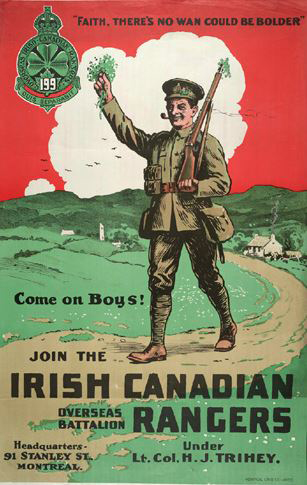
Canada – FamilySearch.org has created a new record collection of Newfoundland vital statics. These are church records of baptisms, marriages and some burials. There are some 192,000 records in the collection, which spans the years from 1753 to 1893. This collection can be searched by first name and last name. Access is free. [Early Newfoundland Vital Records]
Australia – FamilySearch.org has created a new browsable image collection of Tasmanian government gazettes from 1833 to 1925. Government gazettes are a great source of information for genealogists because of the wide breadth of records they contain, as shown in the image below. This particular gazette lists everything from convict lists, to ship arrivals to details on property sales. The collection can be searched by date. Access is free. [Historic Tasmanian Government Gazettes]
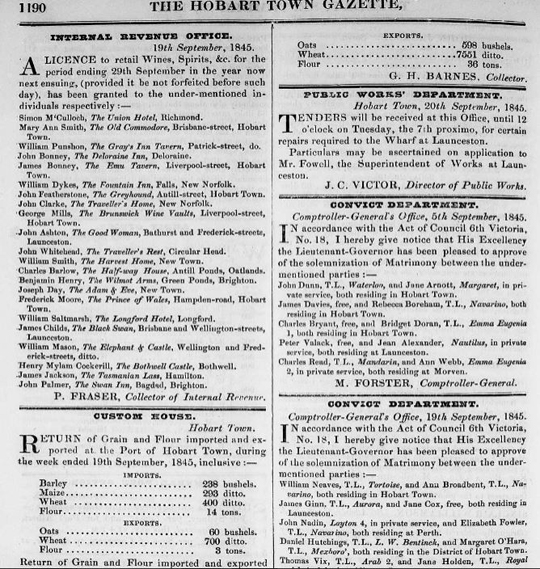
UK – If you think one of your ancestors may have owned a tavern in West Yorkshire, then this record set is for you. Ancestry.co.uk has digitized a unique set of 75,000 West Yorkshire alehouse records dating from 1771 to 1962. These are basically lists of people who were licensed to own taverns in the area. Since 1551, England has kept records of alehouse licenses, but it is rare to see such a collection being digitized and put online. Access is by subscription. [Historic Alehouse Licenses]
Canada – The Ottawa Museums and Archives has started the process of creating a virtual online collection. The collection comes from several regional museums and the city archives. Items in the collection range from photographs to maps to letters to historic artifacts. The first batch of 34,000 records has already gone online. Hopefully, the entire collection will one day go online, which consists of some 3 million photographs alone. Search is by keyword. Access is free. [Ottawa Digital Archives]
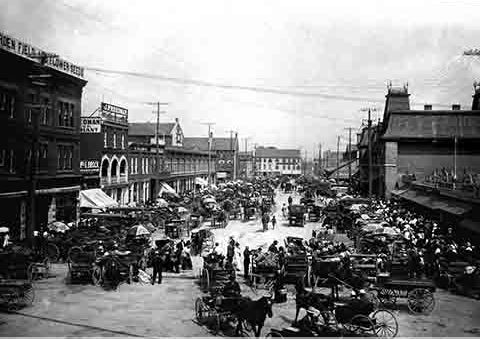
England and Wales – FindMyPast has added a collection of birth, marriage and burial records from The Society of Friends (Quakers). The collection spans the years from 1578 to 1841 and consists of 234,000 birth records, 90,000 marriage records and over 250,000 burial records. Quakers were not baptised into their faith, so no baptism records exist. They were, however, known for their meticulous record keeping so these records should be fairly complete. The records can be searched by a variety of fields, including first name, last name, meeting house, county, etc. Access is by subscription. [Historic English Quaker Birth Records]
Norway – The National Archives of Norway has put online the 1815 census. A bit of background is required. The census was triggered by the union in 1814 of Norway and Sweden. Sweden wanted a statistical survey of the Norwegian economy. Thus, most of the results from this 1815 census are numerical in nature such as how many people lived in a particular village and the general age distribution. However, in some jurisdictions, census preparers made name lists of the inhabitants as an intermediate step towards preparing the statistical census summaries.
It is these so-called nominative or name lists that will be of interest to genealogists. An example is shown below. The lists have been scanned and put online. Some of the lists have even been transcribed and are clearly marked as searchable. These lists can be searched by first name, last name, gender, family position, occupation and year of birth. Access is free. [Norway 1815 Census]
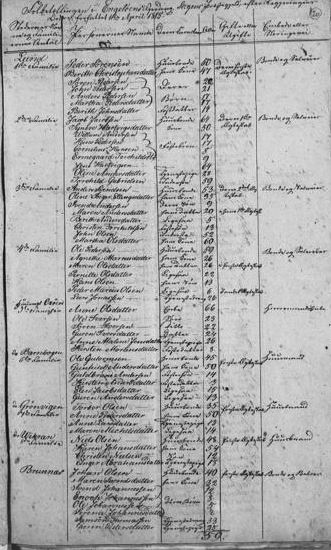
Australia – FindMyPast has put online an index of Queensland wills. The index consists of some 514,000 records spanning the years from 1857 to 1940. The index was compiled from three former Queensland Supreme Court districts: the Northern District (based in Townsville); the Central District (based in Rockhampton) and the Southern District (based in Queensland). The index provides details of not only those who died in Queensland, but also those who registered their wills in Queensland and then lived elsewhere at the time of their death.
Each record includes a transcript of the original files. The index can be searched by first name, last name and district. Access is by subscription. [Queensland Will Index]
Ireland – This is a preannouncement. The National Library of Ireland has announced the date for when their collection of Catholic parish registers will become freely available to the public on a dedicated website. The date will be 8 July 2015. These parish records are the single most important source of Irish family history prior to the 1901 census. They span the years from the 1740s to the 1880s and consist primarily of baptism records and marriage records.
The National Library of Ireland (NLI) has been working to digitize these records for more than three years. It has been the most ambitious digitization program that the library has ever attempted. Genealogists will be interested to know that a typical baptism record in the collection lists the names of the person being baptised, parents, godparents and witnesses.
In the initial phase, the records will not be searchable by name. Instead, they will be searchable by parish location only. At the moment, the NLI does not have the financial resources to transcribe the records.
While you wait for this collection to become available, it would be a good idea to do some advance research to determine the exact historic Catholic parish where your ancestors lived. The best way (really the only good way) to do this is to use Brian Mitchell’s A New Genealogical Atlas of Ireland,
which you can buy from Amazon. This atlas is a key resource for anyone researching their Irish ancestry. Each Irish county is presented in multiple detailed maps: Roman Catholic parishes and dioceses; Church of Ireland parishes and dioceses; townlands; poor law unions and parishes and probate districts. A separate set of maps deals with the nine counties of Northern Ireland and shows the various Presbyterian congregations.
Basically, the atlas shows all the different kinds of historic subdivisions that have occurred in Ireland over the last couple hundred years. This atlas is invaluable for tracing your Irish ancestors.
April 2015
Belgium – FamilySearch.org has indexed an additional 70,000 civil registration records from East Flanders, Belgium. These are birth, marriage and death records from the Belgium National Archives that span the period from 1541 to 1912. These records can be search by first name, last name and type of record. The underlying collection of some 2.8 million images can also be browsed. Access is free. [East Flanders Birth Records]
Canada – FamilySearch.org has indexed an additional 246,000 records from their existing collection of Ontario marriages. This collection spans the years from 1869 to 1927. Although some jurisdictions in Ontario began recording marriages as early as 1801, province-wide registration did not begin until 1 July 1869. Also note that in the 1800s, people who lived near the US border sometimes chose to get married in the United States where marriage requirements could be less strict than in Canada. This collection can be searched by first name and last name. Access is free. [Historic Ontario Marriage Records]
England – Deceased Online has added cemetery and cremation records from the Sandwell Metropolitan Borough, which is near Birmingham in the West Midlands. The new records consist of some 300,000 burials and 130,000 cremations going back as far as 1858. Access is by subscription. [Sandwell Cemetery Records]
England – FamilySearch.org has a new image collection of Derbyshire parish records. This collection spans the years from 1537 to 1918 (basically from the formal start of parish record keeping under King Henry VIII to the end of World War I). The collection consists of some 53,000 images with the usual records on baptisms, marriages/banns and burials. Although some of the images can be searched by first name and last name, it is not clear if the entire collection is currently searchable. To learn more about English parish records, see the article A Date Guide to English Genealogy. Access is free. [Derbyshire Parish Records]
England – FindMyPast has seriously increased their collection of Yorkshire parish records. Over 1.2 million new baptism records from North Riding, East Riding and West Riding are part of the latest update. These records are from the original registers. In addition, 1.3 million new baptism records have also been added from bishop’s transcripts (basically transcribed records from the original parish records - these records were kept at the local bishop’s office). Both sets of baptism records span the years from the 1500s to 1914 (the start of World War I).
In addition, FindMyPast has added about 1.7 million parish marriage/bann records. These are both original parish records and bishop’s transcript records. Finally, there are about 1.8 million parish burial records that have also been added to their Yorkshire parish record collection. The records can be searched by first name, last name, place and year. Access is by subscription. [Yorkshire Parish Records]
South Africa – FamilySearch.org has indexed some 43,000 names in their massive collection of estate files from Orange Free State, South Africa. This collection spans the years from 1951 to 2006. The two items in this collection that will be of particular interest to genealogists are death notices and will records.
A typical death notice (see image below) provides the name of the deceased, date and place of death, place of birth, name of parents, name of spouse and name(s) of children. A typical will record lists the name of the deceased, name of spouse, name of heirs/family members, date and place of the will and the names of witnesses to the will. This collection can be searched by first name and last name. Access is free. [Orange Free State Death Notices]
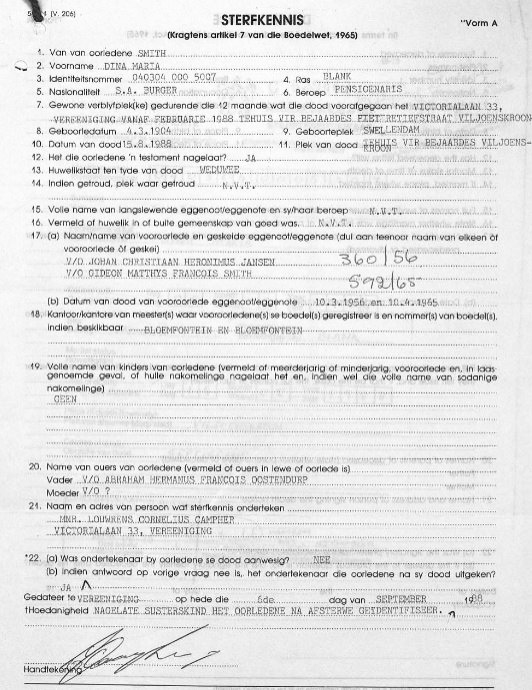
US – FamilySearch.org has added some 700,000 indexed marriage records to their collection of Alabama marriage records. This collection spans the years from 1809 to 1950. To date, some 41% of the collection has been indexed. The collection can be searched by first name and last name. Alternatively, the one million images can also be browsed. Access is free. [Alabama Marriage Records]
US – FamilySearch.org has indexed some 460,000 records from Cascade County, Montana. The collection spans the years from 1880 to 2009 and consists of an incredibly diverse set of records such as probate records (1903 to 1926), court orders for dependent children (1903 to 1937), naturalization records (pre 1945) and land deeds (1880 to 1941). Other types of records in the collection are cemetery records, election records, military records, school records, pension records, voter registration lists, census records, probate records and obituaries. The collection can be searched by first name and last name. Access is free. [Historic Montana Genealogy Records]
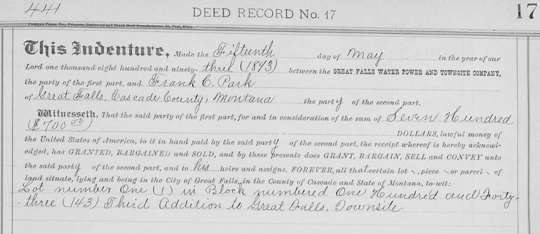
Czech – FamilySearch has put online an intriguing collection of some 66,000 school register images. These images span the years from 1799 to 1953 and come from the Opava State Regional Archive. They cover the Moravia region of the former Czechoslovakia. A typical record in this collection provides the full name of the child, date of birth, place of birth, religion, father’s full name and the place of residence. The records are in Czech and can be searched by district. A typical example is given below. Access is free. [Historic Czech School Records]
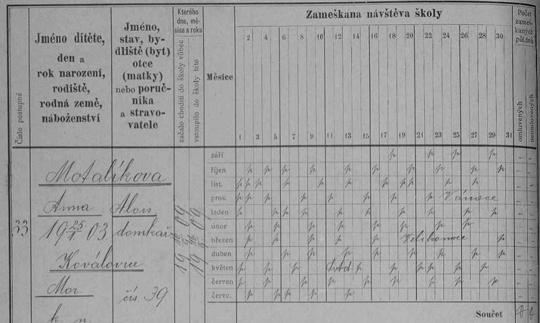
UK – The website TheGenealogist is releasing several new collections this week. First up are 4.66 million World War I medal records. Included are records for the 1914 and 1915 star, the British war medal (1914 to 1920) and the Victory medal (1914 to 1919). TheGenealogist has also added 750,000 new parish records from 22 different counties. Finally, additional tithe maps have been release for more English counties.
A typical map lists the names of the owner and the occupier of lands in addition to details about the amount of land, how it was used and the tithe rent due. Tithe maps are very useful for geographically locating ancestors who lived in the countryside. Access to these new collections is by subscription. [TheGenealogist]
Mexico – FamilySearch has indexed some 411,000 civil registration records from the state of Coahuila, Mexico. These are standard birth, marriage and death records and span the period from 1861 to 1998. The records can be searched by first name and last name. Access is free. [Historic Coahuila Birth Records]
New Zealand – FamilySearch has added another 770,000 images to their collection of New Zealand probate records. This collection spans the years from 1843 to 1998. Some of the records are already indexed and can be searched by first name, last name, probate place and year. Access is free. [New Zealand Probate Records]
Ireland – The birth, marriage and death indexes at IrishGenealogy.ie are now back online and available to search. They had gone offline several months ago (soon after they were put on the internet) over privacy concerns. Birth records over 100 years old, marriage records over 75 years old and death records over 50 years old can now be searched. You need to go through a process of giving your name and agreeing to the fact the search is for genealogical purposes. Note: these are just indexes, not the full digitized image. Access is free. [Ireland Civil Registration Records]
Ireland – The Irish Genealogical Research Society has put online copies of their annual journal The Irish Ancestor. The journal has been published since 1937 and contains hundreds of articles on Irish genealogy. The articles can be searched by family name and first name. See if someone has already published information on your Irish ancestors. Access is free. [Irish Ancestor Journal]
US – The Plainfield Public Library of Plainfield, New Jersey has put online two new resources that will be of interest to genealogists. First is a collection of 75 local city directories that span the years from 1870 to 1982. The early city directories cover Rahway and Plainfield New Jersey, while the most recent directories appear to cover all of Union County.
This is an incredible resource for anyone who wants to track the exact address of their ancestors over many decades. The second resource is a collection of seven different early Plainfield newspapers that span the years from 1868 to 1916. Plainfield was officially incorporated in April 1869, so these two resources cover much of the area’s history. Access is free. [Plainfield City Directories] [Early Plainfield Newspapers]
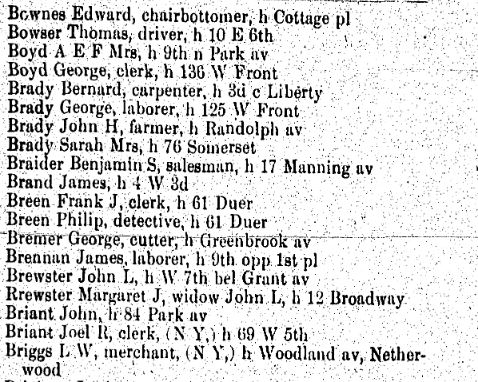
Australia – FindMyPast.com has put online early editions of the government gazette of New South Wales. The collection spans the years from 1832 (the start of the gazette) to 1863. This was the official newspaper of record for the state government. It was used as a means of communication between the government and the general public. It recorded a broad spectrum of community matters such as land sales, court notices, petitions, licenses, contracts, police activity, etc.
The gazette also contains a considerable amount of detailed information on convicts. For example, the 1833 gazette provides lists of all male convicts, when they arrived in the colony, ship name, occupation and convict number. Records on government employees are also prominent in the gazette. There are some 1.2 million original transcripts in the collection. The collection can be searched by first name, last name and year. Access is by subscription. [New South Wales Government Gazette]
UK – FamilySearch has put online some 10 million records from Westminster rate books. A rate book was essentially a property tax book. In the early days, these books were prepared by local parishes, which were responsible for maintaining roads, sewers, lighting, etc. This collection covers the period from 1634 to 1900 from the city of Westminster (now an inner borough of central London). A typical record lists the head of household, the owner, the street address and the rate owed. The collection can be searched by first and last name. Since this collection comes from FindMyPast, the original image can only be viewed at a family history center. Access is free. [Westminster Rate Books]
UK – Harvard University has begun a multi-year project to put online their collection of early English manor rolls. These are court rolls, account rolls and other documents from various English manors. They range in date from 1282 to 1770. The largest collection comes from Cheshire, with additional rolls from Hampshire, Sussex, Staffordshire and Suffolk. At the moment, this collection is not searchable. Access is free. [Early English Manor Rolls]
US – FamilySearch has indexed some 1.3 million additional Texas marriage records. The records span the years from 1837 to 1977. They can be searched by first name and last name. This collection currently covers 183 out of 254 counties in Texas. A typical record lists the name of the bride and groom, date of marriage and who officiated at the marriage, as shown below. Access is free. [Historic Texas Marriage Records]

Ireland – The Irish Newspaper Archives has added 7 new historic newspaper titles from County Kerry in the south-west region of Ireland. The newspapers span the years from 1828 to 1920. Access is by subscription. [Historic Kerry Newspapers]
March 2015
UK – FindMyPast has put online patient records from Bethlem Royal Hospital in London. Some 248,000 records dating from 1683 to 1932 are in this new collection. Many include photographs and detailed descriptions of the inmates’ lives. Bethlem is one of the oldest hospitals in the world dedicated to the treatment of mental illness. Access is by subscription. [Bethlem Inmate Records]
Scotland – The website ScotlandsPeople has added the 1865 Valuation Roll to their collection. It consists of some 1.3 million names. Valuation rolls are basically a list of property owners, tenants and occupiers across Scotland. With this new addition, valuation rolls from 1865 to 1925 are now available on the website. Access is available by subscription. [Scotland 1865 Valuation Roll]
US – The Archives of Michigan has announced that Michigan death certificates from 1921 to 1939 will now be available for free on their website Seeking Michigan. [Michigan Death Certificates]
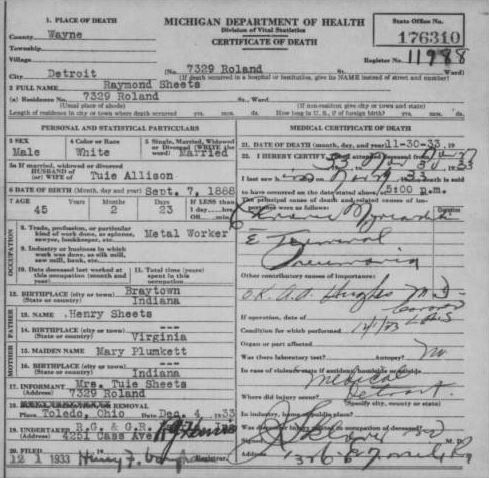
Puerto Rico – FamilySearch has indexed some 4.8 million civil registration records from Puerto Rico. The records span the years from 1805 to 2001 and consist primarily of birth, marriage and death records. Civil registration in Puerto Rico began in 1885. The records prior to this date are from the few municipalities that began civil registration before 1885. The records can be searched by first name and last name. Access is free. [Historic Puerto Rico Birth Records]
US – The Polish Genealogical Society of Connecticut and the Northeast has posted on their website a Polish-American marriage database. The database contains the names of couples of Polish origin who were married in select locations in the Northeast United States. The information for the database was collected from a variety of sources, such as marriage records, newspaper announcements and parish records. The time period generally covered by the database is 1892 to 1940. The database is organized by state and then alphabetically by last name. Access is free. [US Polish Marriage Records] We have already indexed this database with the Genealogy Search Engine.
UK – Deceased Online have added records from two more cemeteries from Nottingham (Rock cemetery and Basford cemetery). This brings to five the number of cemeteries with online records from the Nottingham City Council. A typical record provides a digital scan of the original burial and grave registers and a map indicating the location of the grave. Access is by subscription. [Nottingham Cemetery Records]
February 2015
UK/Ireland – The British Newspaper Archive has hit a major milestone. With the latest uploads, it just added its 10 millionth historic newspaper page this week. The website originally launched in November 2011 with 4 million pages. Since then, it has added major historic newspapers such as the Daily Mirror and the Sunday Mirror from 1914 to 1918 to provide some fascinating news, photographs and illustrations from World War One. In addition, 58 new Irish newspapers have recently been added to the collection, bringing the total count of Irish newspapers now online to 65. Going forward, digitization efforts will focus on putting online pages from the World War Two period from across the UK. Access is by subscription. [British Newspaper Archive]
UK – TheGenealogist has added a very interesting collection of detailed town and parish maps for Middlesex, Surrey, Buckinghamshire and Leicestershire. These maps (combined with TheGenealogist’s existing databases) make it possible to search more than 11 million records and pinpoint the exact location of a residence as shown in the image below.
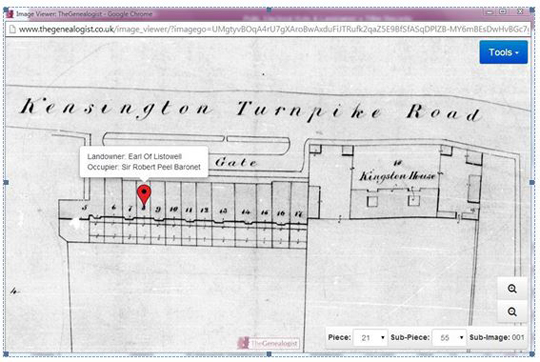
The maps show the boundaries of fields, woods, roads, and rivers in addition to the location and shape of buildings. Details within each record often list how much land was owned or occupied, the exact location of the parish and if the land was rented then the amount of the tithe. With this first release, there are over 12,000 maps. Other counties will be added shortly. Access is by subscription. [Historic UK Parish Maps]
New Zealand – Ancestry.com.au has added some 1.6 million cemetery records. These records span the years from 1800 to 2007 and come from a collection created by the New Zealand Society of Genealogists. It currently contains records from some 1350 to 1400 cemeteries and funeral directors. The collection can be searched by first name, last name, year and location. Access is by subscription. [[New Zealand Cemetery Records]
US – FamilySearch has created a new browsable image collection of Freedmen’s Bureau records. The collection consists of some 72,000 images that are mainly letters received by the bureau. The images are organized by date and by author of the letter. Not all of the records are asking for relief/assistance, as shown in the example below. Access is free. [Freedman’s Bureau Letters]
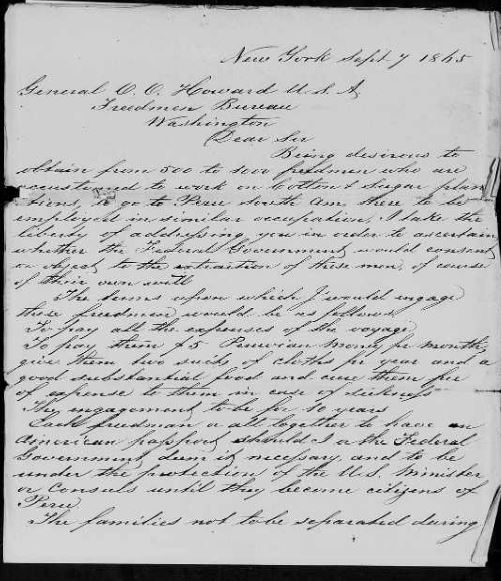
US – Ancestry has created a collection of California occupation licenses, registers and directories for the years 1876 to 1969. The collection, which consists of some 850,000 records, contains documents pertaining to attorneys and those in the medical field (doctors, dentists, physicians, surgeons, pharmacists, etc.). Details vary depending on the type of document, but can include information such as name, residence, date of birth, photo, licensing date and medical school. The collection can be searched by first name, last name, date, place and keyword. Access is by subscription. [Historic California Medical Licenses]
US – The San Mateo County Genealogical Society of California has put online over 57,000 indexed and scanned obituaries from the region. The obituaries come from a variety of local newspapers. San Mateo covers most of the San Francisco peninsula south of San Francisco down to the northern end of Silicon Valley. Access to the collection is free. [San Mateo Obituaries]
Denmark – MyHeritage has put online the entire 1930 Danish census. This consists of some 3.5 million records. These records are part of a new partnership MyHeritage has with the National Archives of Denmark. The plan is to index and digitize all the available Danish census records from 1787 to 1930. The 1930 census is the first tranche to go online. The balance of the records will be released during 2015 and 2016.
In addition to all the Danish census records, MyHeritage will also be putting online Danish parish records from 1646 to 1915. In total, some 120 million Danish records will go online over the next two years. This is good news for anyone with Danish ancestors. Access to the records is by subscription. [Denmark 1930 Census]
Sweden – MyHeritage has put online some 22 million records from the Swedish Household Examination Rolls spanning the years from 1880 to 1920. The total collection for these years consists of some 54 million records, meaning about 40% of the records are now online. The balance of the records in the collection is scheduled to go online by the end of June 2015. The records can be searched by first name, last name, year of birth, place and by keyword. Access is by subscription. [Sweden Household Examination Rolls]
Ireland – The Irish Genealogical Research Society has launched a new collection called the Early Irish Birth Index. The collection holds over 5,000 records containing more than 10,000 names of alternative sources for births in Ireland. These alternative sources range from early Irish census records, to registry of deeds memorials to newspaper listings to gravestone inscriptions to diaries and letters. This new collection complements the existing Early Irish Marriage Index containing ancestral information for the period from 1660 to 1863 (i.e. prior to civil registration beginning in 1864). The new collection can be searched free of charge. Access to the full index data is limited to IGRS members. [Early Irish Birth Index]
US – The Rochester (New York) Genealogical Society (RGS) has digitized and put online a number of historical church and town records from the region. The information is contained in some 200,000 pages of scanned documents. The church records can be browsed by individual church. Access is free. [Rochester Genealogy Records]
RGS also maintains another website containing some 70,000 baptism, marriage and death records. These records can be searched by name. Access is free. [Rochester Baptism Records]. Finally, the City of Rochester also has a web site with 170,000 indexed marriages from 1876 to 1943, with complete information available for the pre-1910 records. It is free to search. There is a charge to order the marriage license. [Rochester Marriage Records]
US – FamilySearch.org has indexed another 1.4 million records from their collection of New York City passenger lists from 1820 to 1891. These records can be searched by first and last name. Access is free. [New York City Passenger Lists] Since most of these records are associated with Ellis Island, it would be worthwhile reading the article Ellis Island Immigration Records to get the most out of this collection.
Germany – Ancestry has added birth, marriage and death records from Mannheim, Germany. The 152,000 birth records span the time period from 1870 to 1900. The 137,000 marriage records are from 1870 to 1920 and the 234,000 death records are from 1870 to 1950. Access is by subscription. [Mannheim Birth Records]
World – MyHeritage has announced another milestone in their partnership with FamilySearch. MyHeritage has added to their website the family tree profiles submitted by more than 22 million FamilySearch users. This is in addition to the 27 million family tree profiles already on the MyHeritage website. This combines together two of the world’s three largest family tree collections (the other large collection is held by Ancestry).
According to Dennis Brimhall, CEO of FamilySearch “Partnerships are a major focus in FamilySearch’s strategy to increase family history discoveries for more people. We value our strategic partnership with MyHeritage and appreciate their global reach and contribution to technology in the family history space. We believe this integration is paramount to the greater good of the community....” Access is by subscription. [MyHeritage.com]
Belgium – FamilySearch.org has put online a large number of images of civil registration records from Belgium. The largest new addition is some 800,000 images from Limburg (1798 to 1906). Other regions with new additions include Antwerp (1588 to 1909), Hainaut (1600 to 1913) and West Flanders (1582 to 1910). These are primarily birth, marriage and death records as well as some marriage proclamation records. These records come from the Belgium National Archives. Records can be searched by first and last name. Access is free. [Historic Limburg Birth Records]
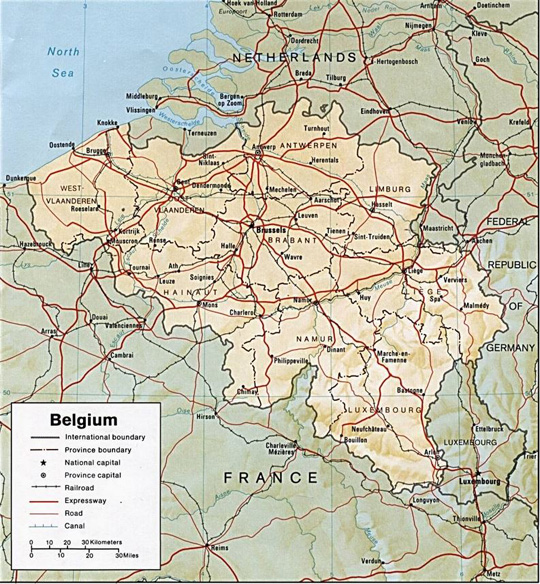
France – Gallica, the website of the National Library of France has put online the Fichier Laborde collection. This collection is basically a listing of Parisian artists and crafts people dating from the 1500s to the 1700s. The books were prepared by the Marquis Léon de Laborde, an early genealogist whose personal hobby seems to have been to write out the names and details of all the artists and crafts people that he found in parish baptism, marriage and death records from the period. It is an important list because many of the underlying parish records were subsequently destroyed when the Paris city hall burnt down in 1871. A sample of a listing is shown in the image below. Access is free. [Fichier Laborde]
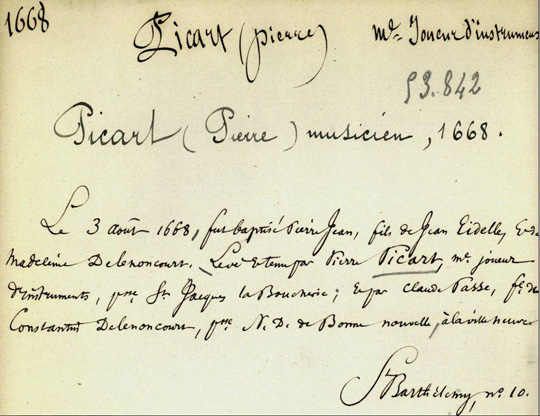
US – The General Land Office of Texas has digitized and put online a collection of early Texas maps. Known as the Frank and Carol Holcomb Map Collection, it consists of rare maps of Texas and the southwest United States that date back as far as 1513. The maps can be downloaded for a fee from the website Save Texas History. [Early Texas Maps]
Czech Republic – The State Regional Archives in Prague has published an updated map identifying which Roman Catholic parishes have parish books digitized and put online. Currently, the archives are digitizing one or two books a month. The map will be a useful tool to alert you to when the parish books that interest you go online. Access is free. [Czech State Regional Archives]
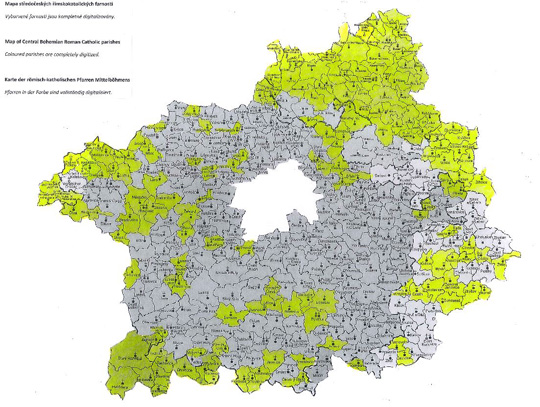
Canada – The Archives of Ontario has digitized and put online some 4,100 patent plans for the province. These are basically Crown land records. You can start your search by typing in the name of a township or town. Access is free. [Ontario Patent Plans]
Canada – FamilySearch.org has put online browsable image collections of the Newfoundland 1921, 1935 and 1945 censuses. The images are organized by district. A typical record (using the 1935 census as an example) lists the name of the person, age, place of birth, gender, marital status, relationship to the head of the household, place of birth of mother and father, religion and occupation. At the time of these three censuses, Newfoundland was not part of Canada. Access to these collections is free. [Newfoundland 1921 Census] [Newfoundland 1935 Census] [Newfoundland 1945 Census]
January 2015
Australia – FindMyPast has added a collection of Tasmanian birth, marriage and death records. The collection starts in 1803 and runs to 1899 for marriages and 1933 for births and deaths. There are some 211,000 birth records, 111,000 marriage records and 102,000 death records. The amount of information available varies depending on the type of record and when the record was registered.
In general, newer records contain more information. For example, on death records after 1908 the deceased person’s spouse was listed (or if single, the parents’ names). These records can be searched by first and last name, year and place. Access is by subscription. [Tasmania Birth Marriage Death Records]
Canada – It looks like Library and Archives Canada (LAC) is accelerating the pace at which new records come online. This week, LAC has put online 152 historic city directories for the cities of Hamilton (1853 to 1895), Kingston (1865 to 1906) and London (1875 to 1899) and farm directories for most of the counties in southwestern Ontario (1864 to 1898). At GenealogyInTime Magazine, we know a fair bit about these records because we have a substantial personal collection of these books.
Farm directories in particular require some explanation. A sample image from an Ontario farm directory is shown below. Ontario is one of the few jurisdictions in the world that had this type of directory, thanks to the Union Publishing Company. They are a great way to track your rural Ontario ancestors during the 1850 to 1900 time period.
For these farm directories, in the countryside it lists the name of each farmer and the location of their farm (by concession and lot number). It also listed whether the farmer owned the land (f=freehold) or rented (t=tenant). It also usually lists the nearest post office for each farmer. This gives you a rough idea of the nearest village in case you are not familiar with the concession/lot system in the area.
For residents of towns and villages in the region, it lists each business person and trades person in the village plus their occupation/trade. Farmers who had retired to the villages were usually not listed.

For the city directories of Hamilton, Kingston and London, most directories list the name, occupation and street address of each household. The earliest directories tended to list only businesses and trades people since these people were the primary audiences for these directories. The later directories were more inclusive.
If you start to see occupations such as labourer or retired or widow listed then you know the directory was fairly inclusive. Some names in early Ontario directories are bolded. These are thought to be businesses and business people that paid to be listed in the directory, nothing more.
With these new additions, LAC has more than doubled the number of historic city directories that they have put online. Access is free. [Canada City Directories]
City directories usually abbreviated common first names, address identifiers such as street or road and occupations in an attempt to cram more names onto a single page. Often these abbreviations are not very intuitive. Fortunately, we have some useful resources that can help you interpret city directory listings, such as a List of First Name Abbreviations, City Directory Abbreviations and a List of Occupation Abbreviations.
US – GenealogyBank has added 8 million more records to their US newspaper and obituary collection. The new additions come from 52 newspaper titles spanning 18 different states. Most of the new additions seem to be from small town newspapers. The link provides the complete list. Access is by subscription. [Historic US Newspapers]
US – The Troy Irish Genealogy Society continues to add new cemetery records to their website. The latest addition is St. John’s Cemetery in Albany New York. These interment records span the years from 1841 to 1887. This is one of the oldest Catholic cemeteries in Albany. At one time, it was thought the records from this cemetery had been lost. The website provides all the details. Access is free. [Albany New York Cemetery Records]
UK – The website TheGenealogist has significantly expanded their War Memorials photo database. This brings the total to some 179,000 records. These are essentially photographs of various war memorials throughout the country that have been photographed and transcribed. They tend to cover everything from the Boer War in 1901 to more modern day conflicts. Access is by subscription. [UK War Memorial Transcriptions]
Iceland – Ancestry.co.uk has put online the Iceland censuses for 1870, 1880 and 1890. These records come from the National Archives of Iceland. Please note that it appears information from some counties in the 1870 census was lost a long time ago. These collections can be searched by first and last name and location. Access is by subscription. [Iceland 1870 to 1890 Census Records]
Portugal – The website Tombo.pt maintains a complete list of new ancestral records for Portugal when they become available on over 20+ different Portuguese government websites. If you have ancestors from Portugal, then this is the website to check. The year 2015 has started off with several new collections of parish books going online. Check it out. [Tombo.pt]
Ireland – FindMyPast has released a new collection called Ireland, Poverty Relief Loans 1824-1871. These are historic records of short-term micro loans made to the “industrious poor” such as fishermen or tenant farmers. The collection consists of scans of ledger books identifying the details of the loans. Each loan was signed by the individual receiving the loan and two guarantors, who were often neighbours or close relatives. There are some 700,000 records in this collection. It can be searched by first and last name, year and place.
This is the first time this record collection has gone online. It is an incredibly important collection because it deals with the working poor. These are people who were too poor to be listed in street directories, but not poor enough to get listed in a poor relief record. Access to the collection is by subscription. [Ireland Working Poor Records]

Ireland – FindMyPast has added 1.1 million new articles to their Irish newspaper collection. This month, ten new titles were added (4 from Dublin, 3 from Munster, 2 from Connaught and 1 from Ulster). The collection now stands at 5.3 million articles across 60 different titles and spanning the years from 1749 to 1900. Access is by subscription. [Ireland Newspaper Collection]
Europe – A new website has launched called Prisoners of the First World War from the ICRC Archives. During WWI, some 10 million people were captured and sent to detention camps. This included both servicemen and many civilians. This website contains various records and reports that would be of interest to genealogists. Included are such things as cards on prisoners of war and reports of deaths and injuries at detention camps. These records cover several armies, including British (and the Commonwealth), French, Belgian, German, Romanian, Serbian, Italian, Russian, Portuguese, Greek, American, Austro-Hungarian, Bulgarian and Turkish.
This website will be interesting for anyone who had an ancestor who was a prisoner of war in WWI. It will be particularly useful if your ancestor came from a country that generally lacks genealogy records, such as Serbia or Bulgaria. The records can be searched by name. The objective is to put some 5 million records online. The website has already reached 90% of its target. The YouTube video below gives a good overview of the website. Access is free. [Records of Prisoners of the First World War]
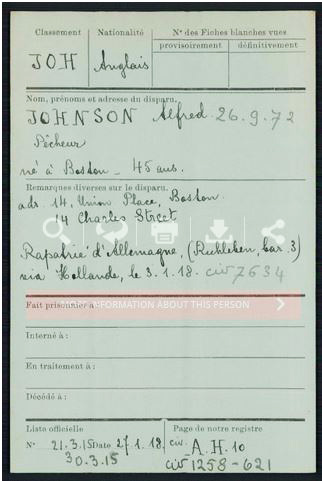
US – A new genealogy website has launched called Mapping the Freedmen’s Bureau – An Interactive Research Guide. It is designed to assist people in finding Freedmen’s Bureau records. Many of these records are online, but are scattered across the internet. This new website helps direct researchers to the available resources.
The Bureau of Refugees, Freedmen and Abandoned Lands (or Freedmen’s Bureau in short) was a federal government agency set up after the end of the US Civil War to aid freed slaves. The Bureau’s job was to help solve many of the everyday issues encountered by newly freed slaves. This would include such things as obtaining clothing, food, water, health care and jobs. The Bureau generated a considerable number of records that can now be used by genealogists.
The new website was created by Angela Walton-Raji and Toni Carrier. It has several interactive maps that researchers can use to determine what records are available near their area of interest. If the records are online, the map provides the appropriate links. The maps list the Freedmen’s Bureau field offices, contraband camps, Freedmen’s Bureau hospitals, Freedman’s Savings Bank branches and locations of United States Colored Troops (USCT) battles. Access is free. [Mapping the Freedmen’s Bureau]
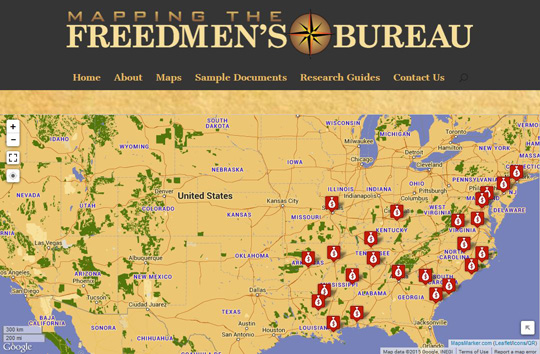
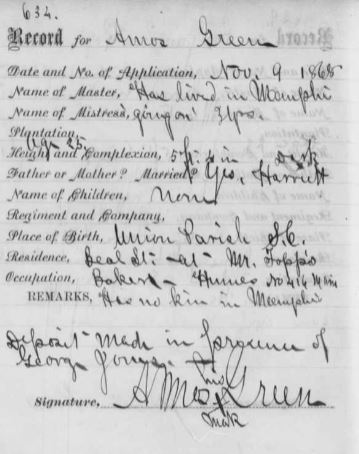
England – The website TheGenealogist has put online over 800,000 First World War records associated with British soldiers who were killed in action or missing in action. These lists are very useful to consult especially since the status of many soldiers changed during the war. For example, soldiers that were initially reported as killed in action sometimes had their status later changed to wounded or prisoner of war. Access to this collection is by subscription. [World War I Killed in Action Records]
England – FindMyPast has put online a collection of Nottinghamshire parish records. These records were transcribed by members of the Nottinghamshire Family History Society. Included are some 850,000 baptism records (1538 to 1980), some 690,000 marriage records (1528 to 1929) and over 240,000 burial records (1539 to 1905). These records are from the Church of England and can be searched by first name, last name and place. The baptism records can also be searched by the parents’ names. Access is by subscription. [Nottinghamshire Parish Records]
Ireland – The website RootsIreland has uploaded some 217,000 Roman Catholic parish records from County Carlow. These are primarily baptism and marriage records that go back as far as the 1700s for some parishes and up to 1899 for all parishes. The records can be searched by first name, last name and year. Access is by subscription. [Carlow County Genealogy Records]
South Africa – Ancestry.co.uk has put online voter indexes from South Africa. These indexes date from 1719 to 1996 and contain some 220,000 names. The information contained in each index is fairly extensive and lists the voter's name, residence, name of spouse, occupation, employer, gender, race, maiden name, date of birth and sometimes even the number of pigs owned. The indexes can be searched by first name, middle name, last name and location. Access is by subscription. [South Africa Voter Lists]

